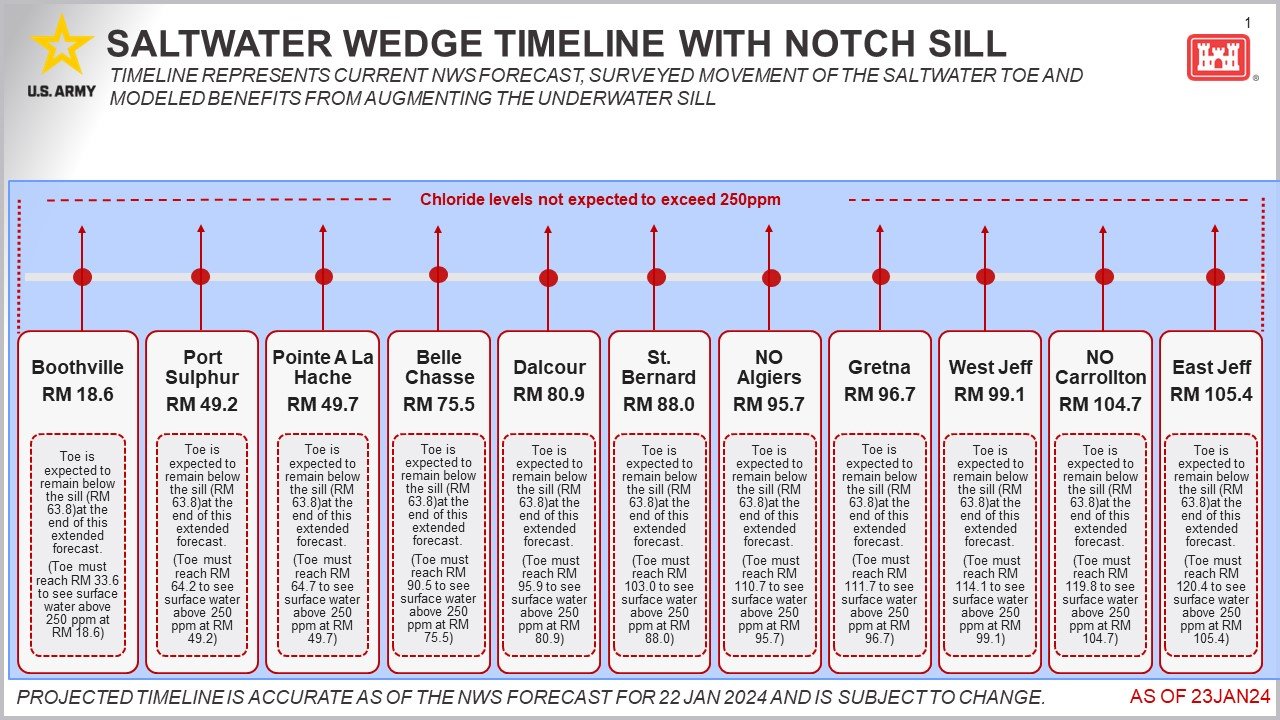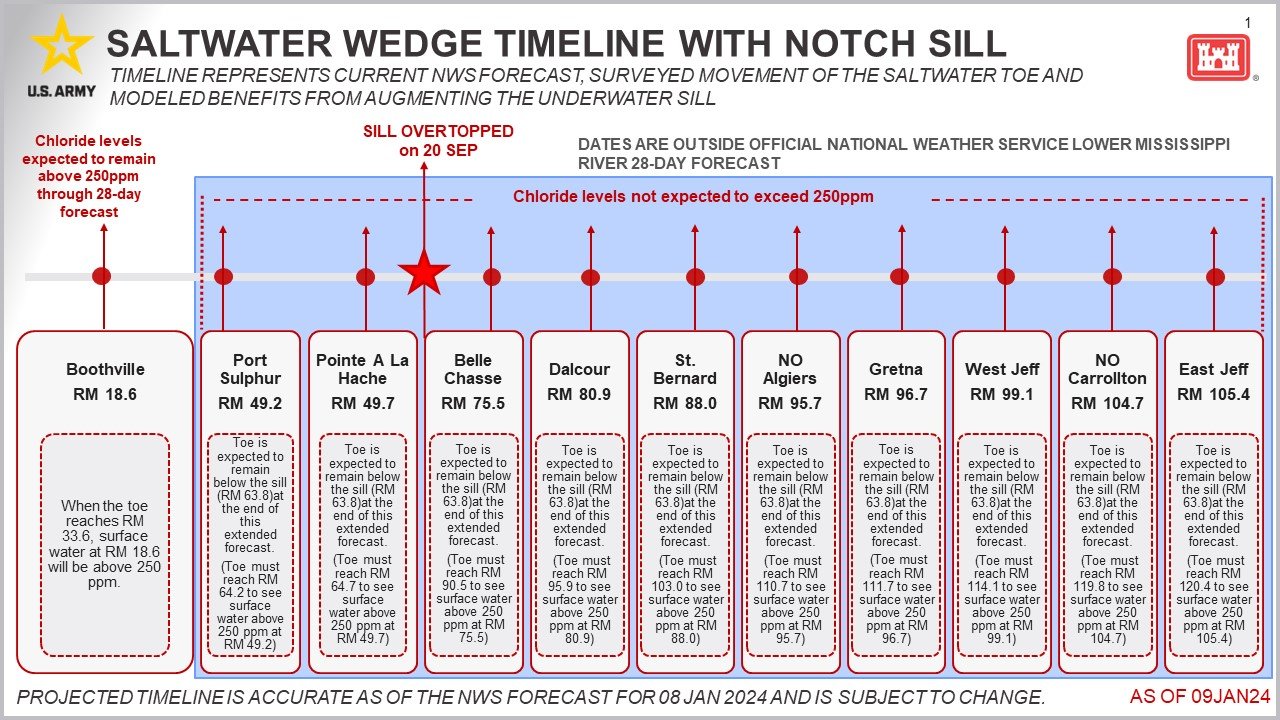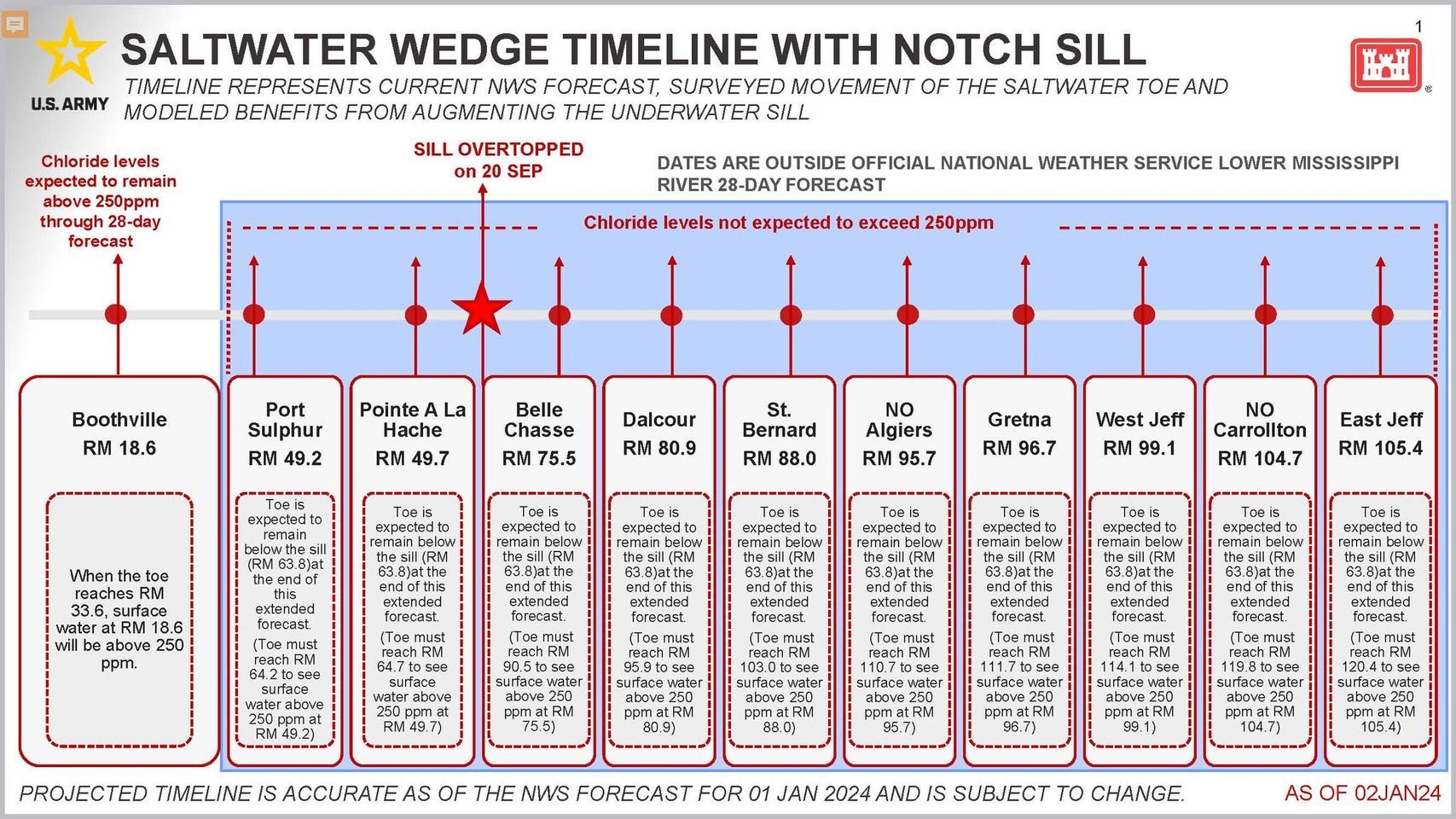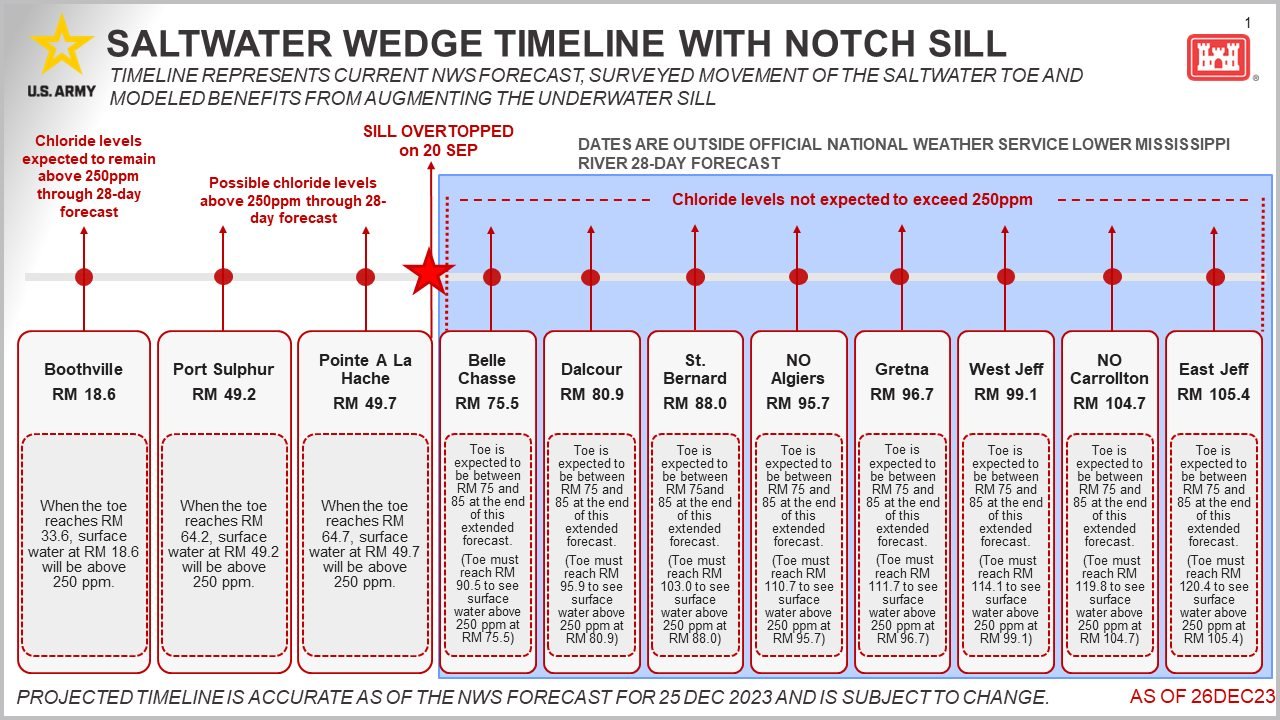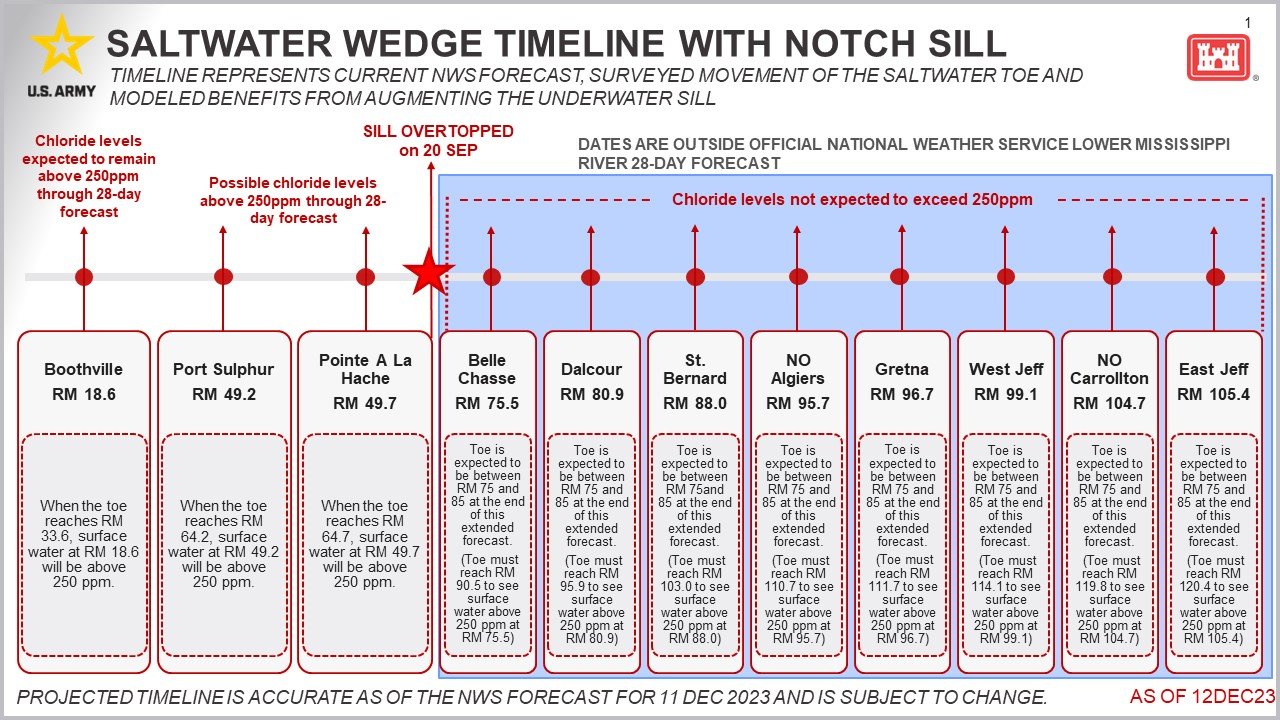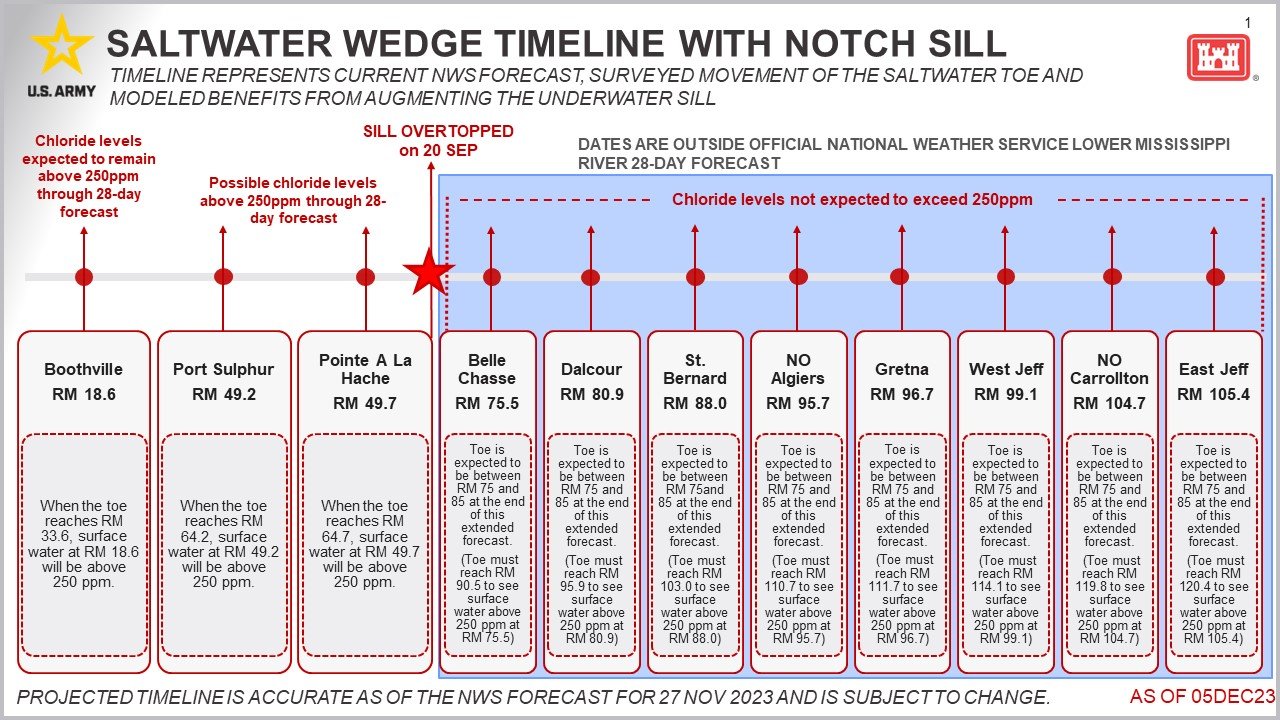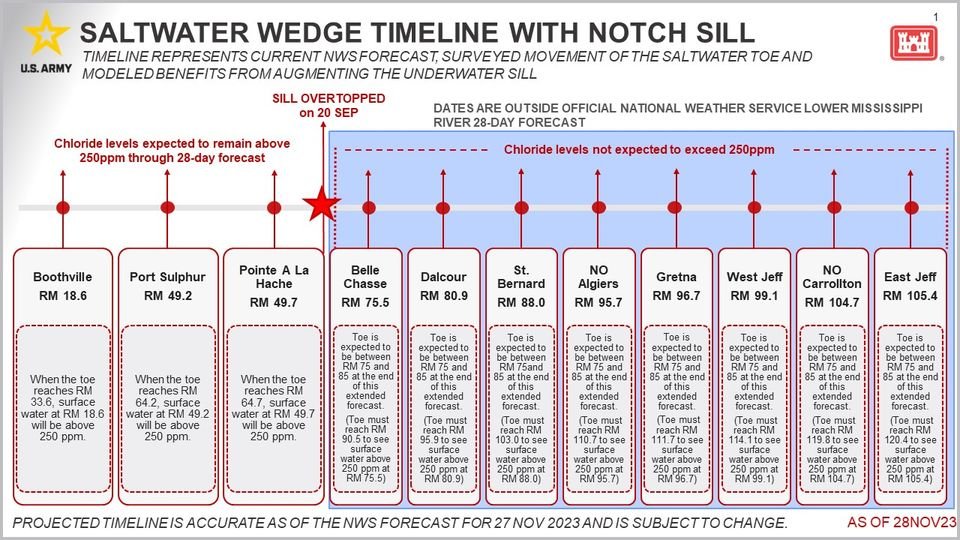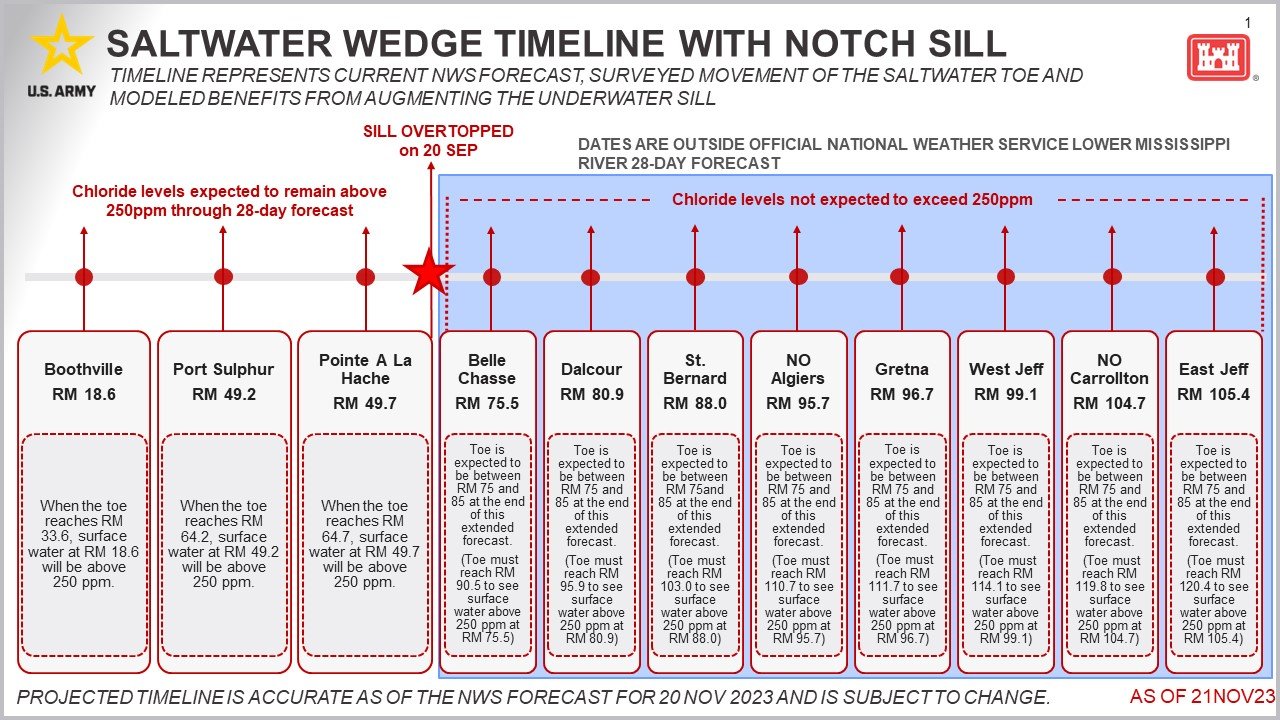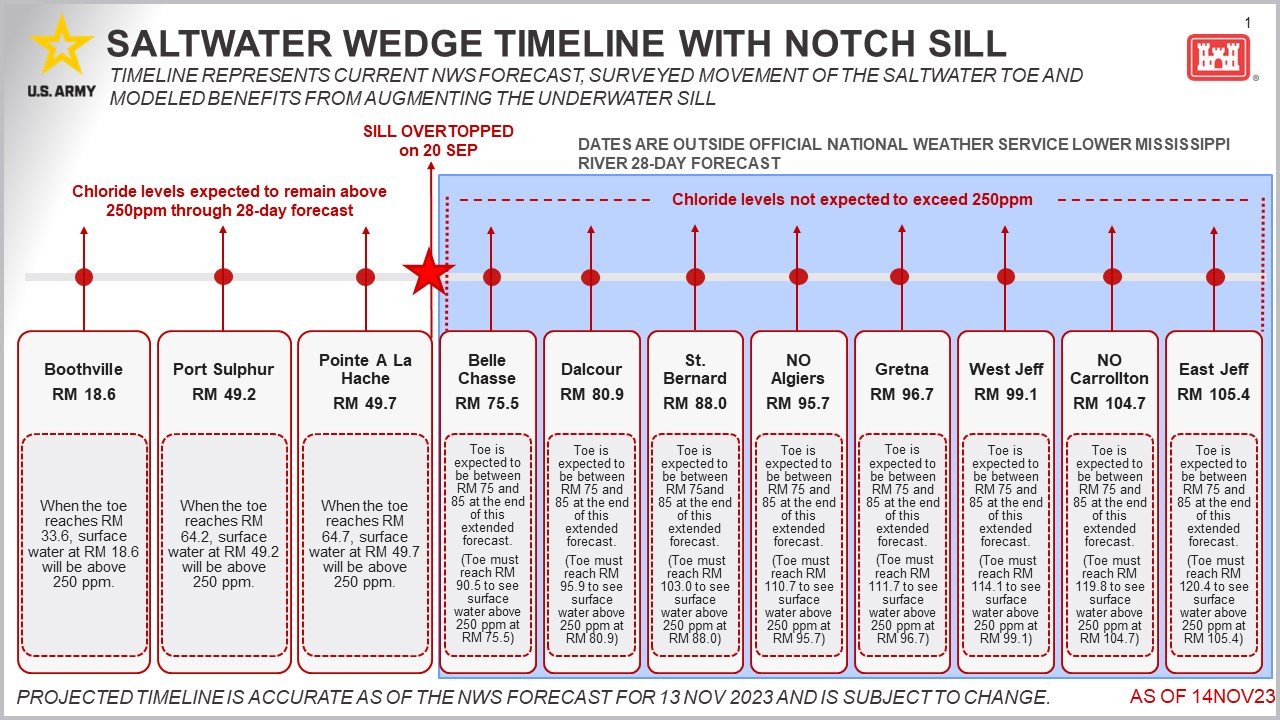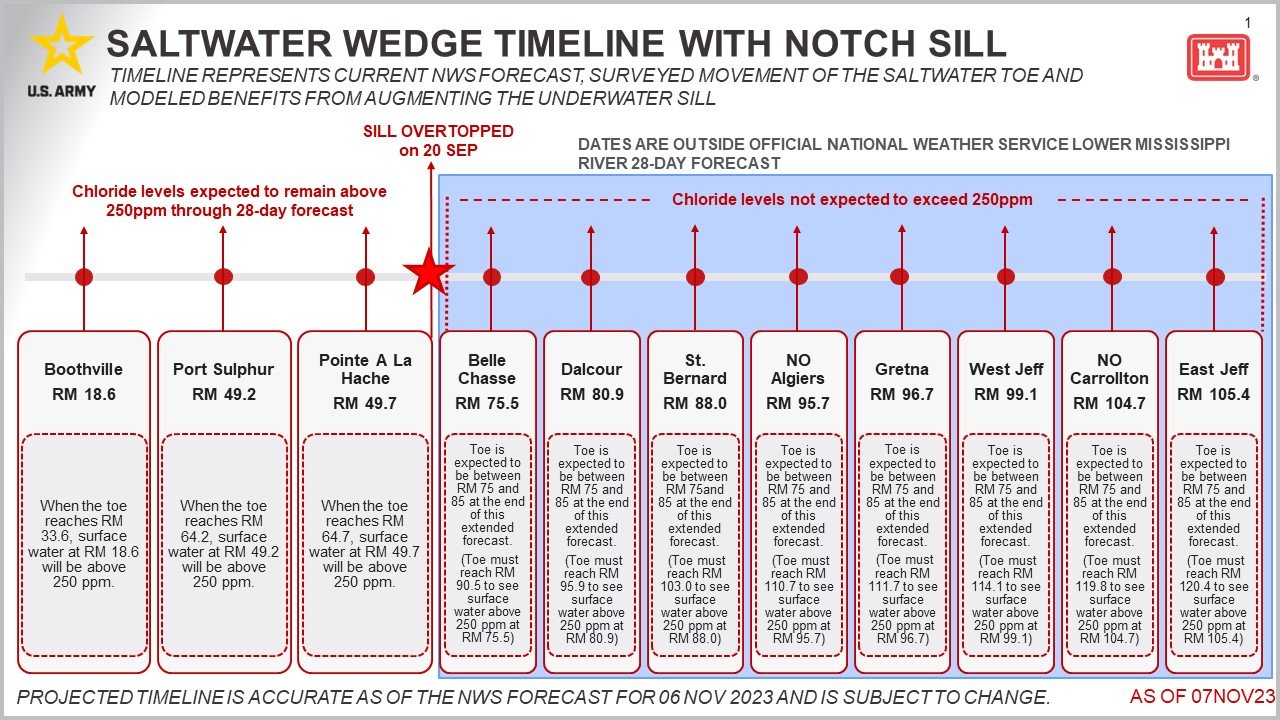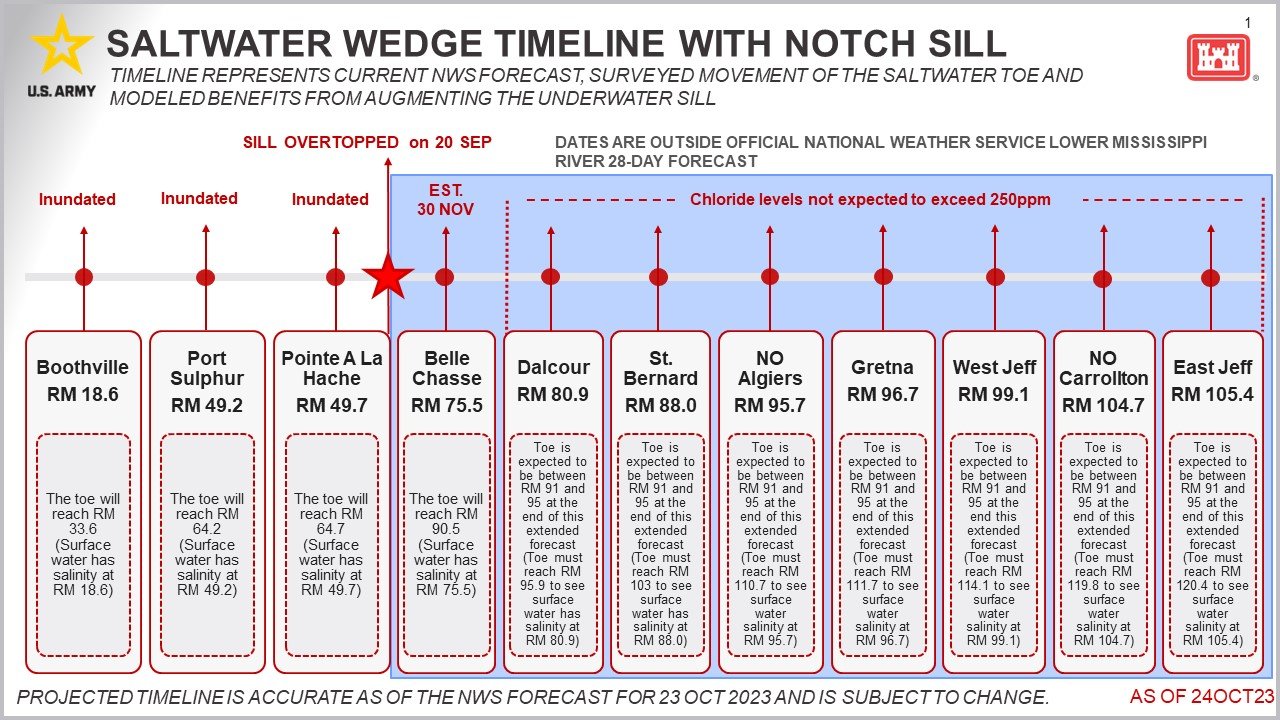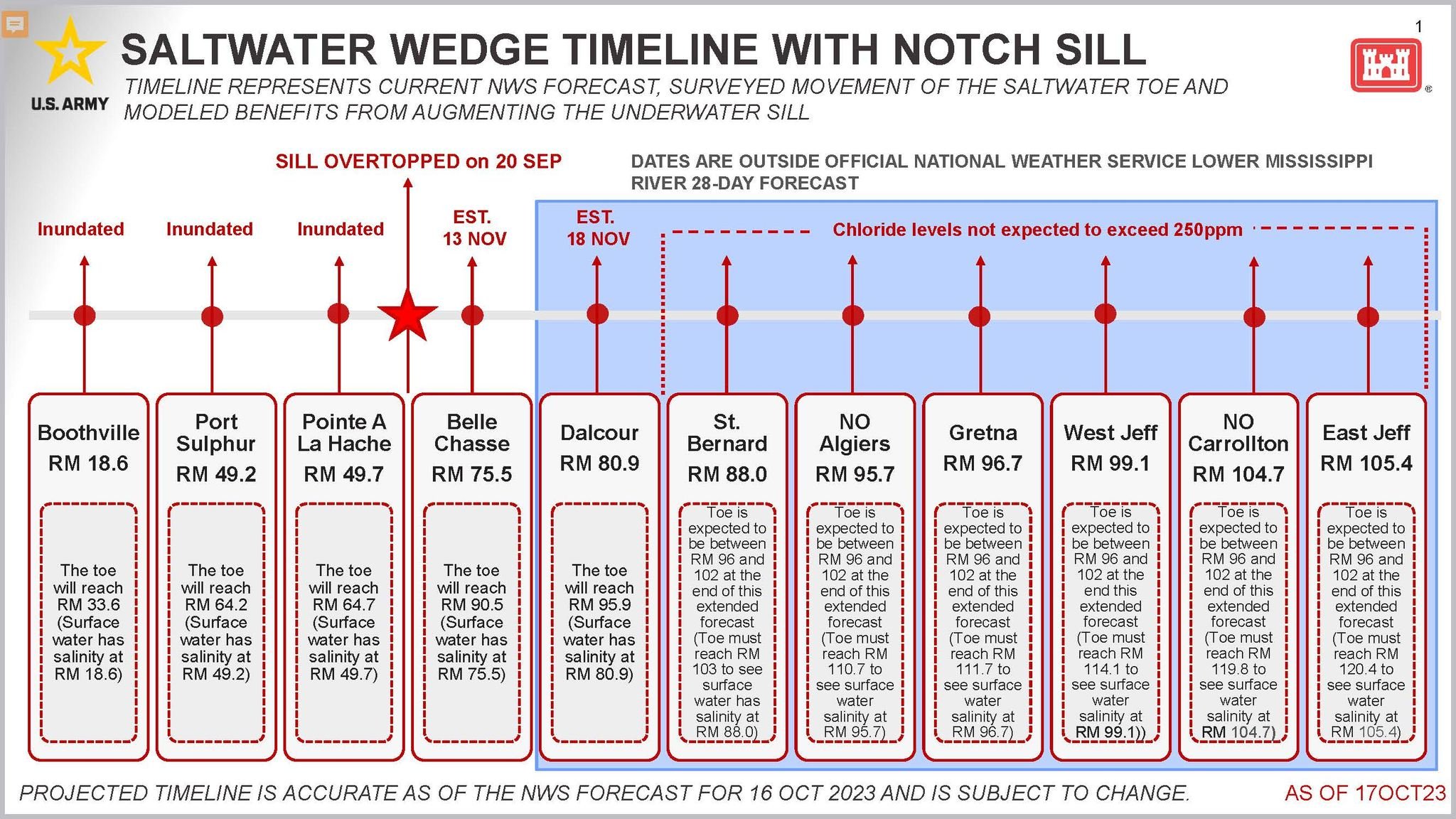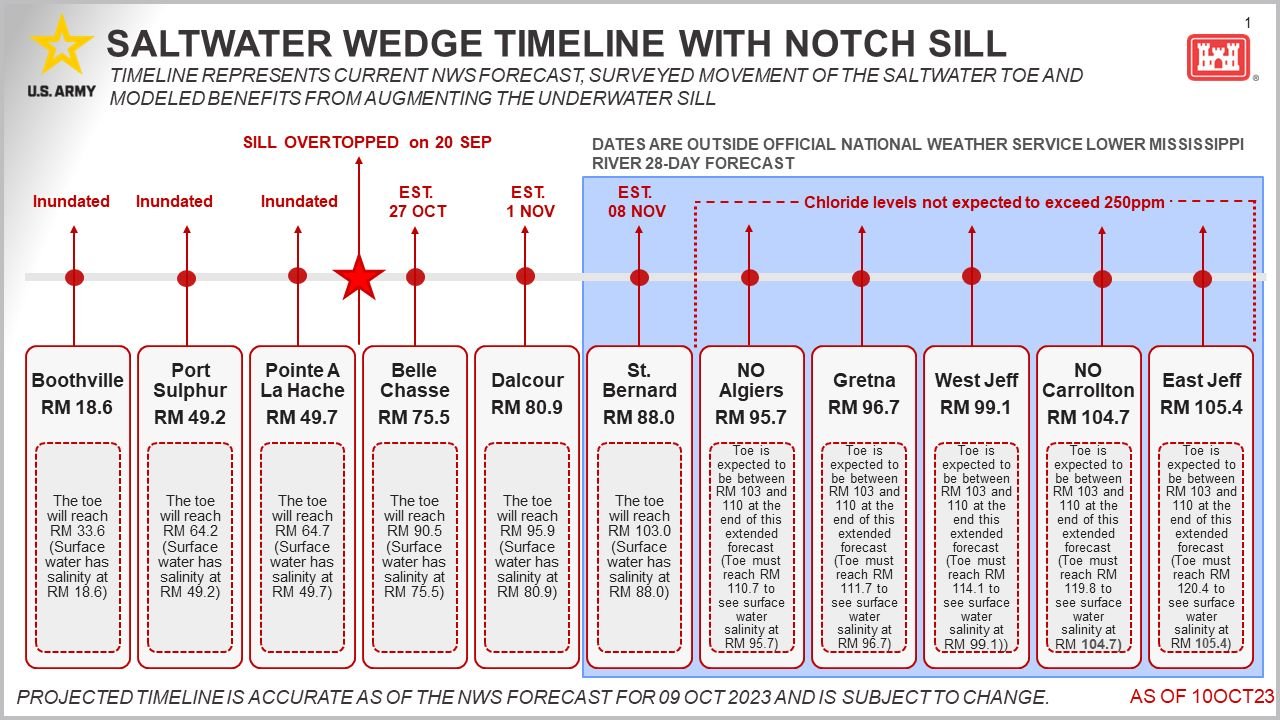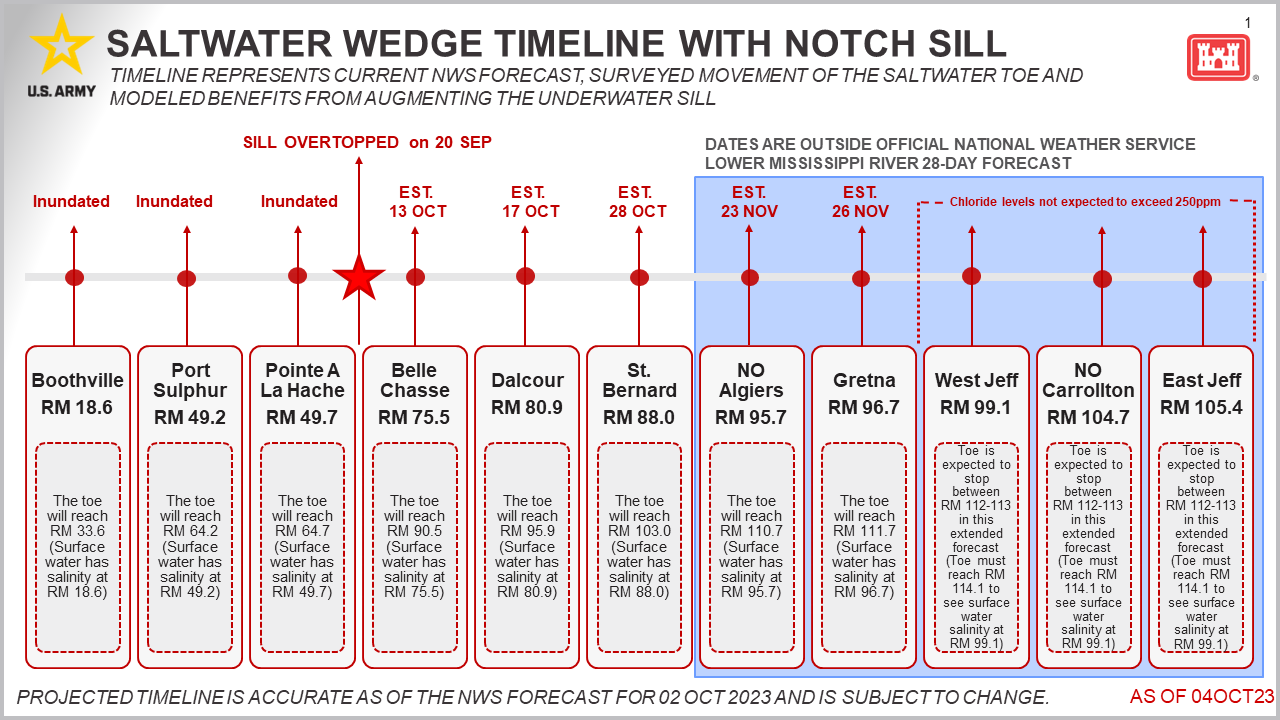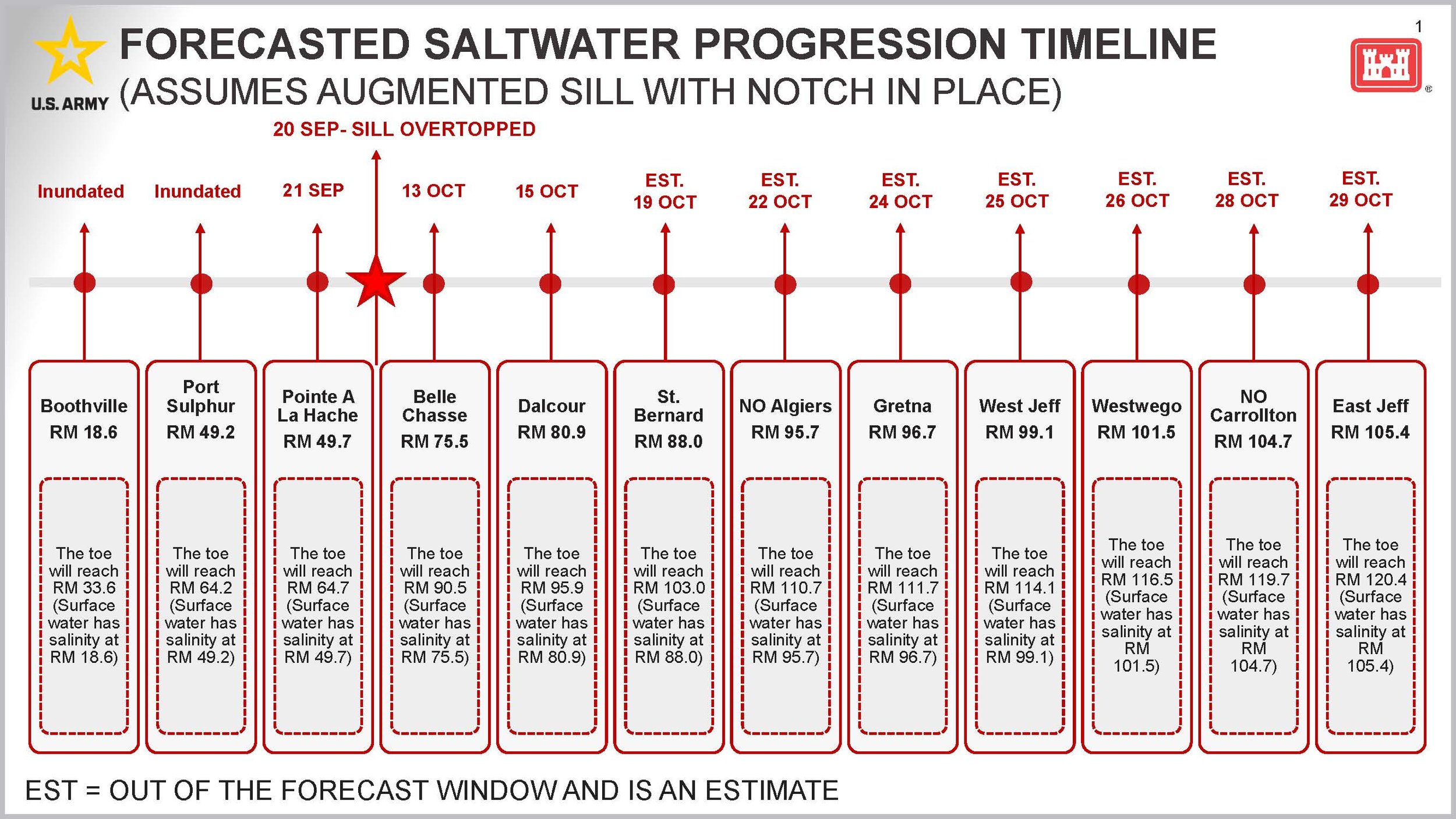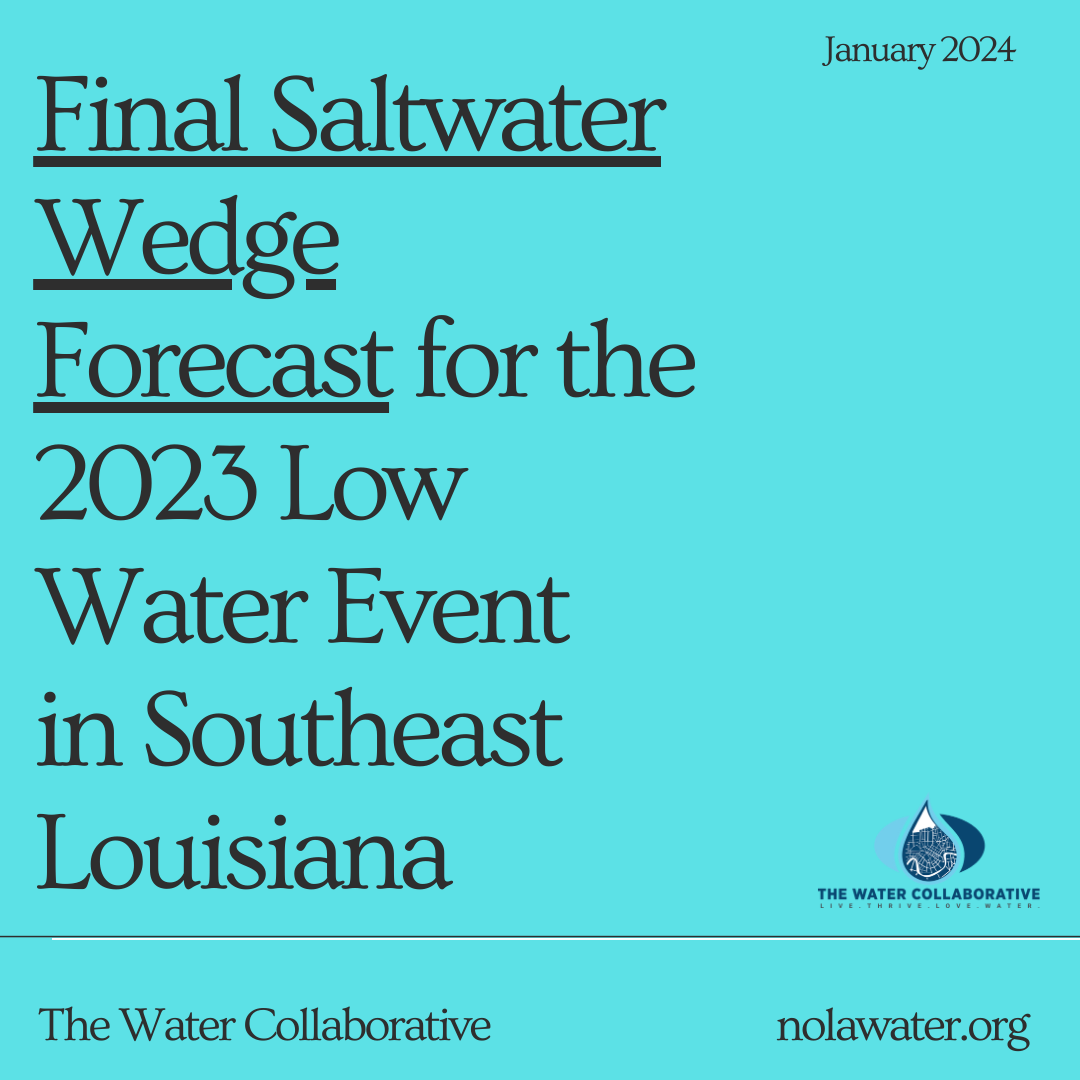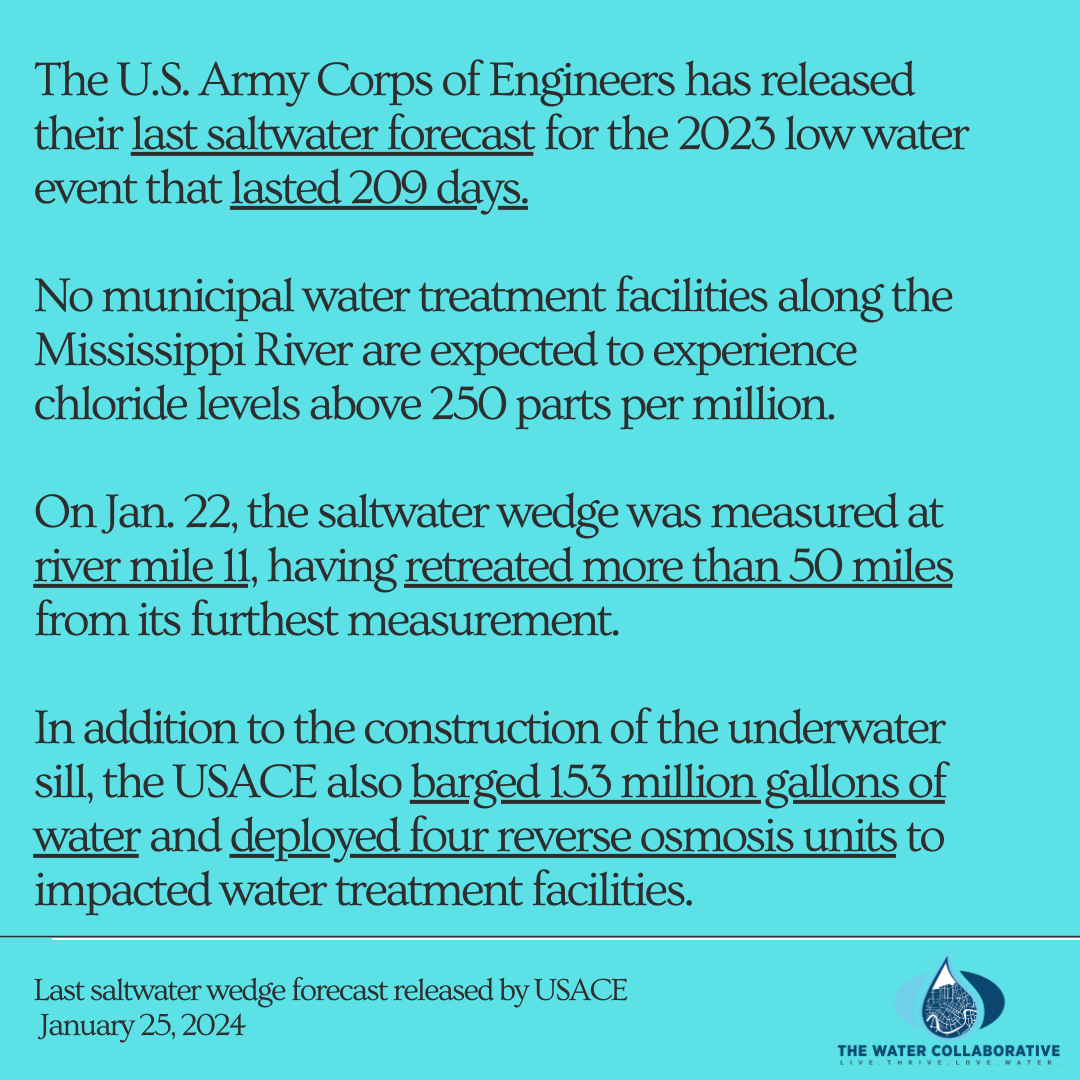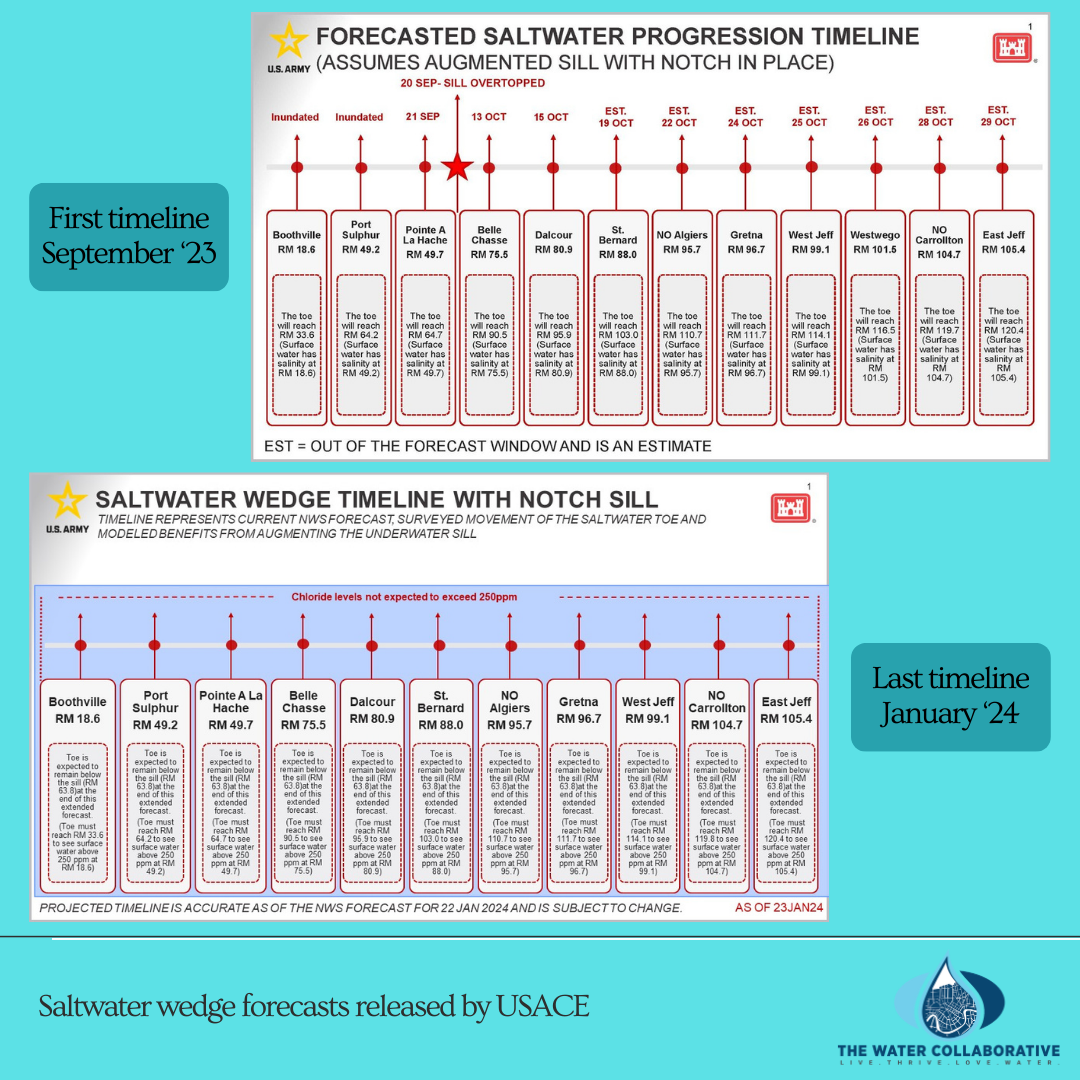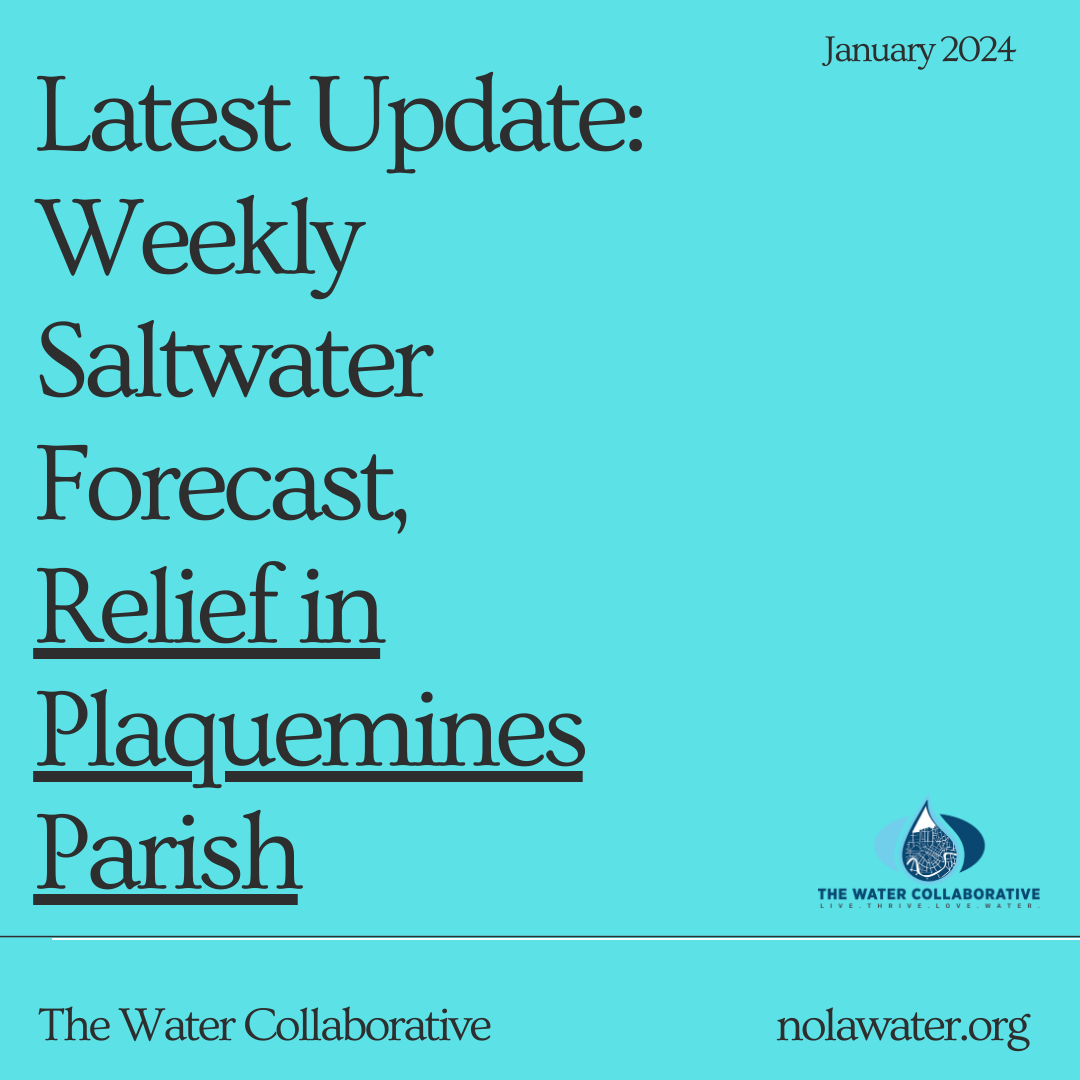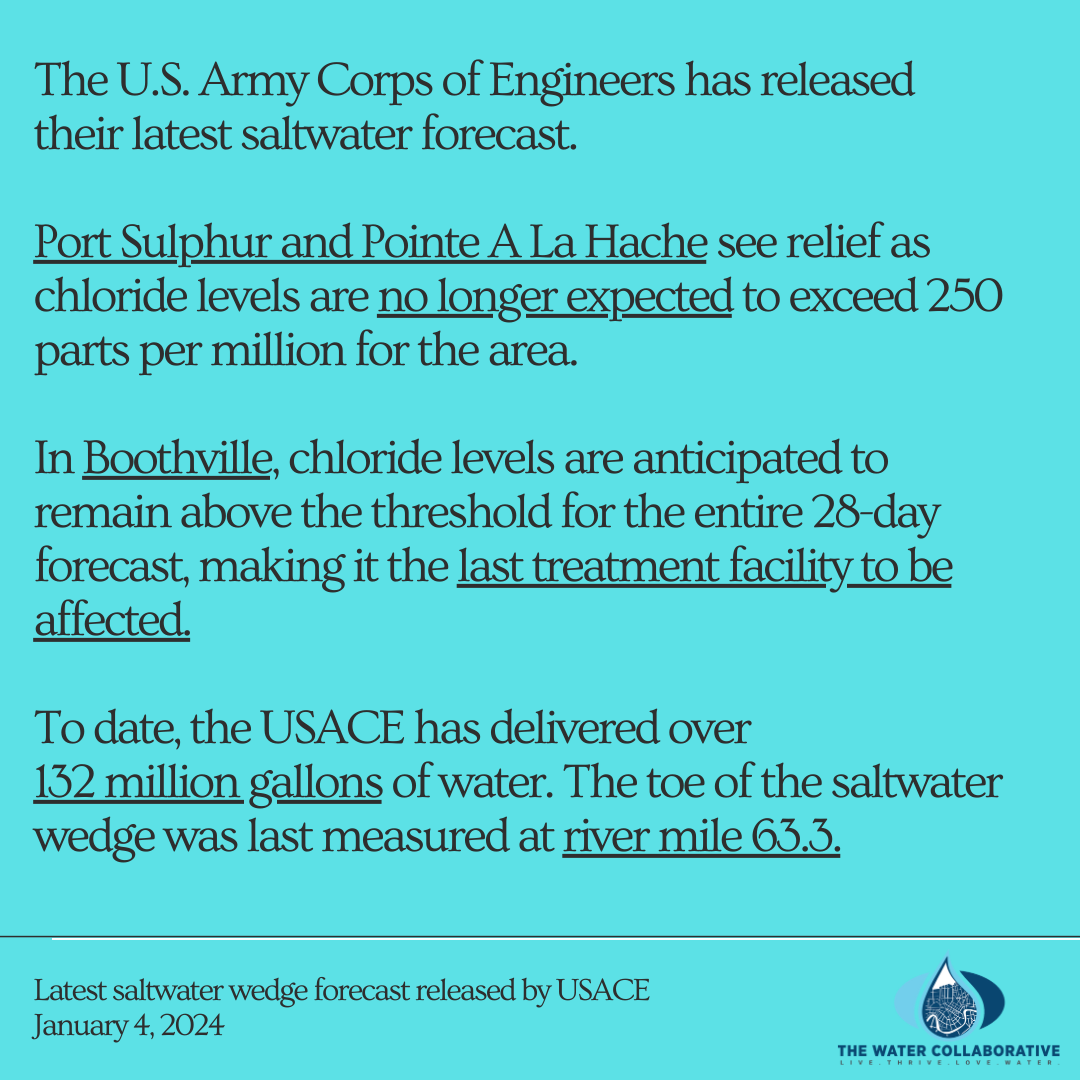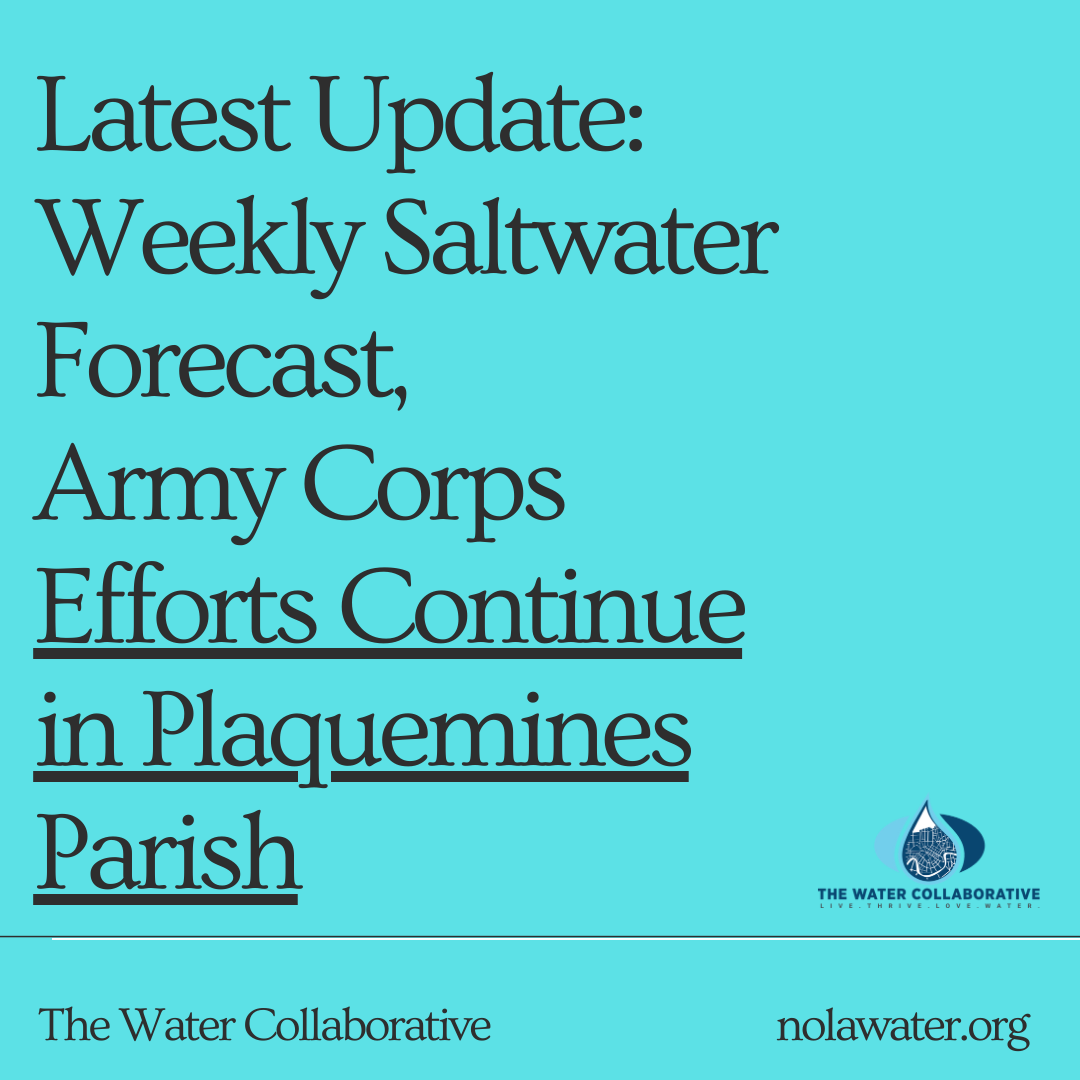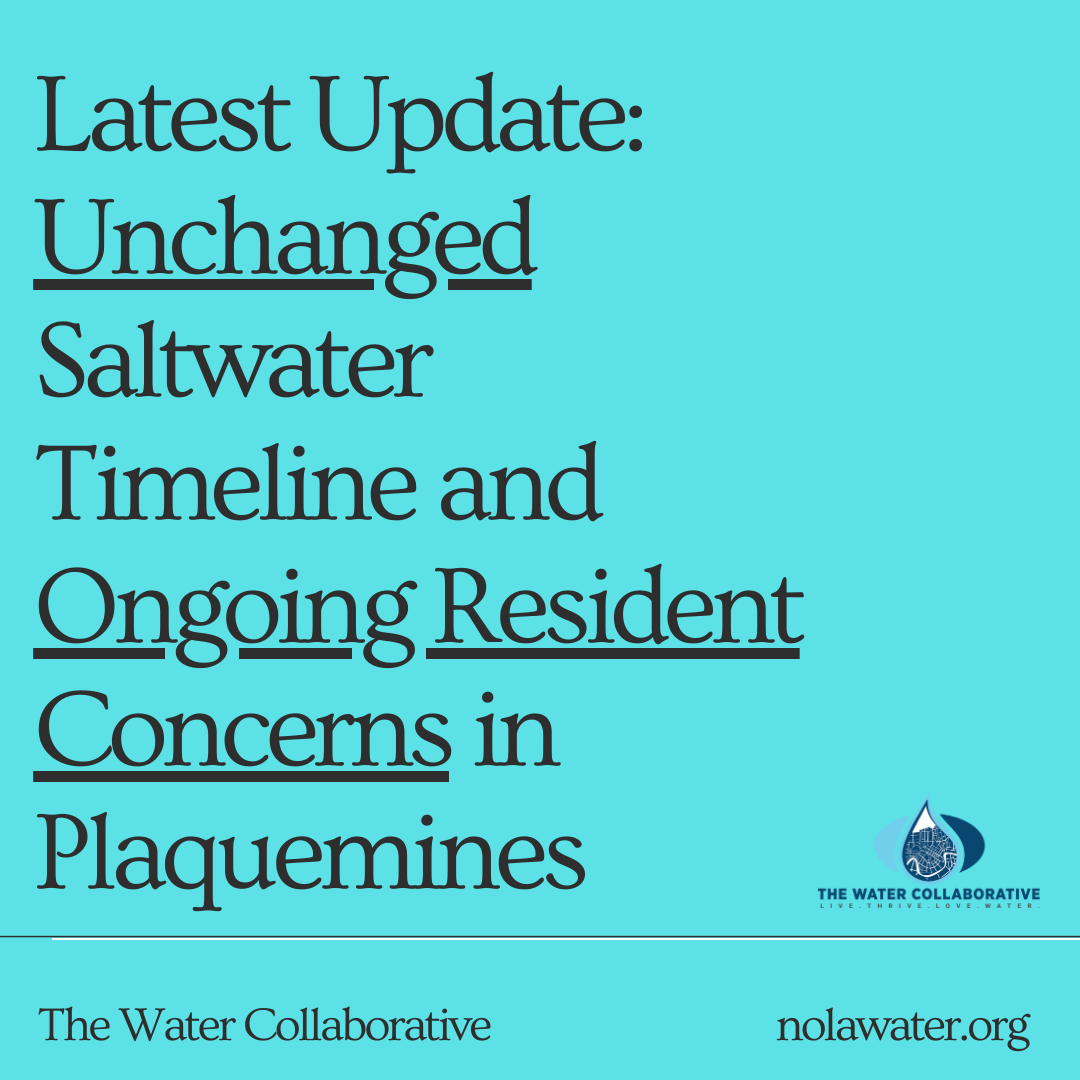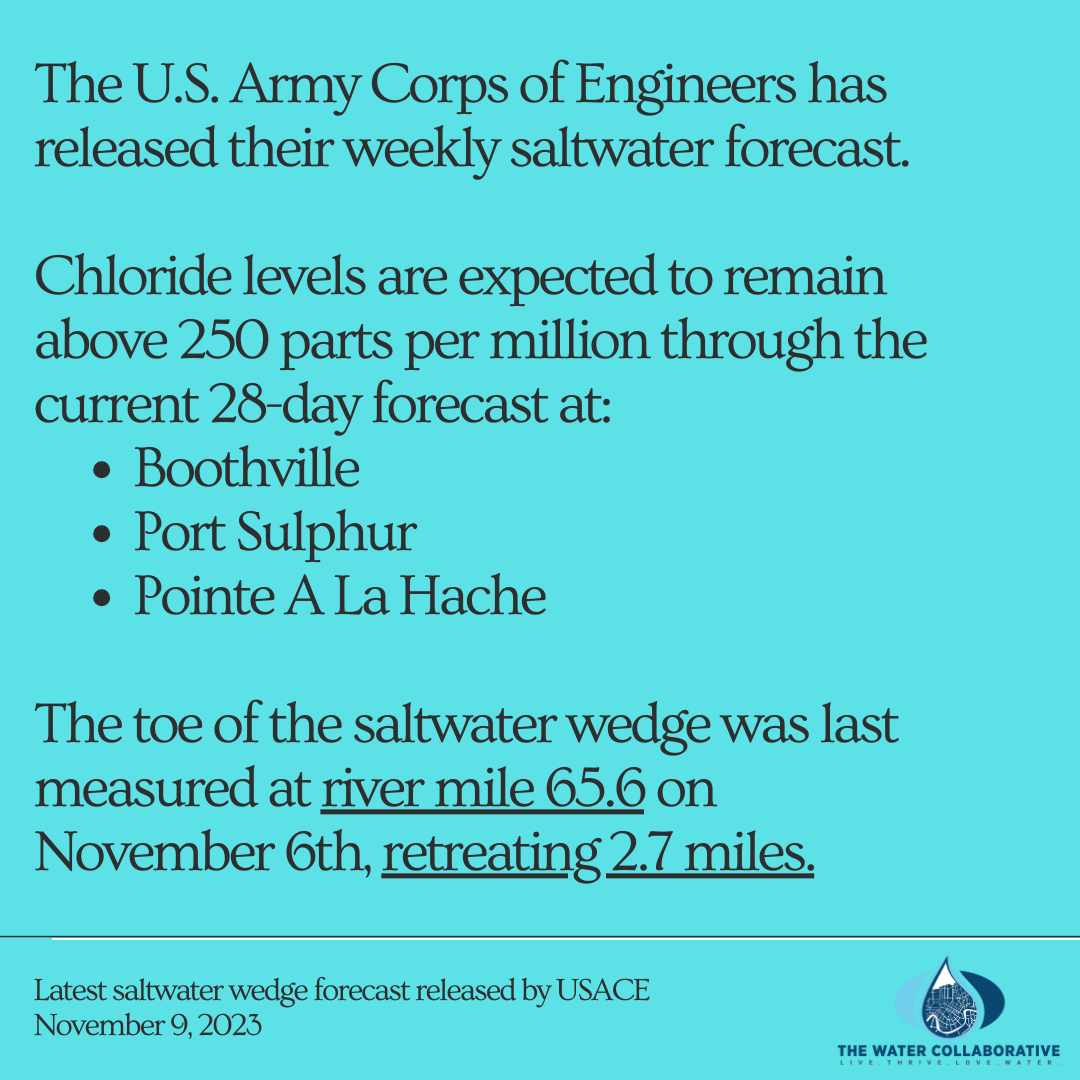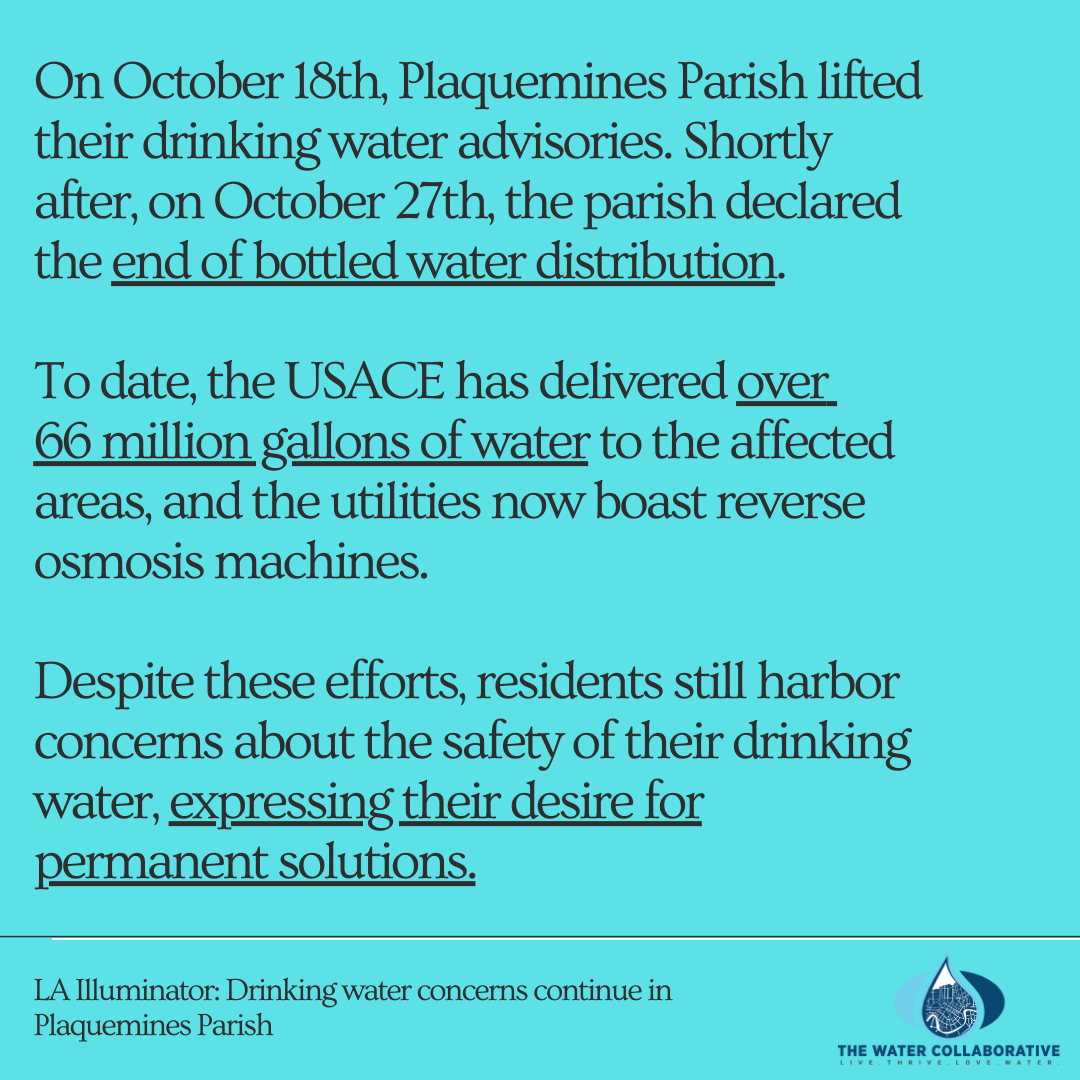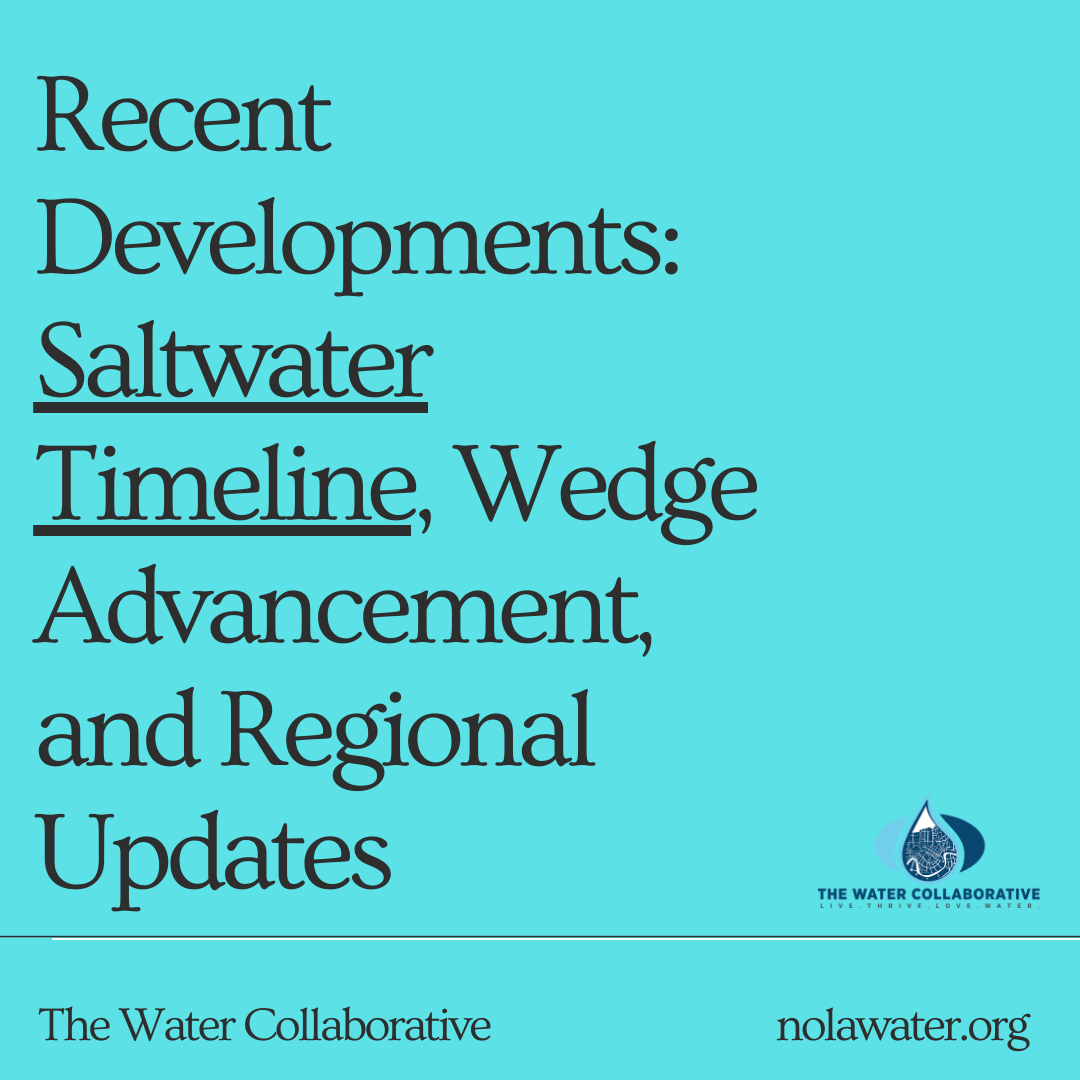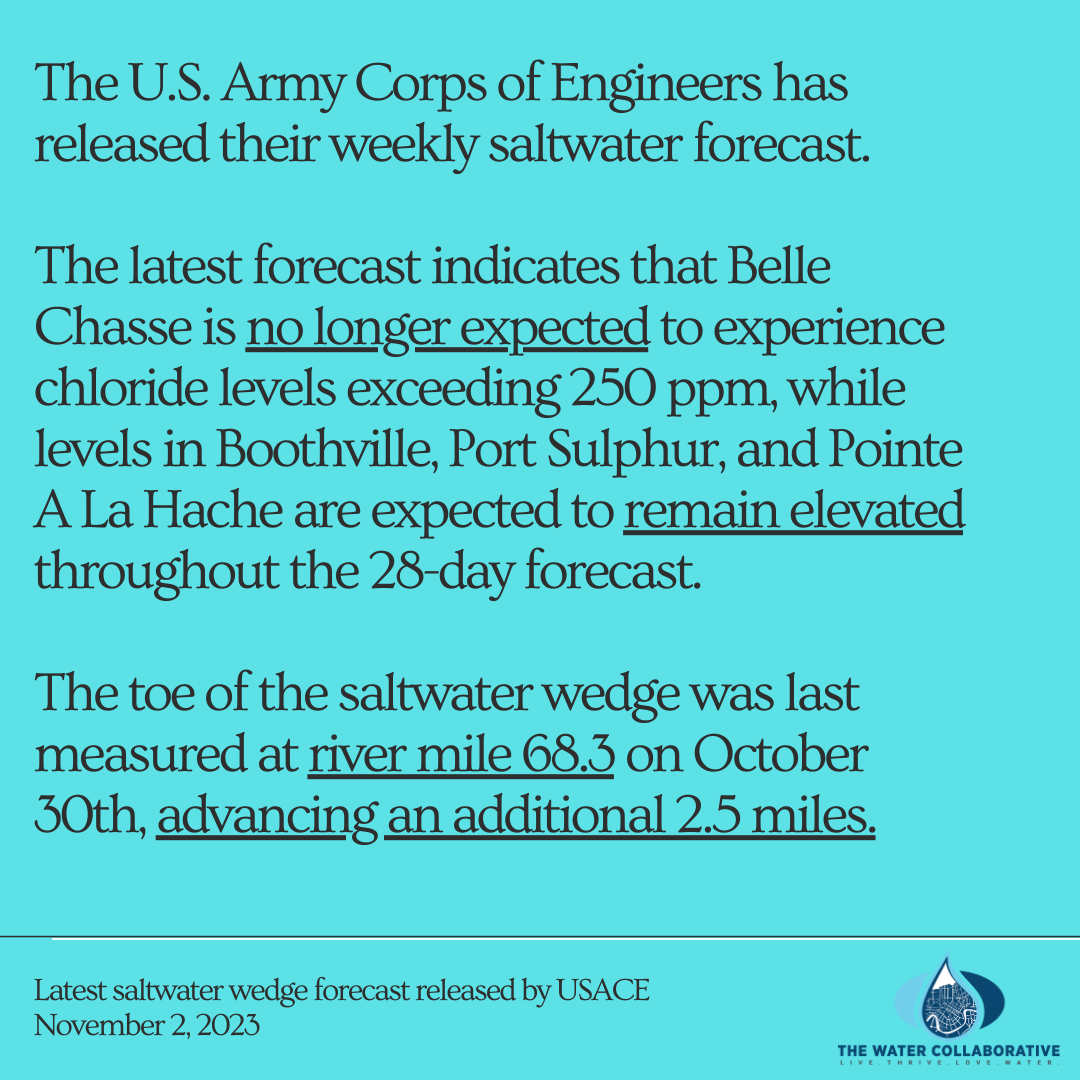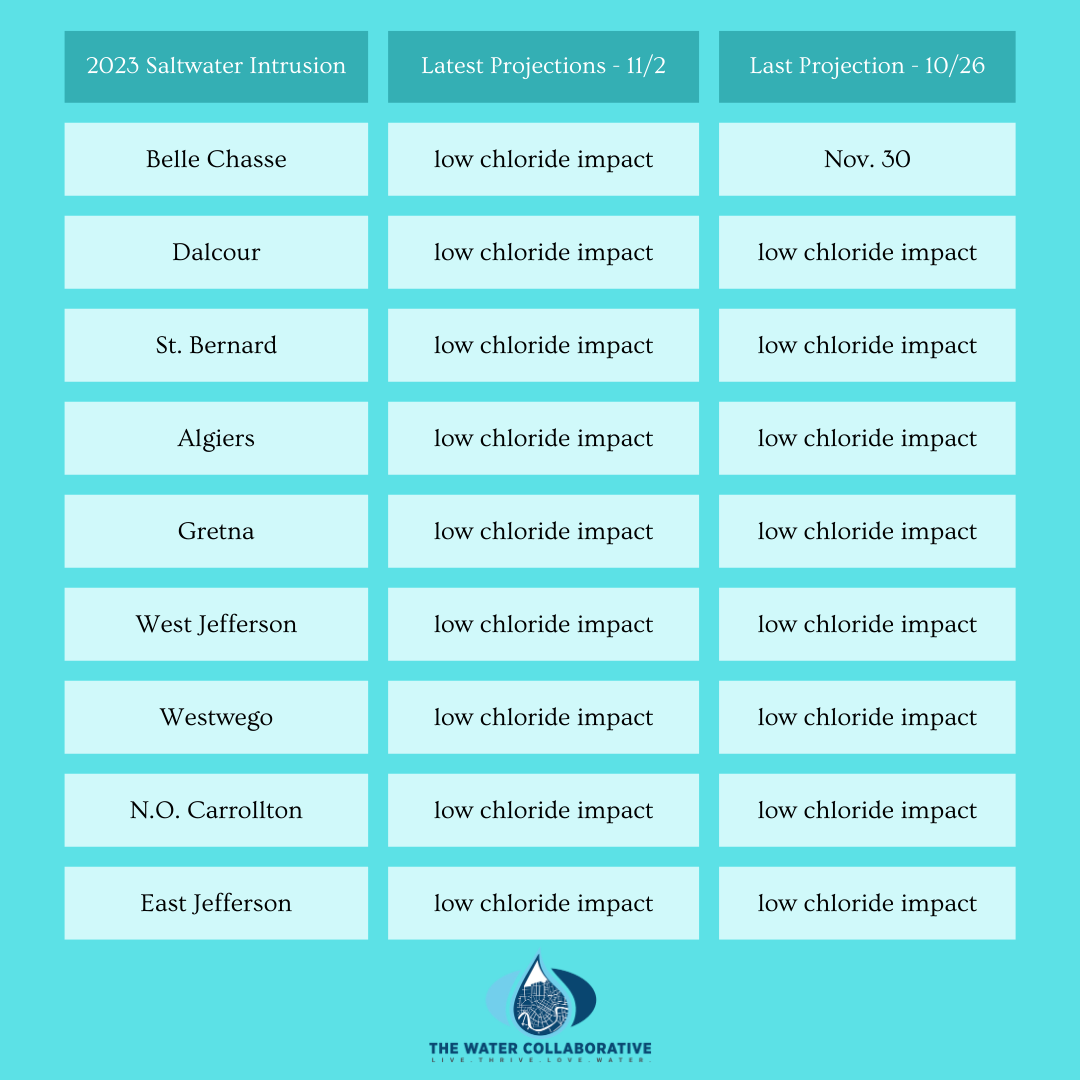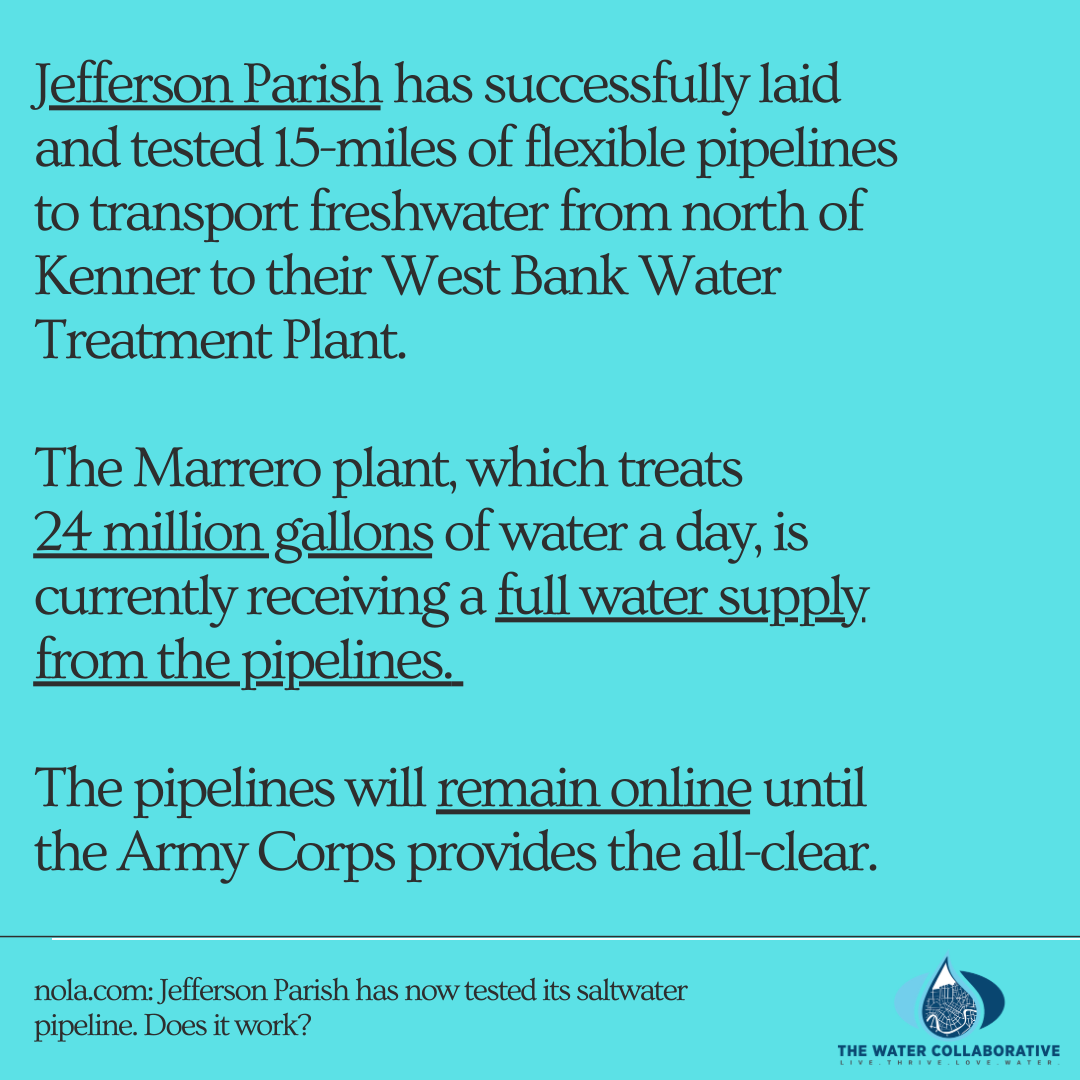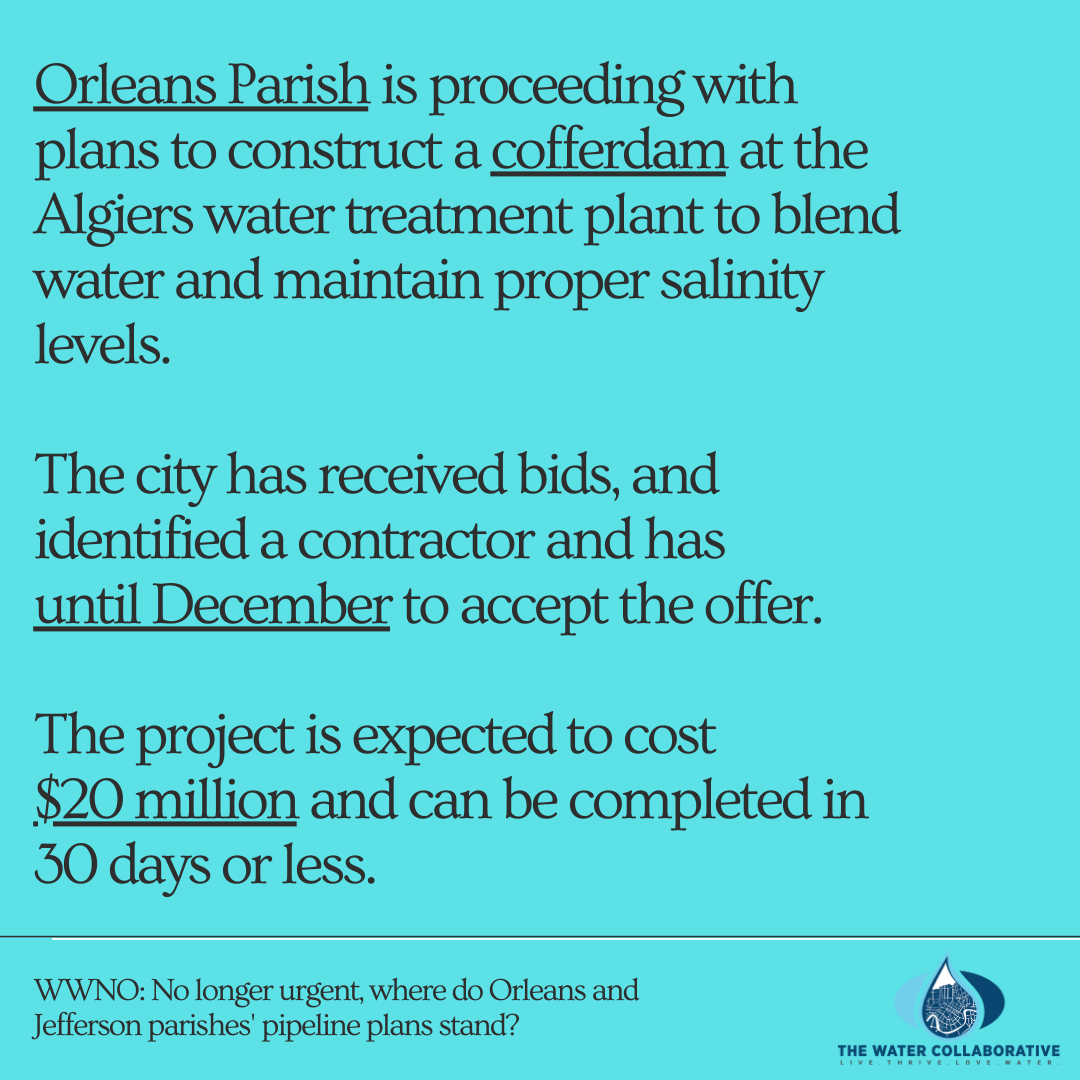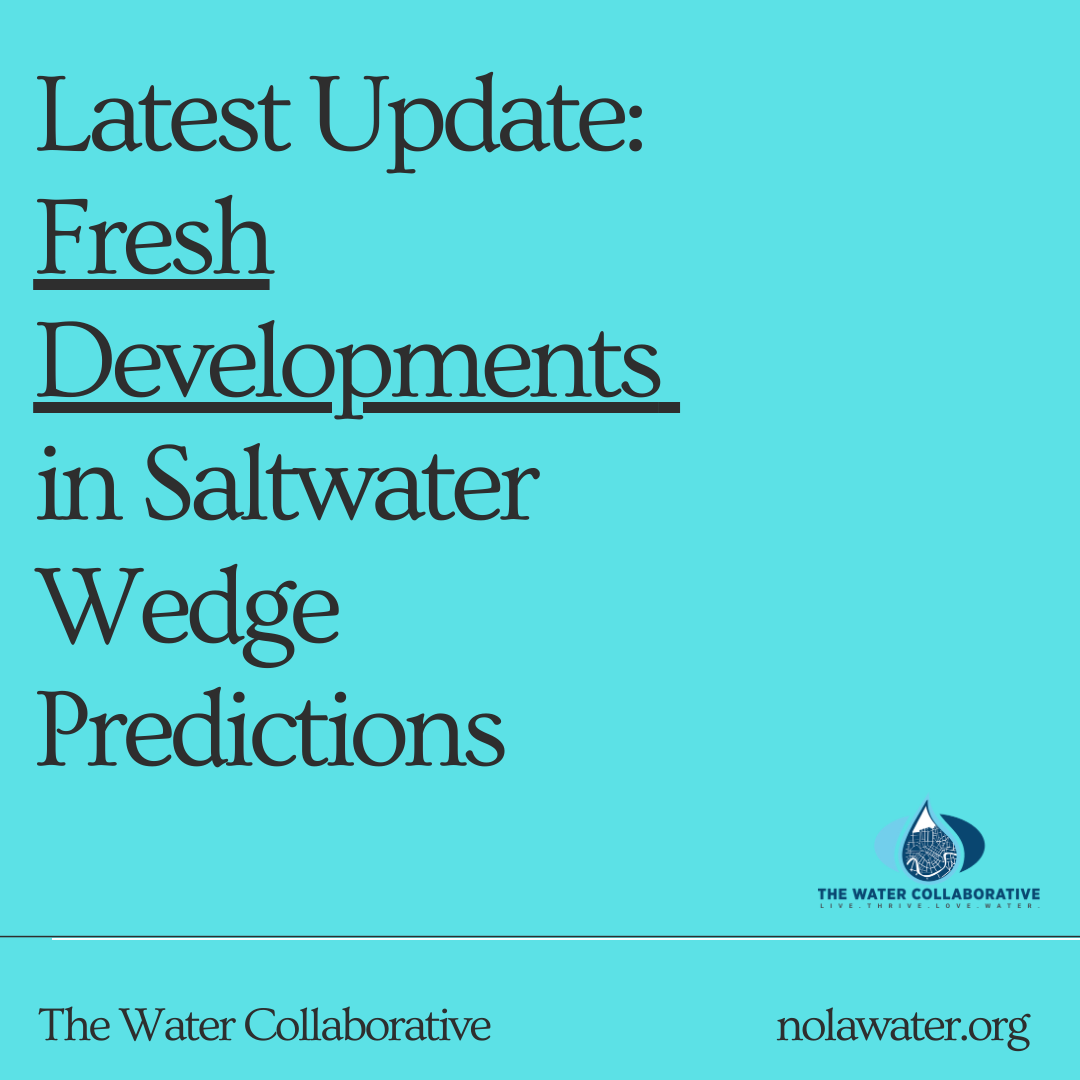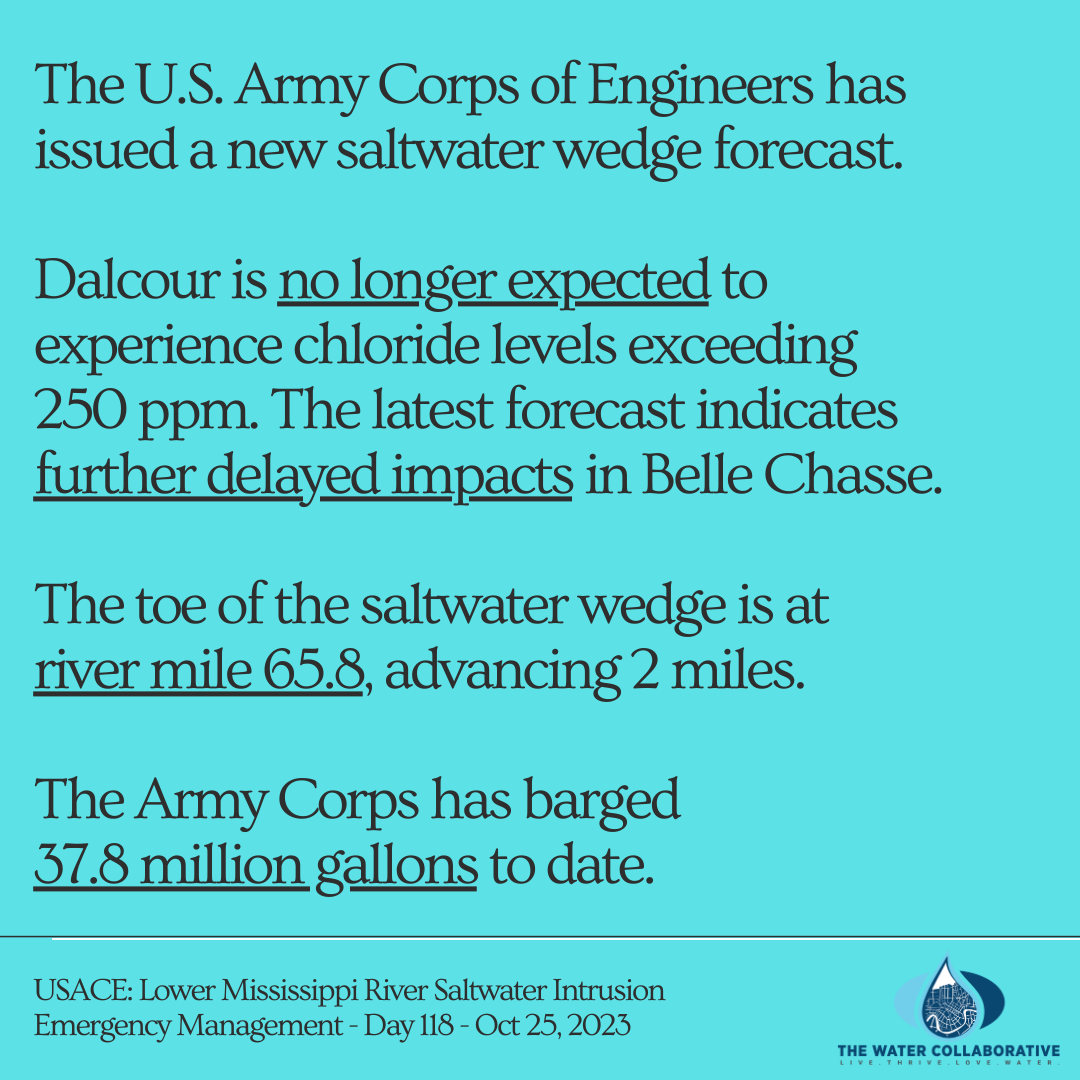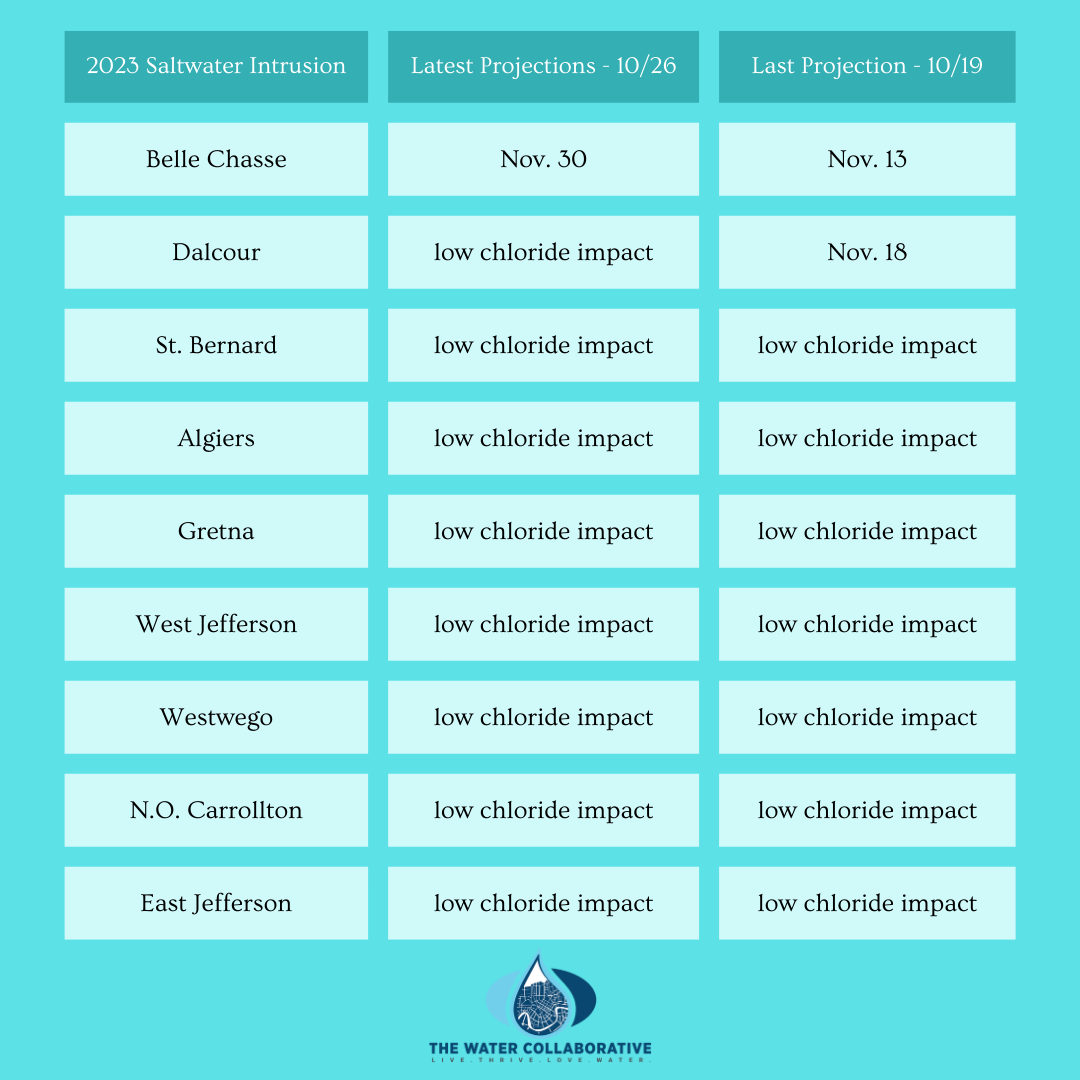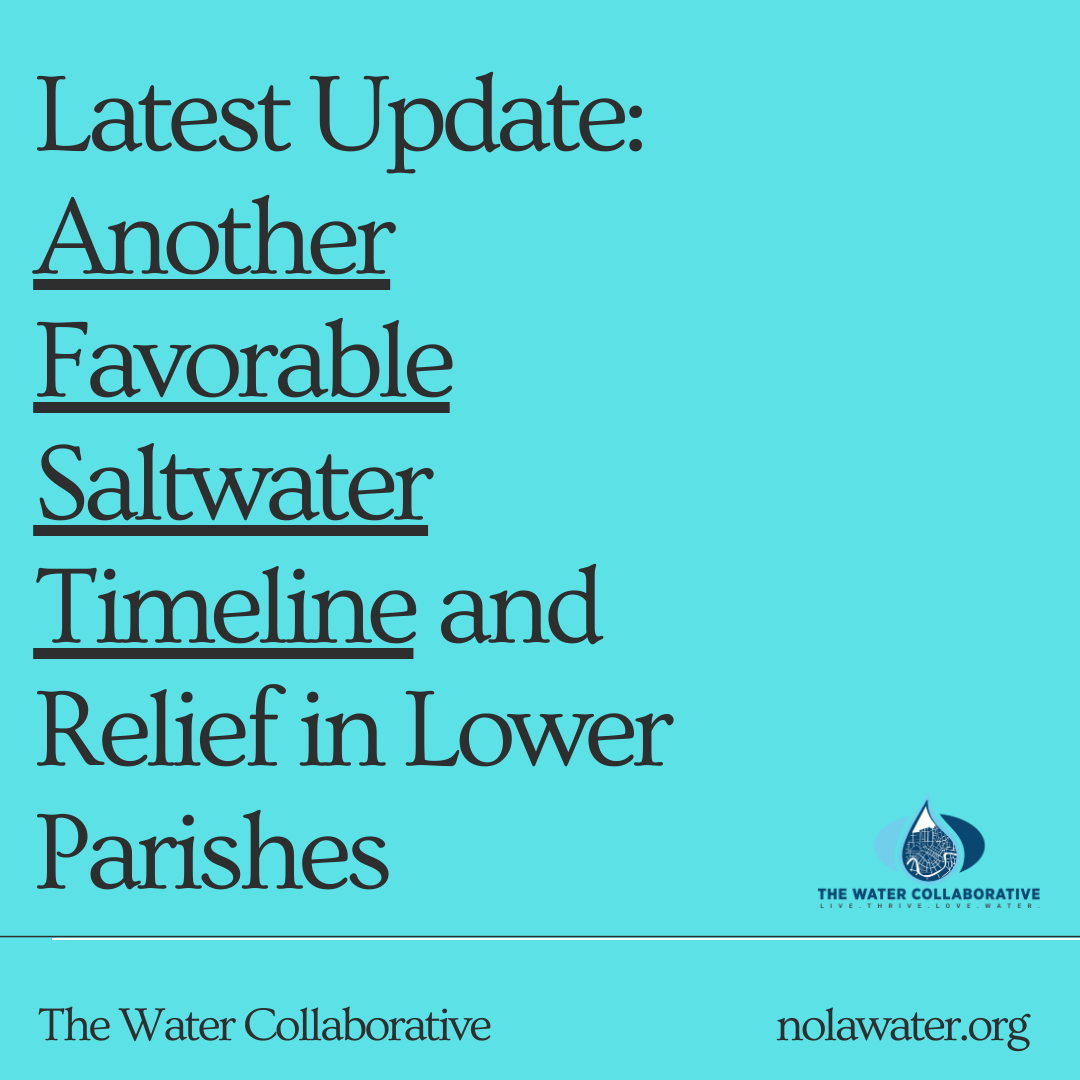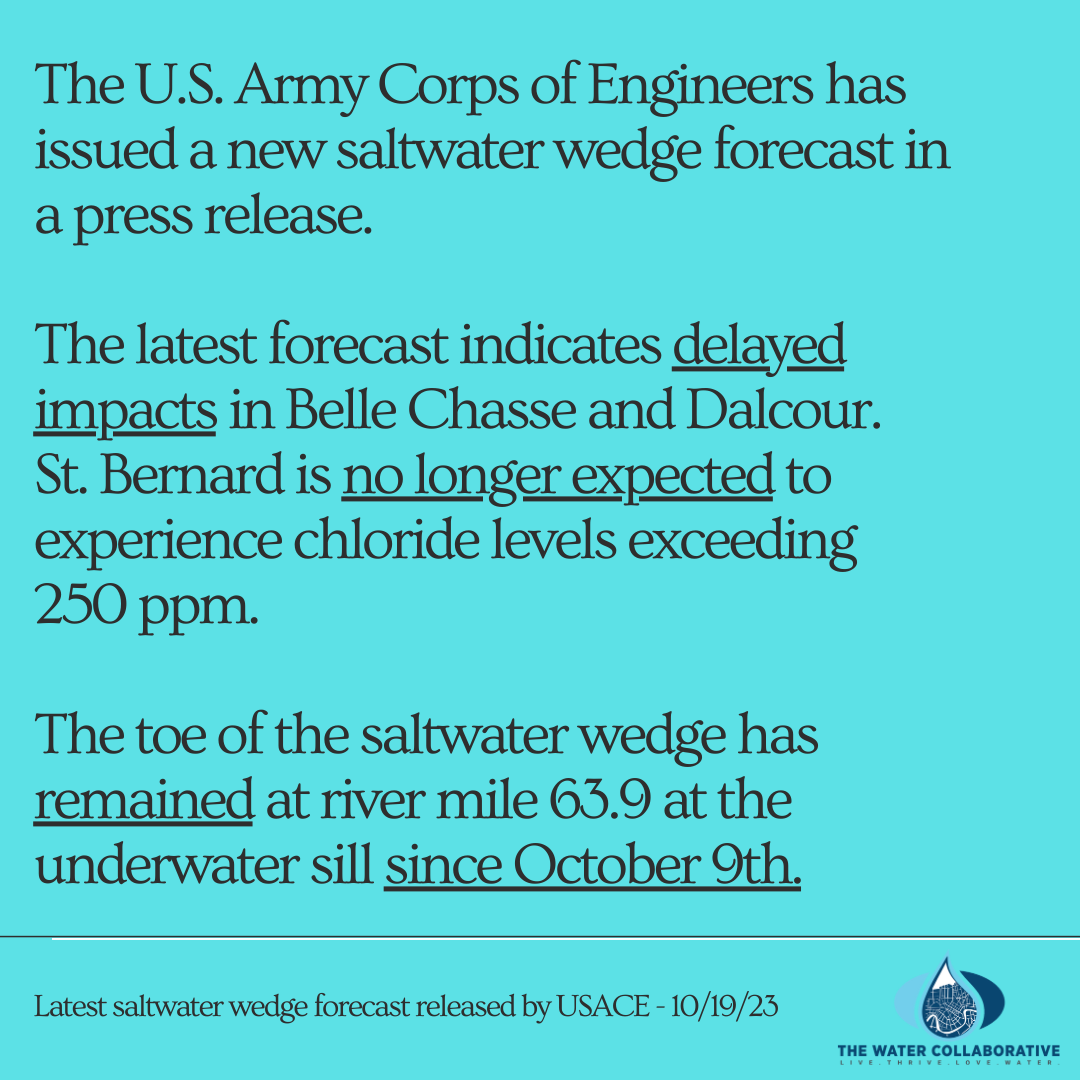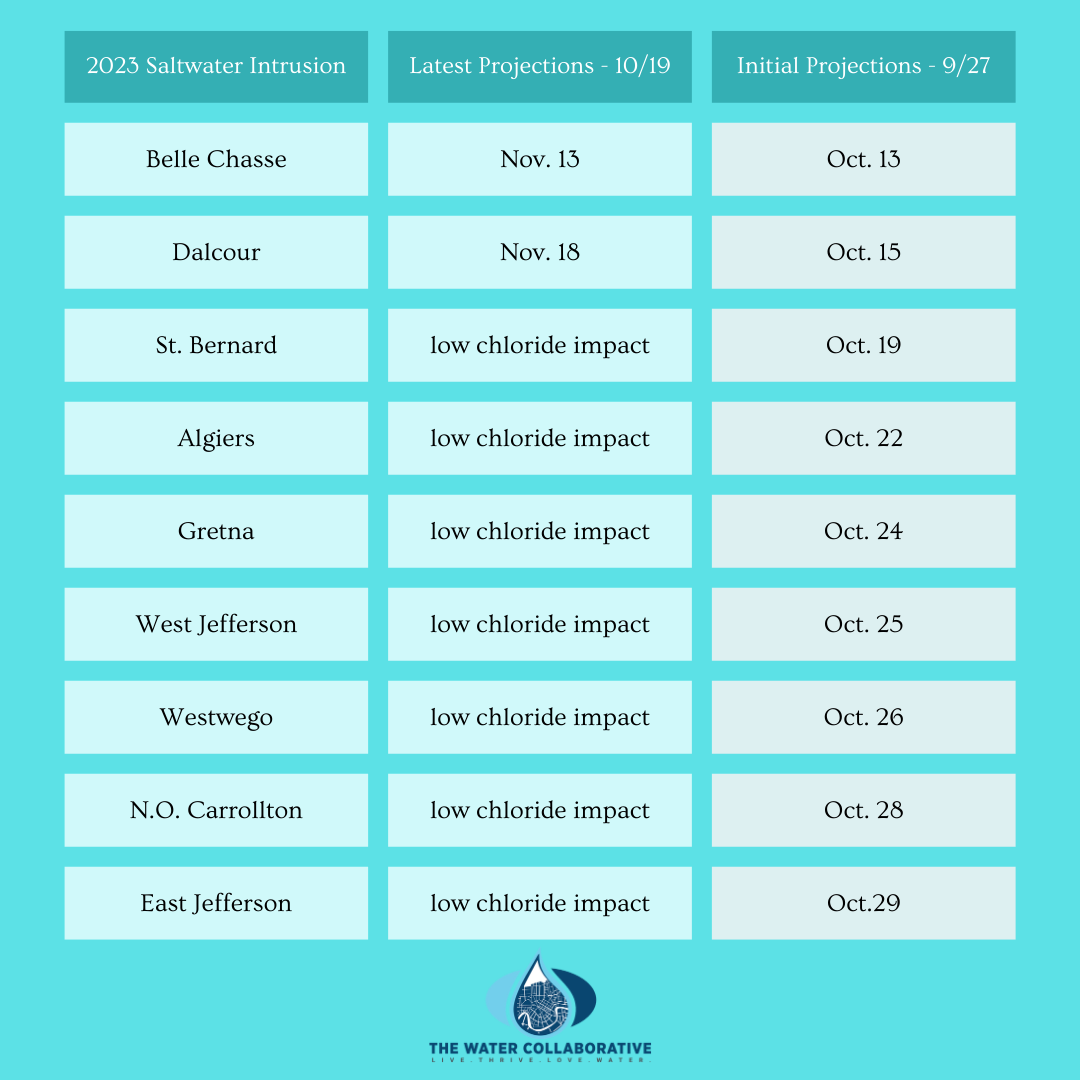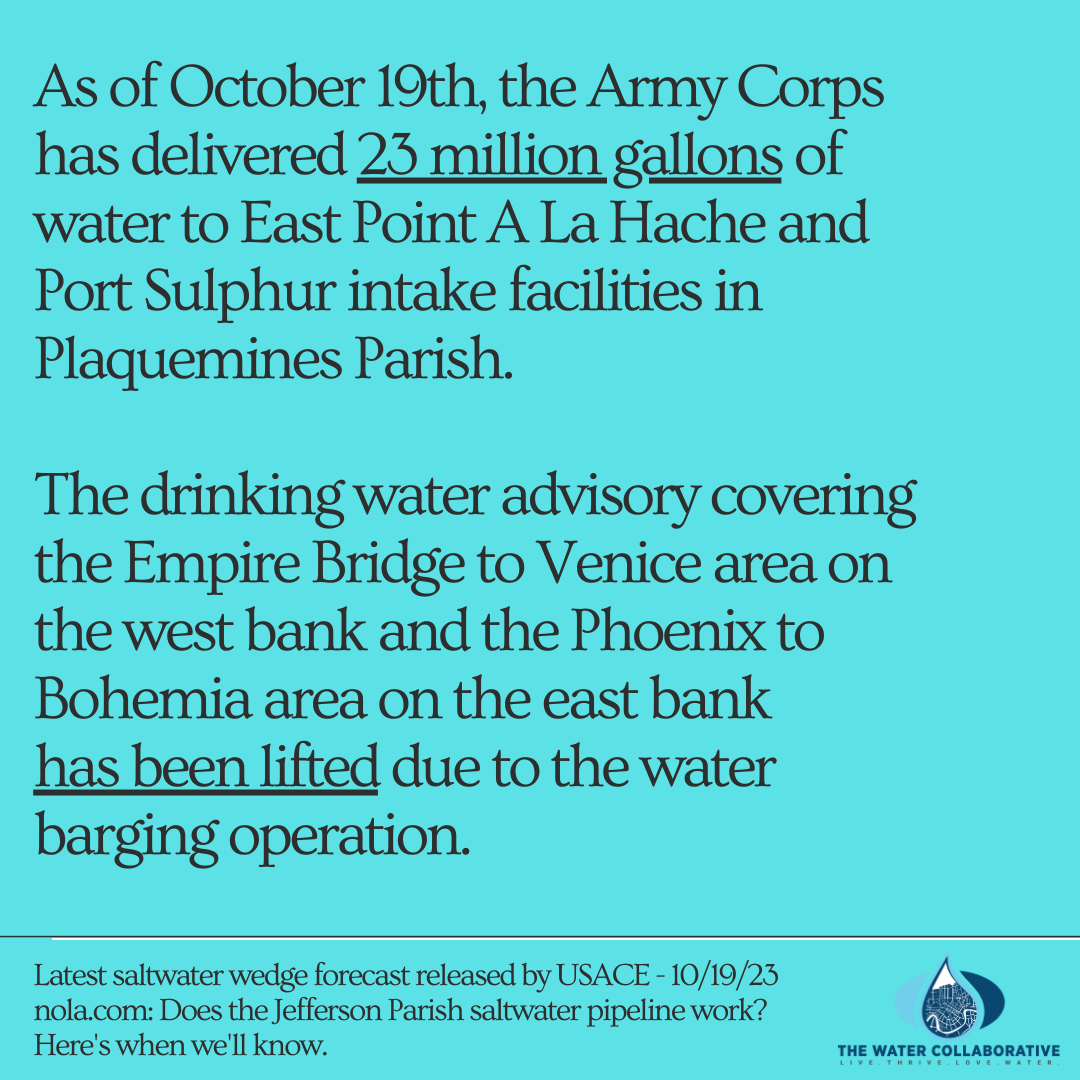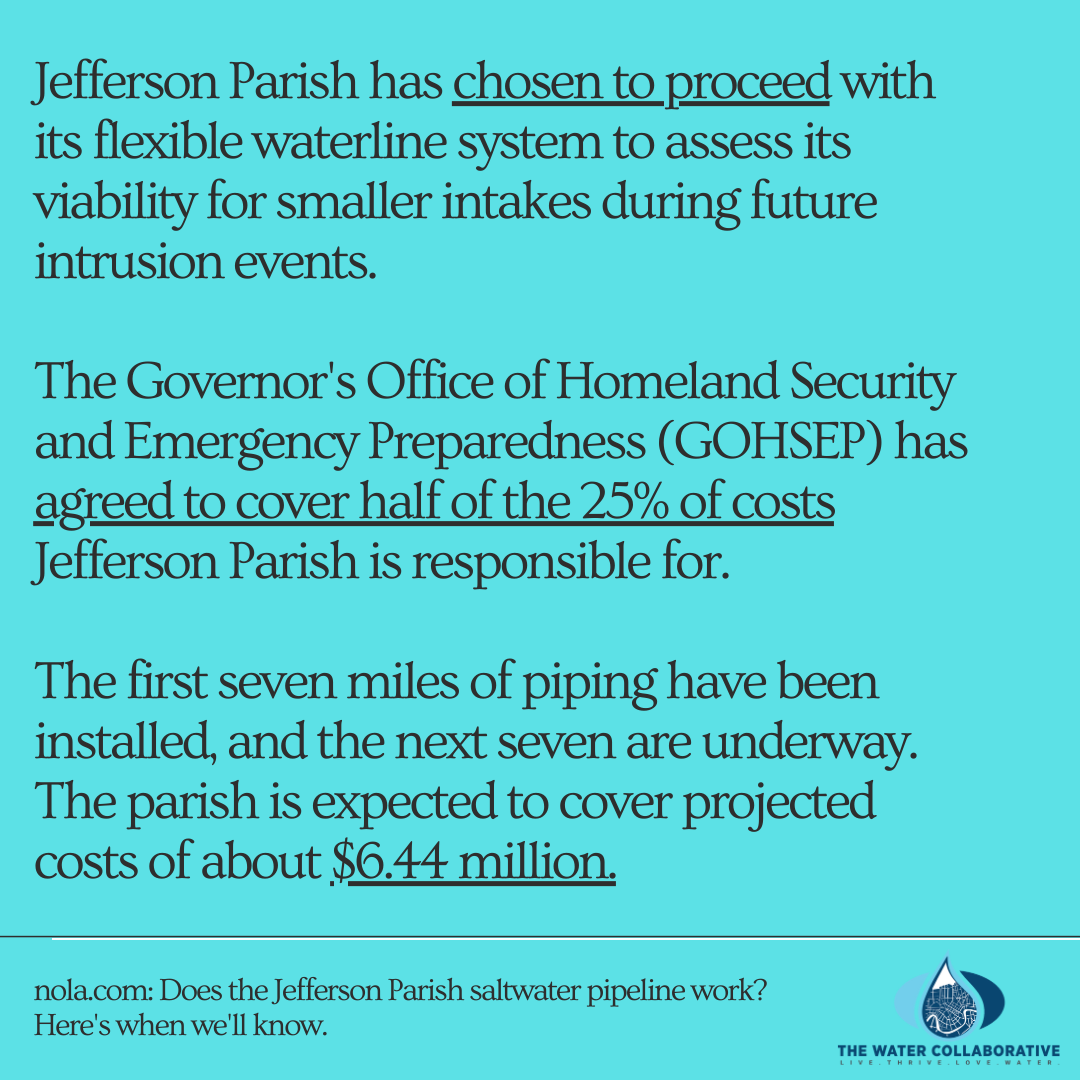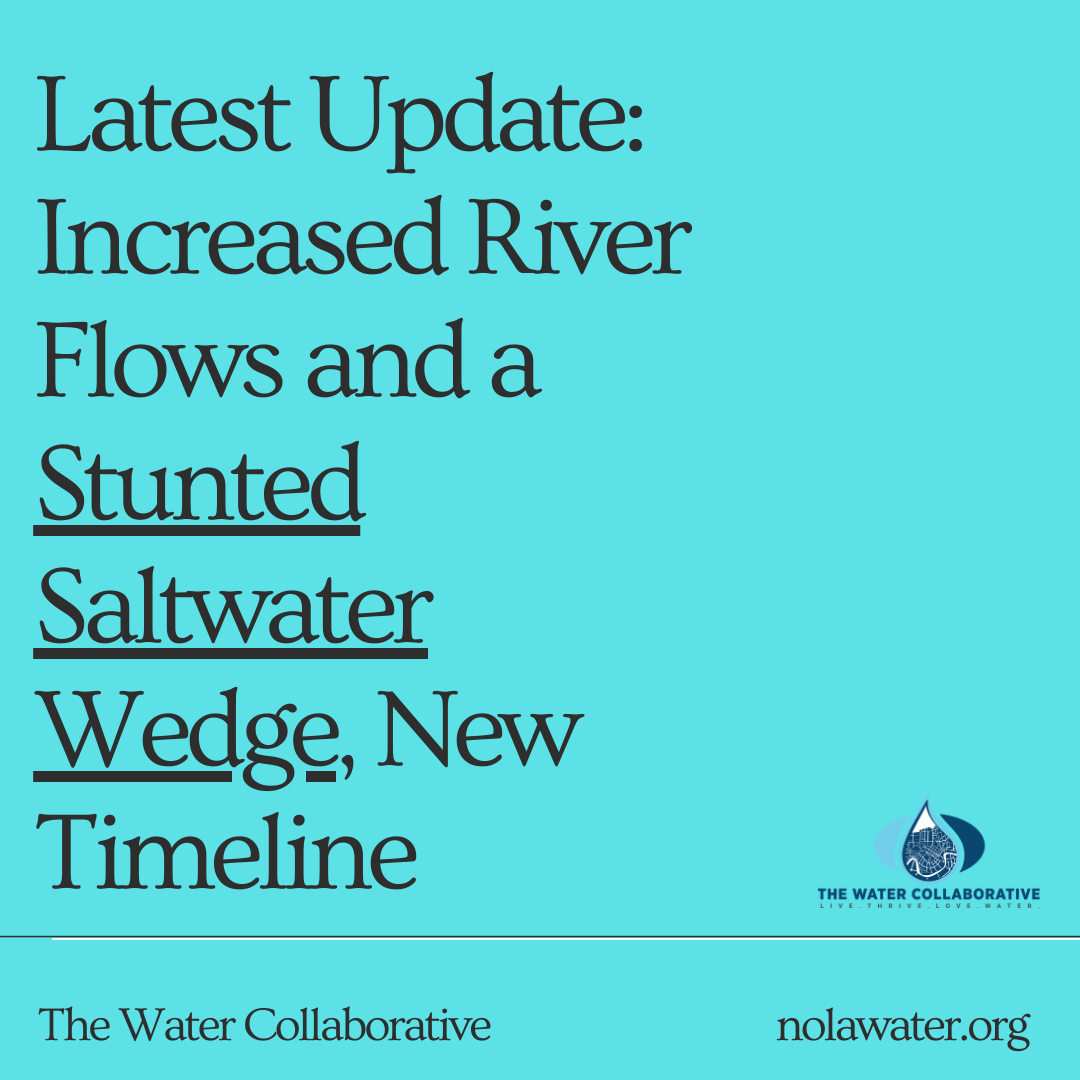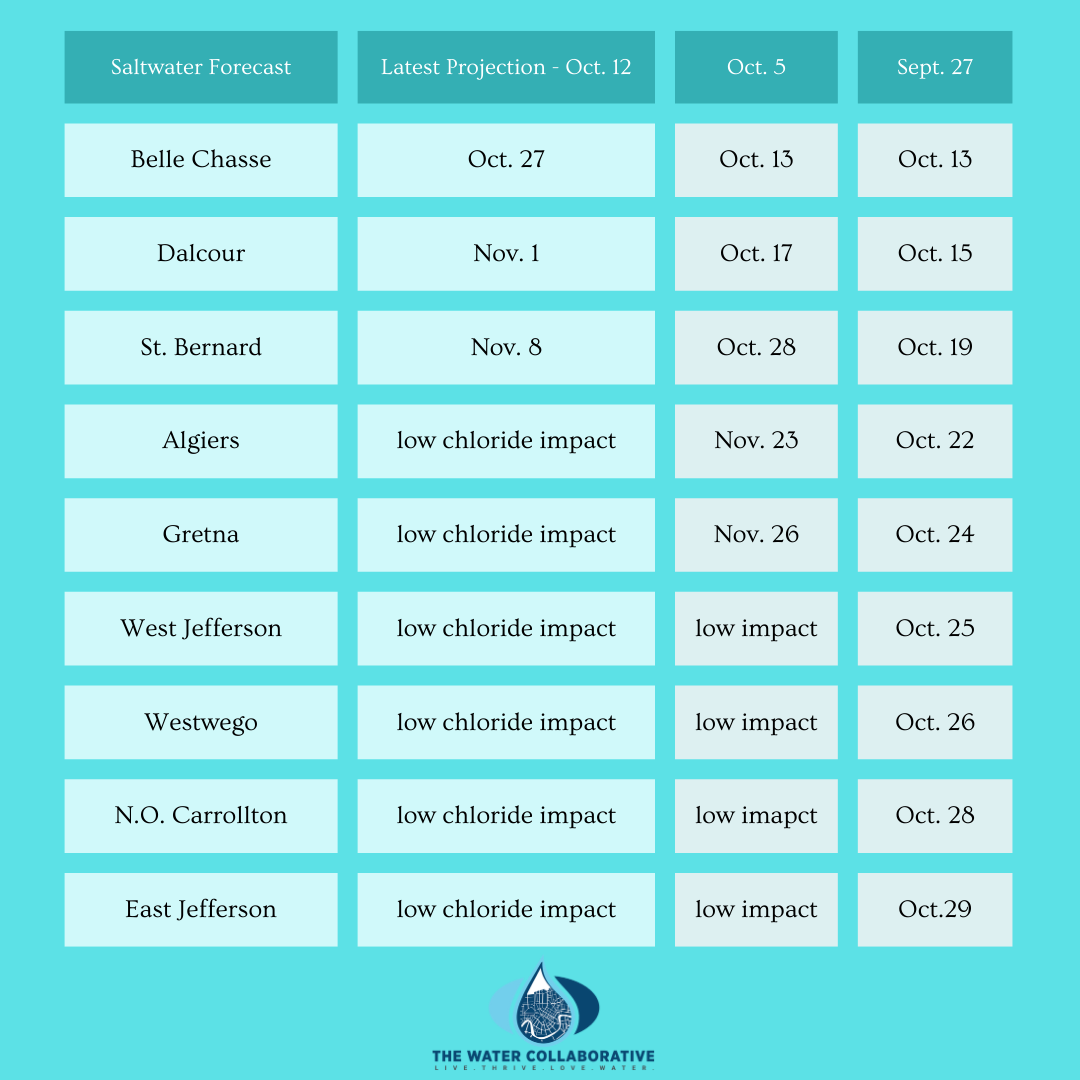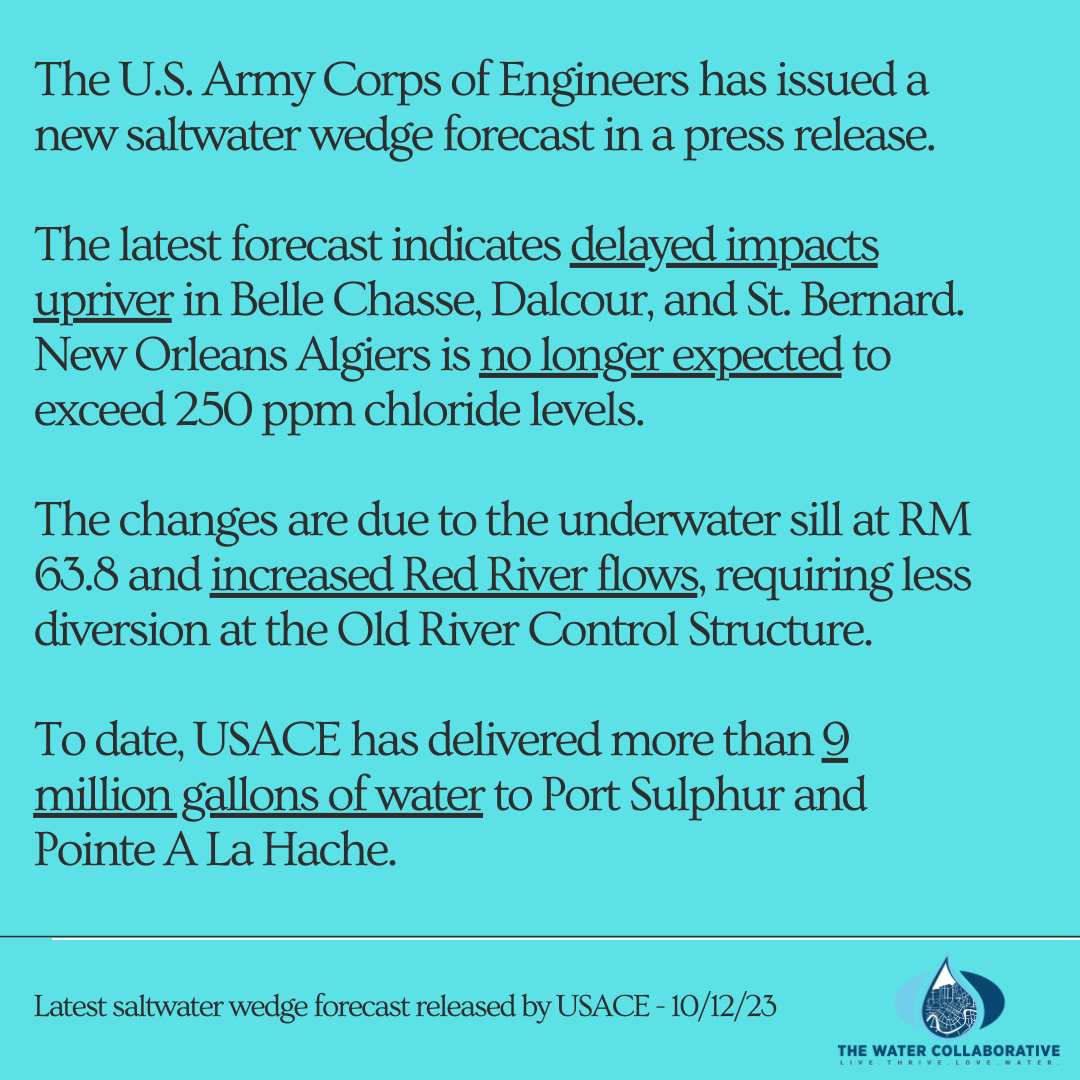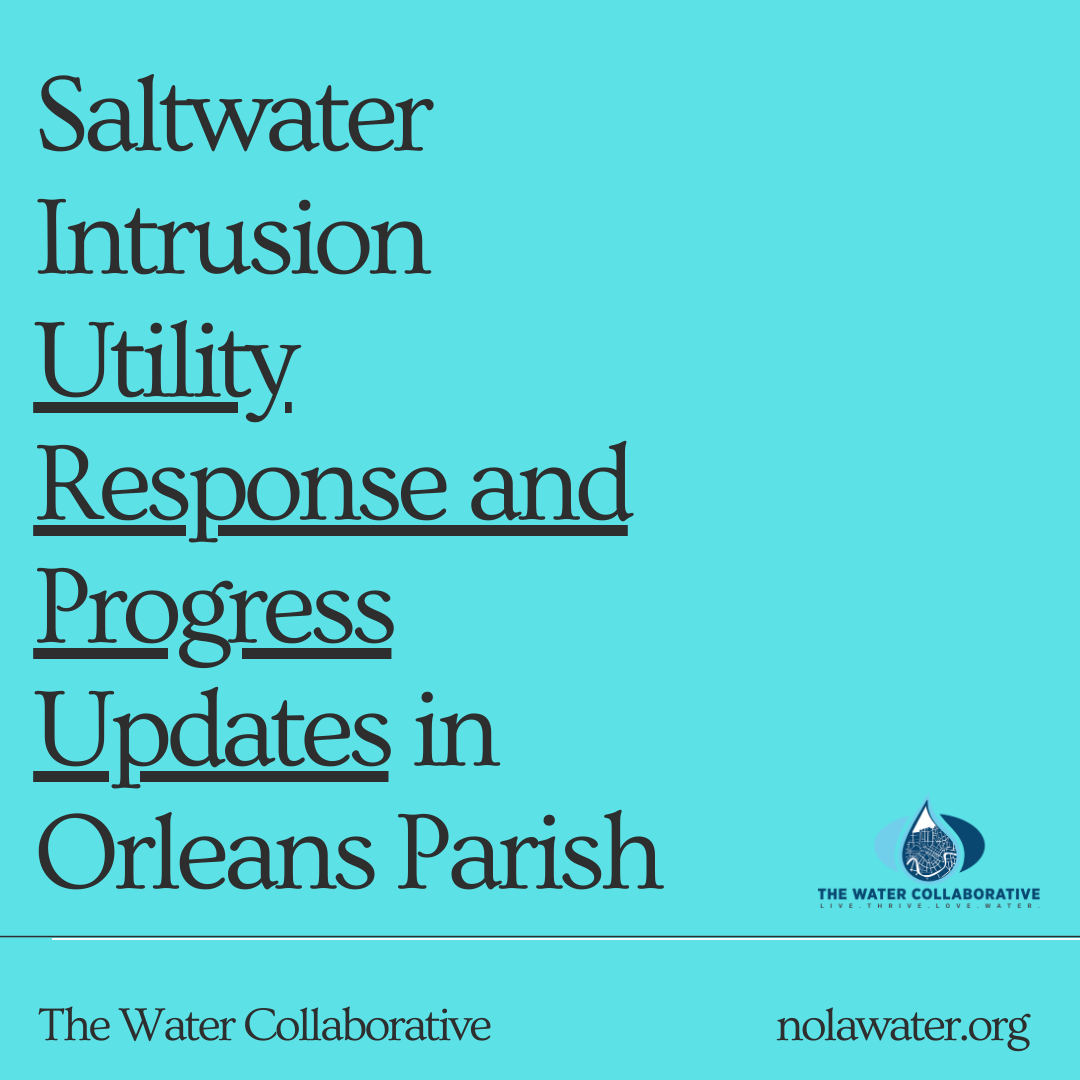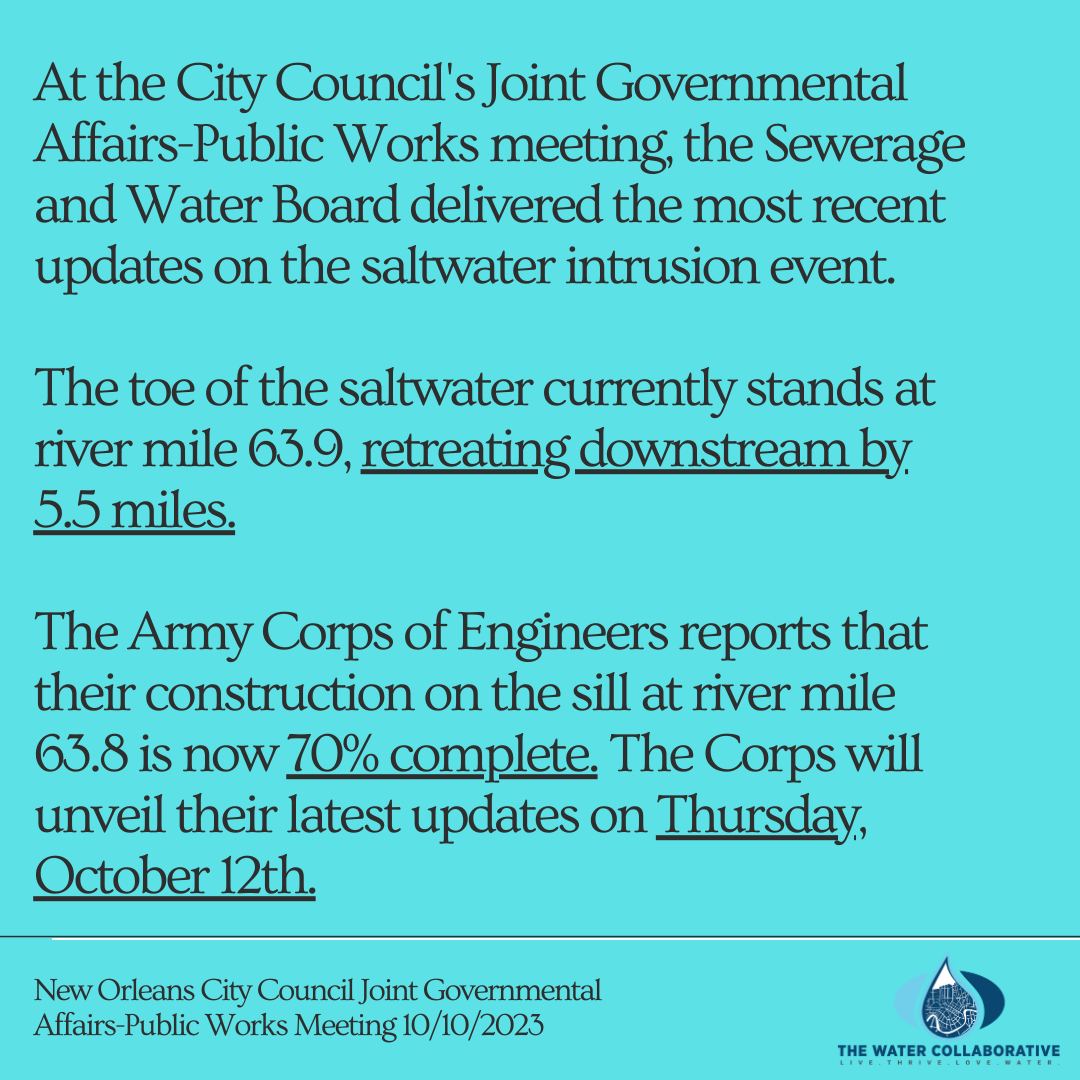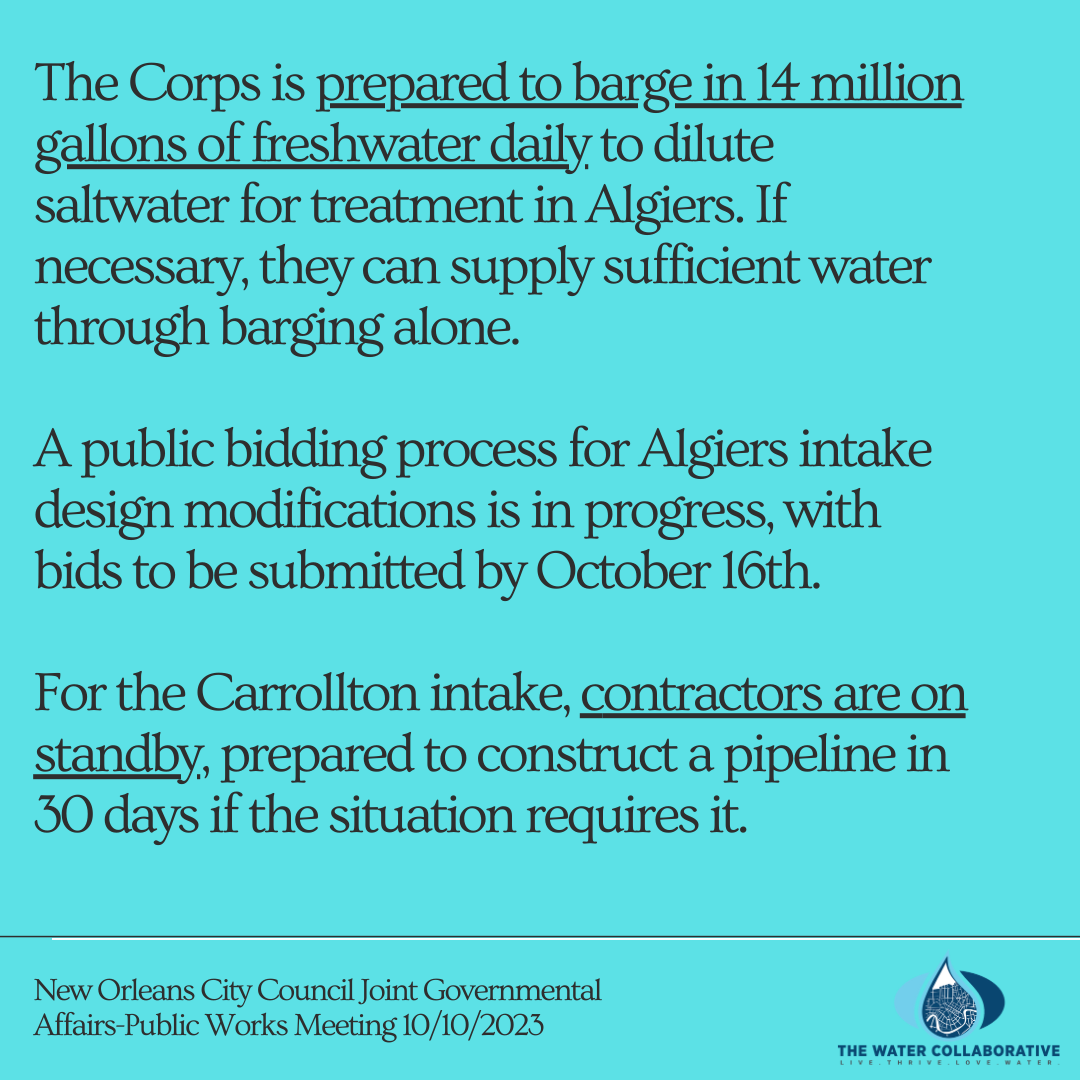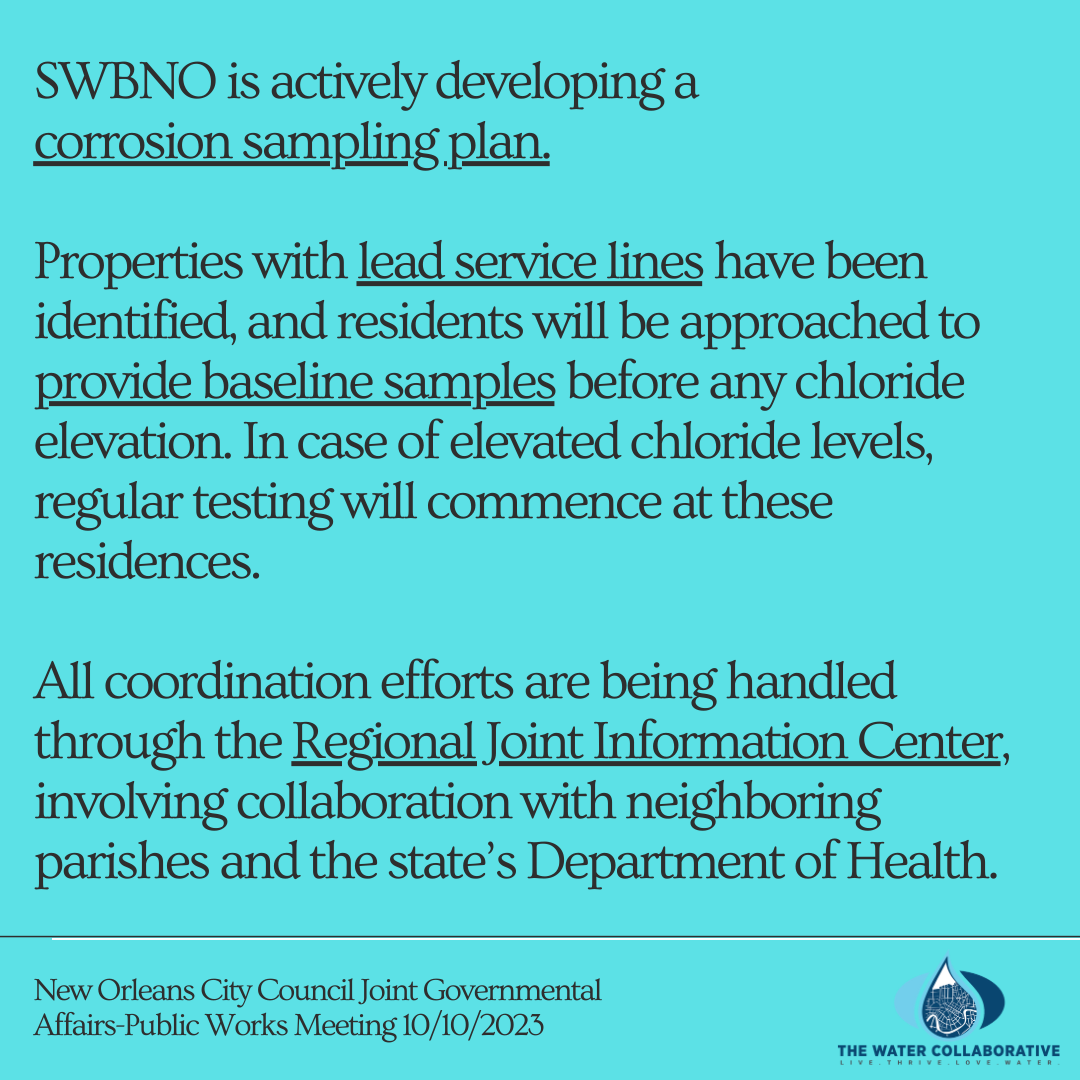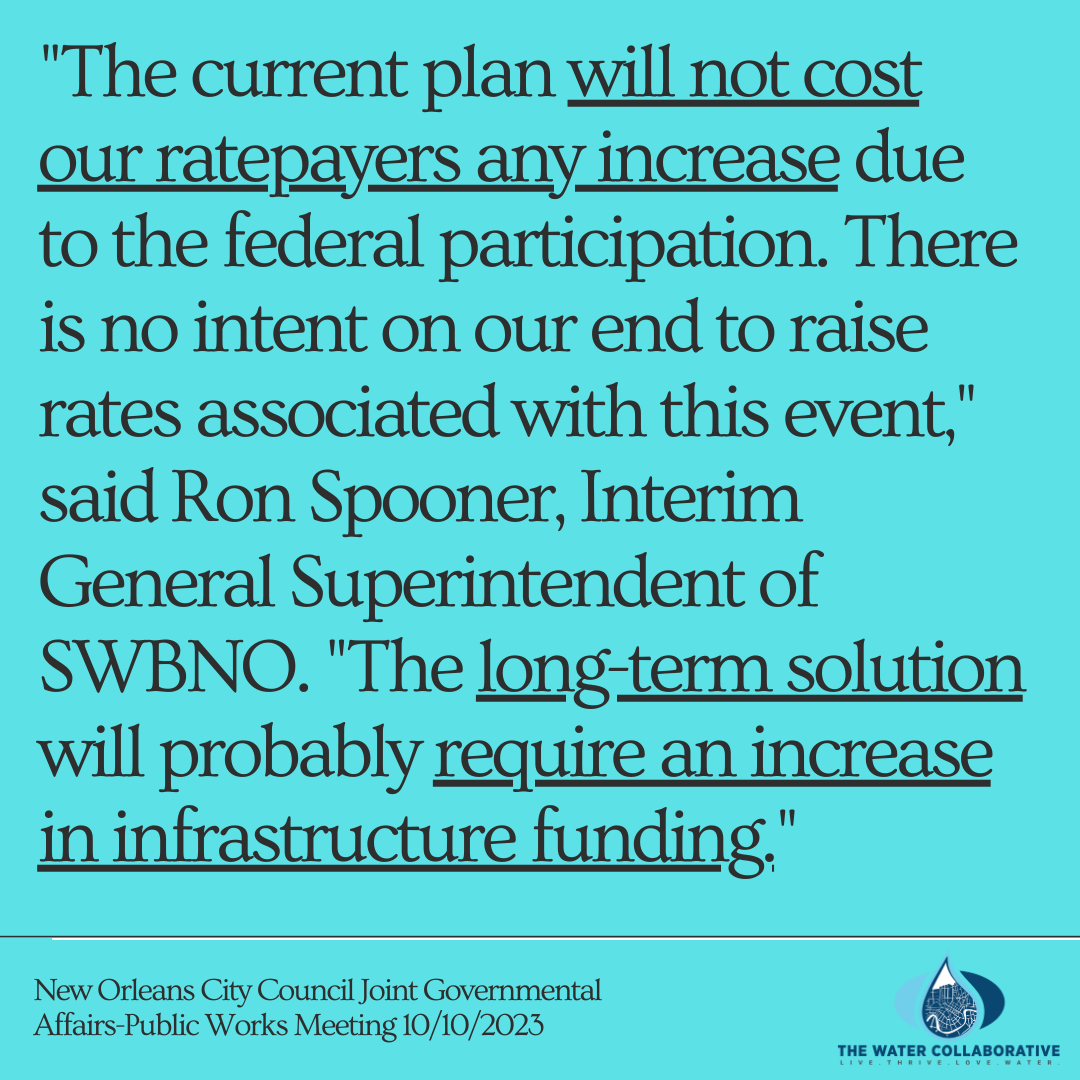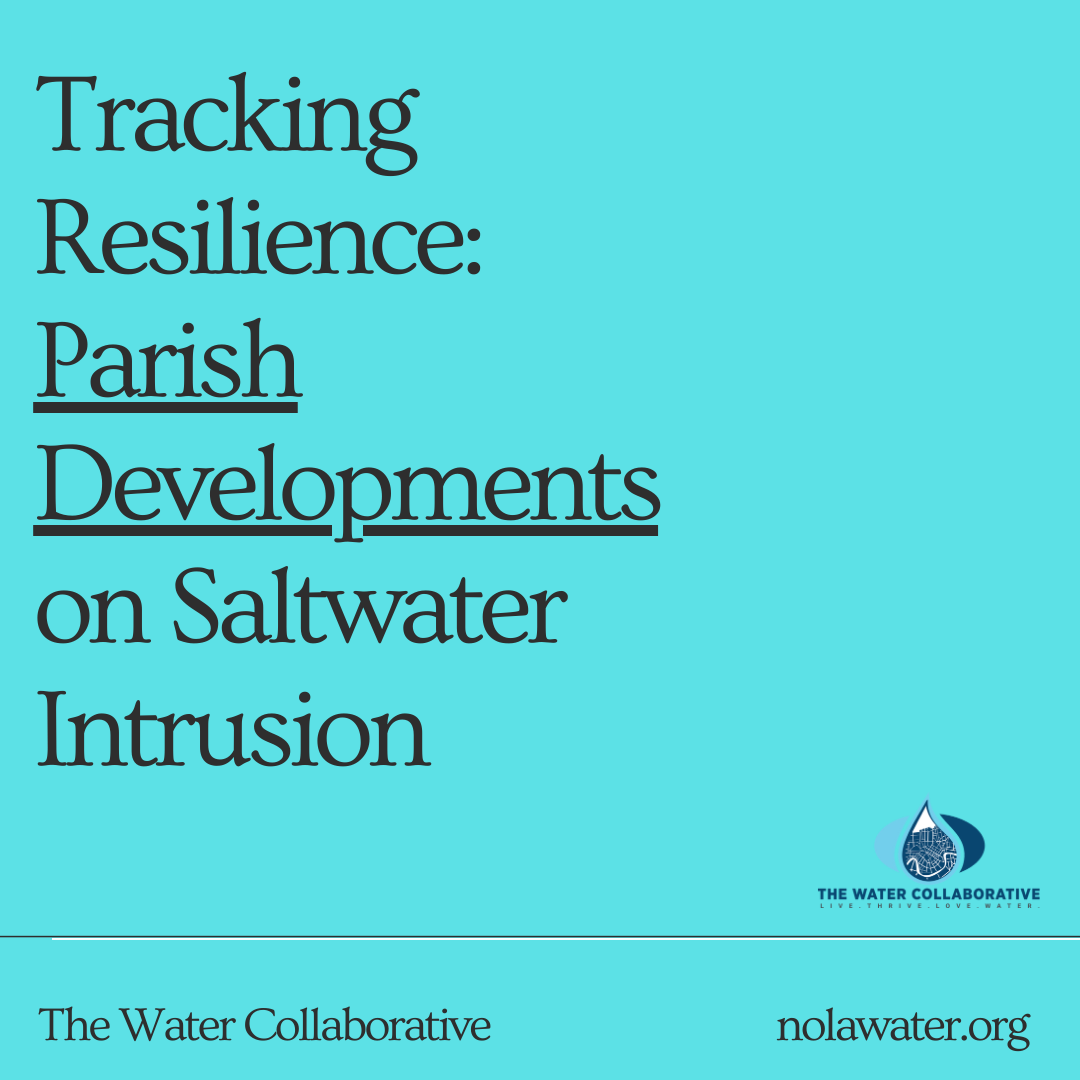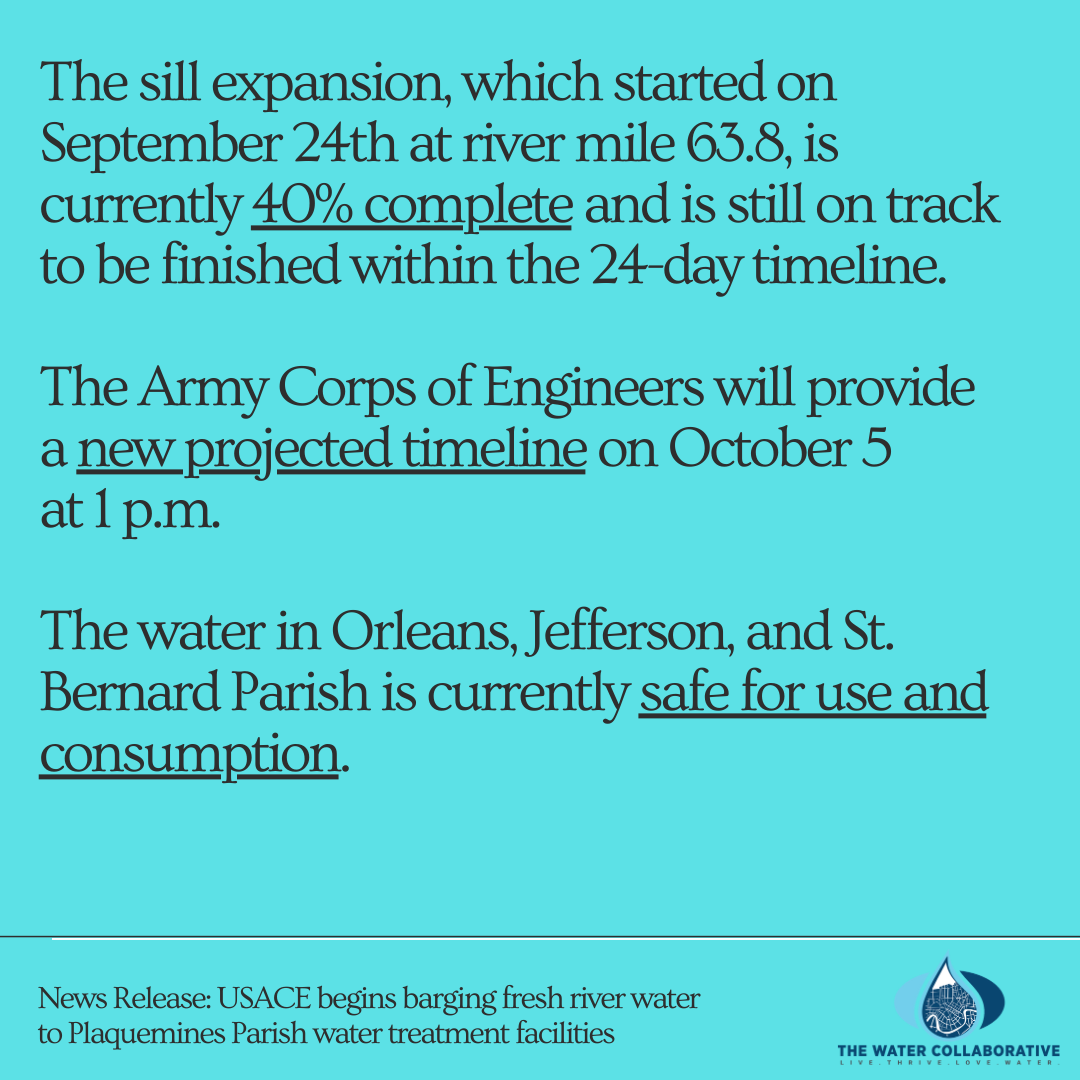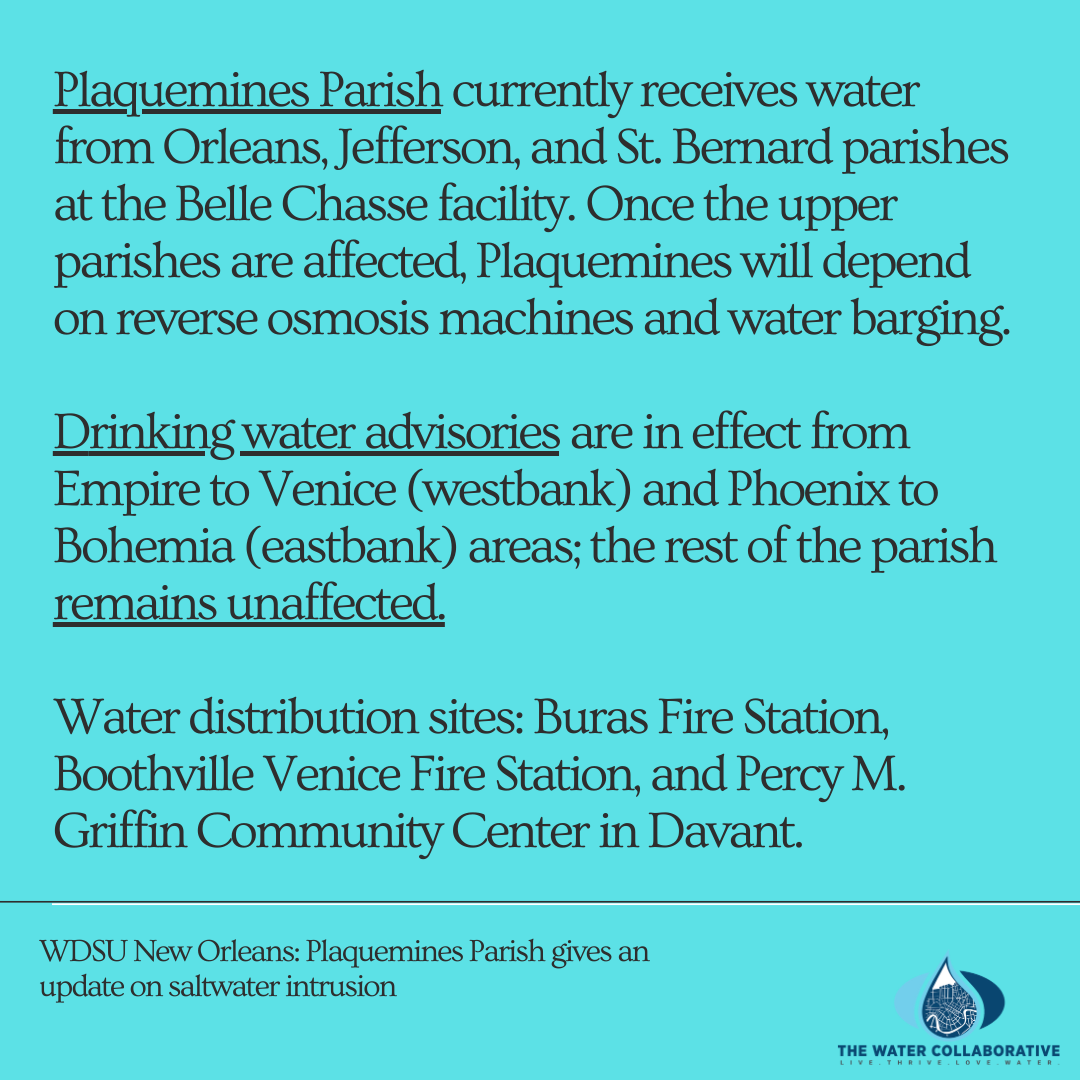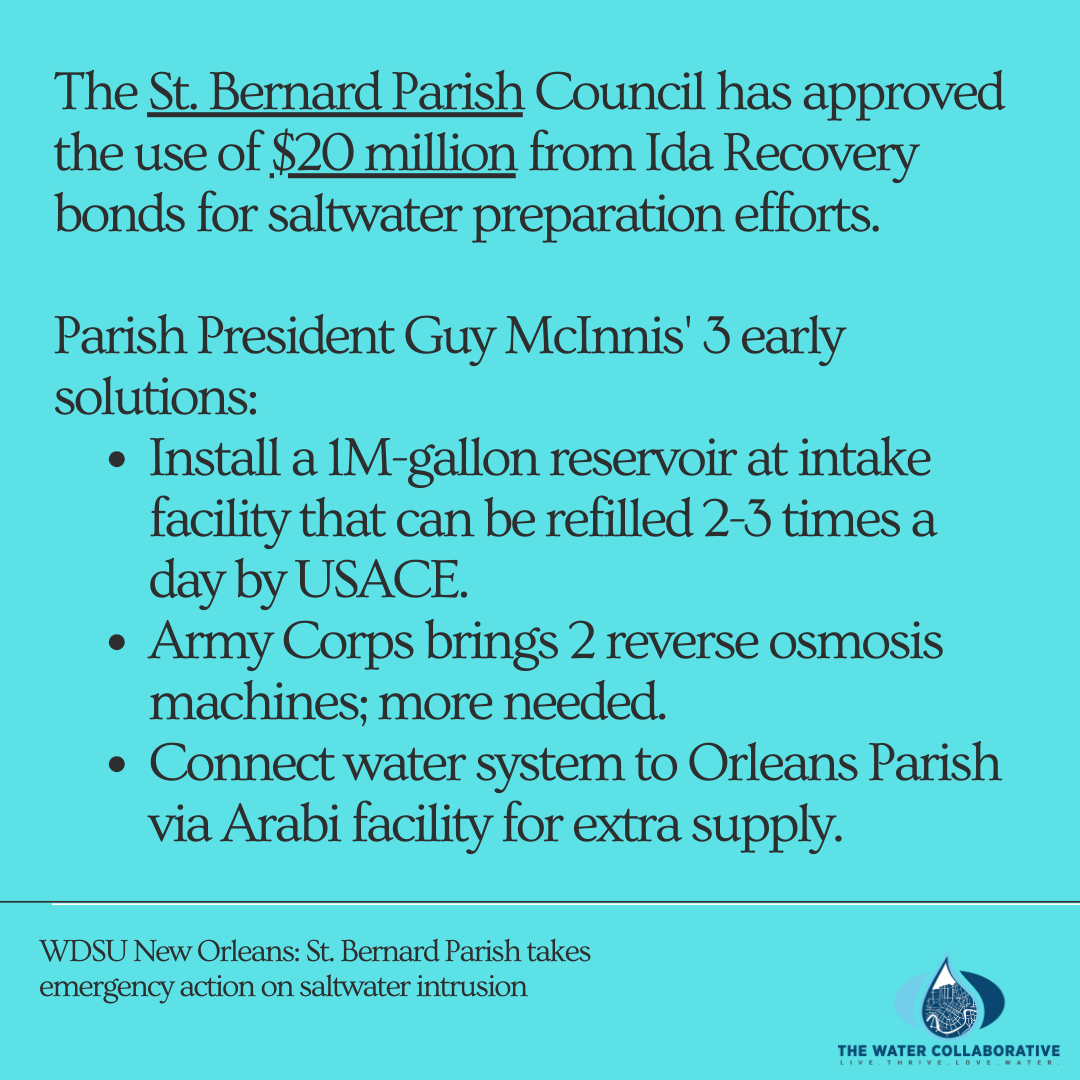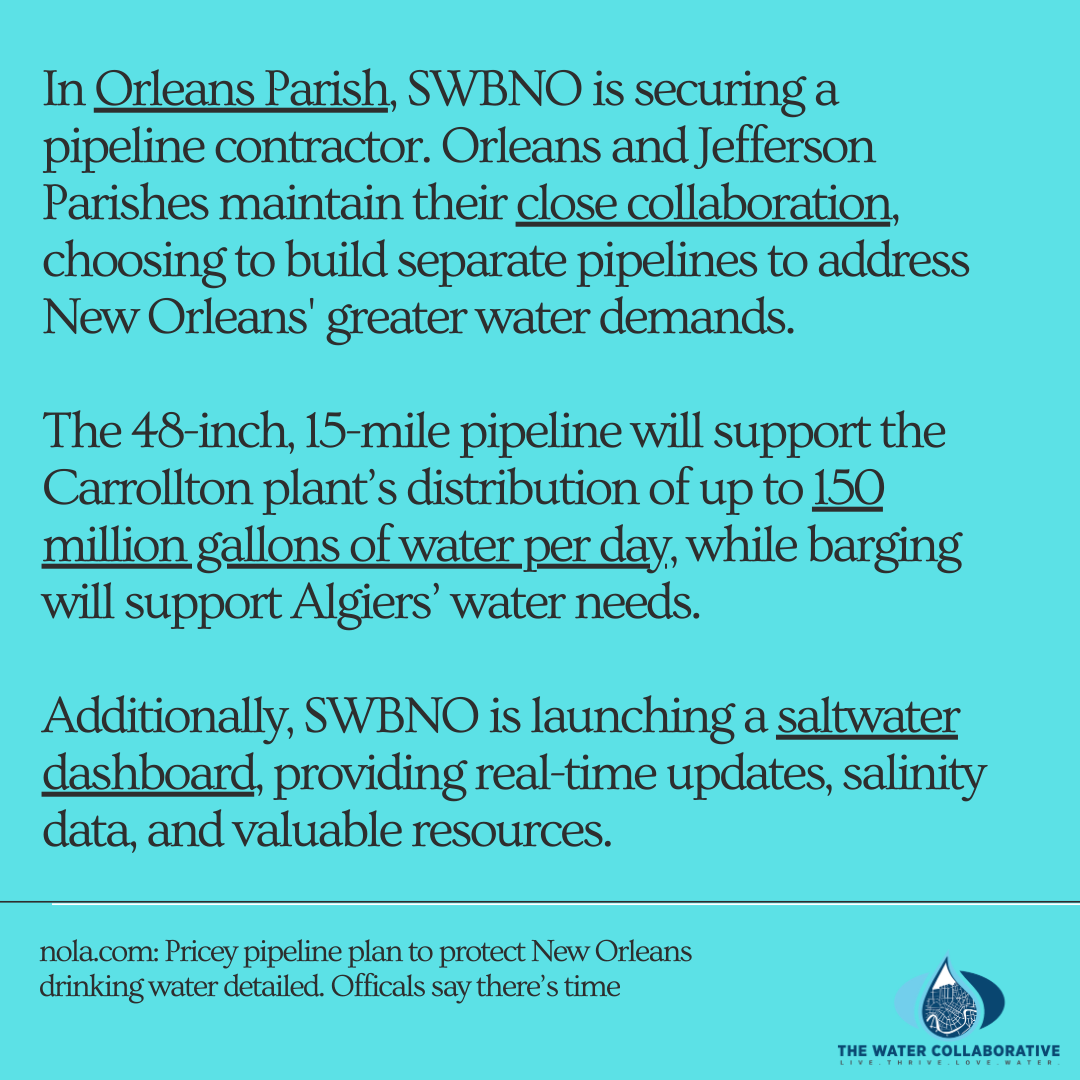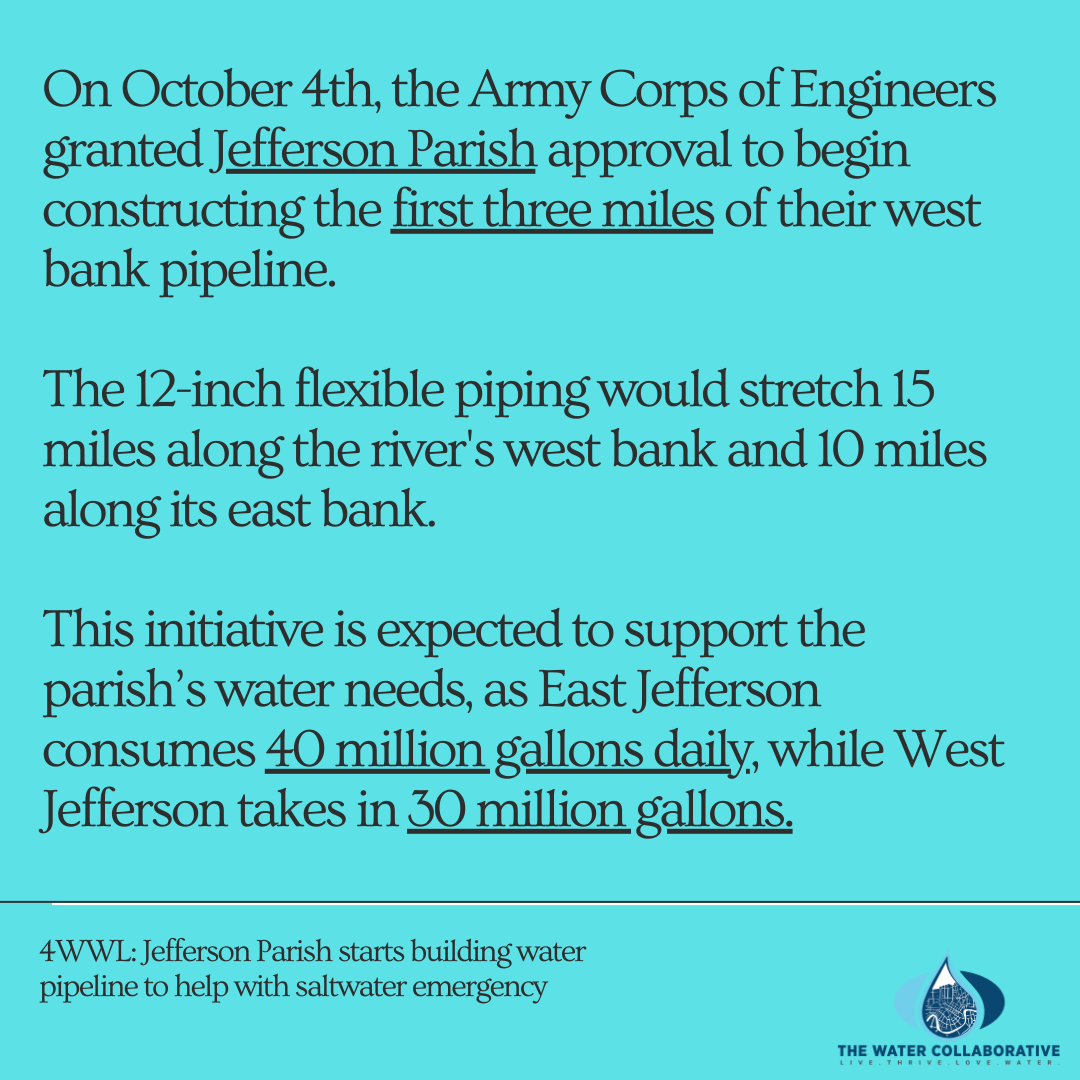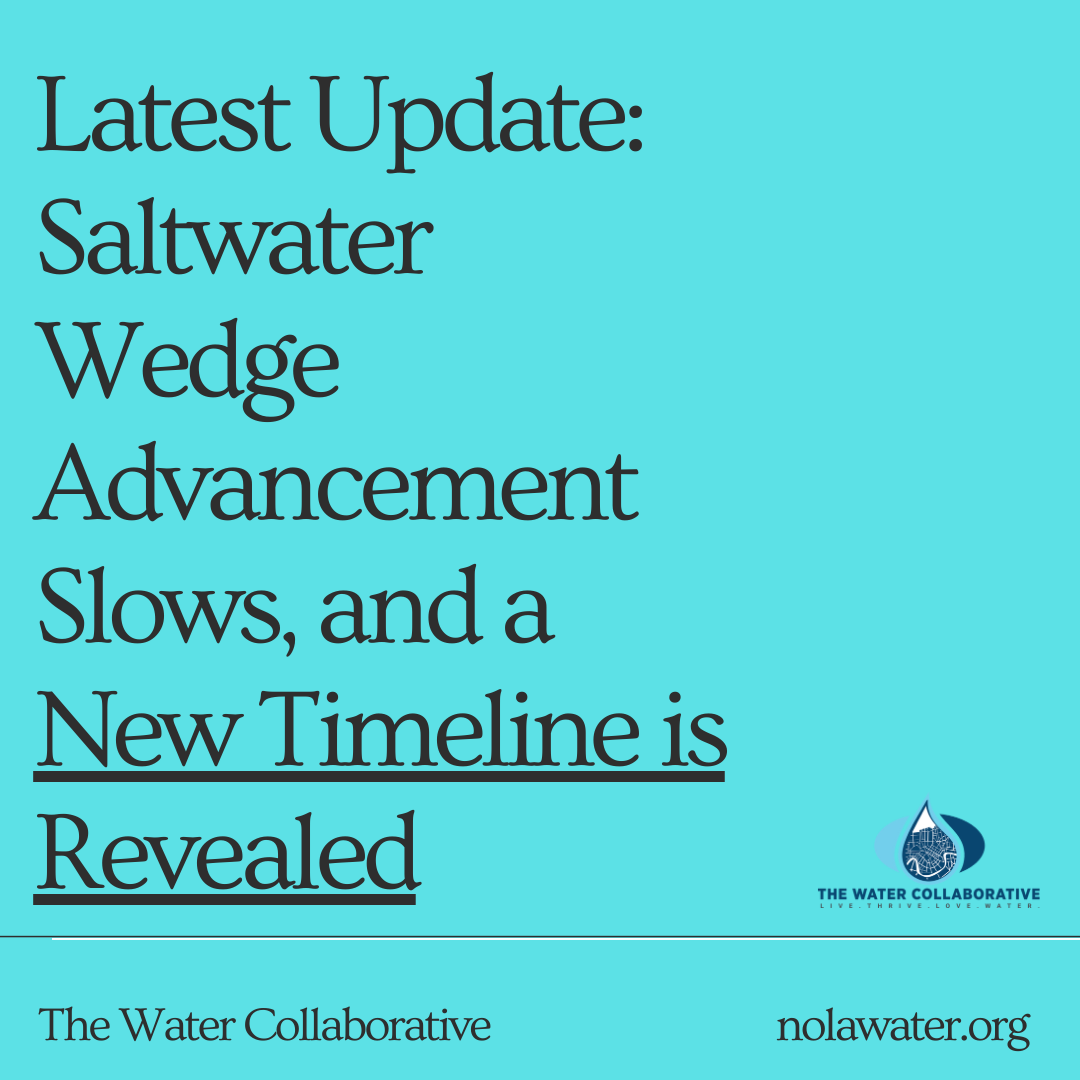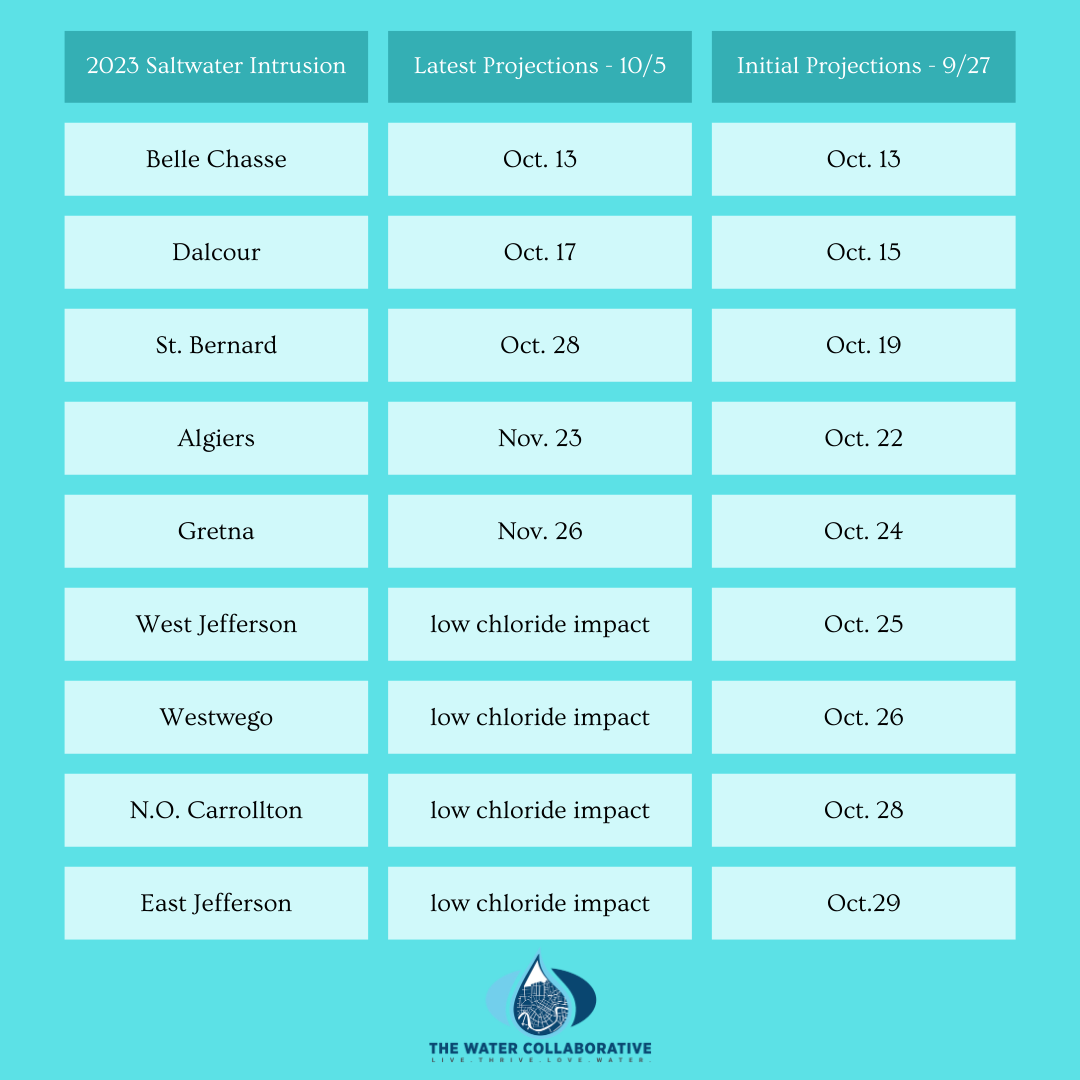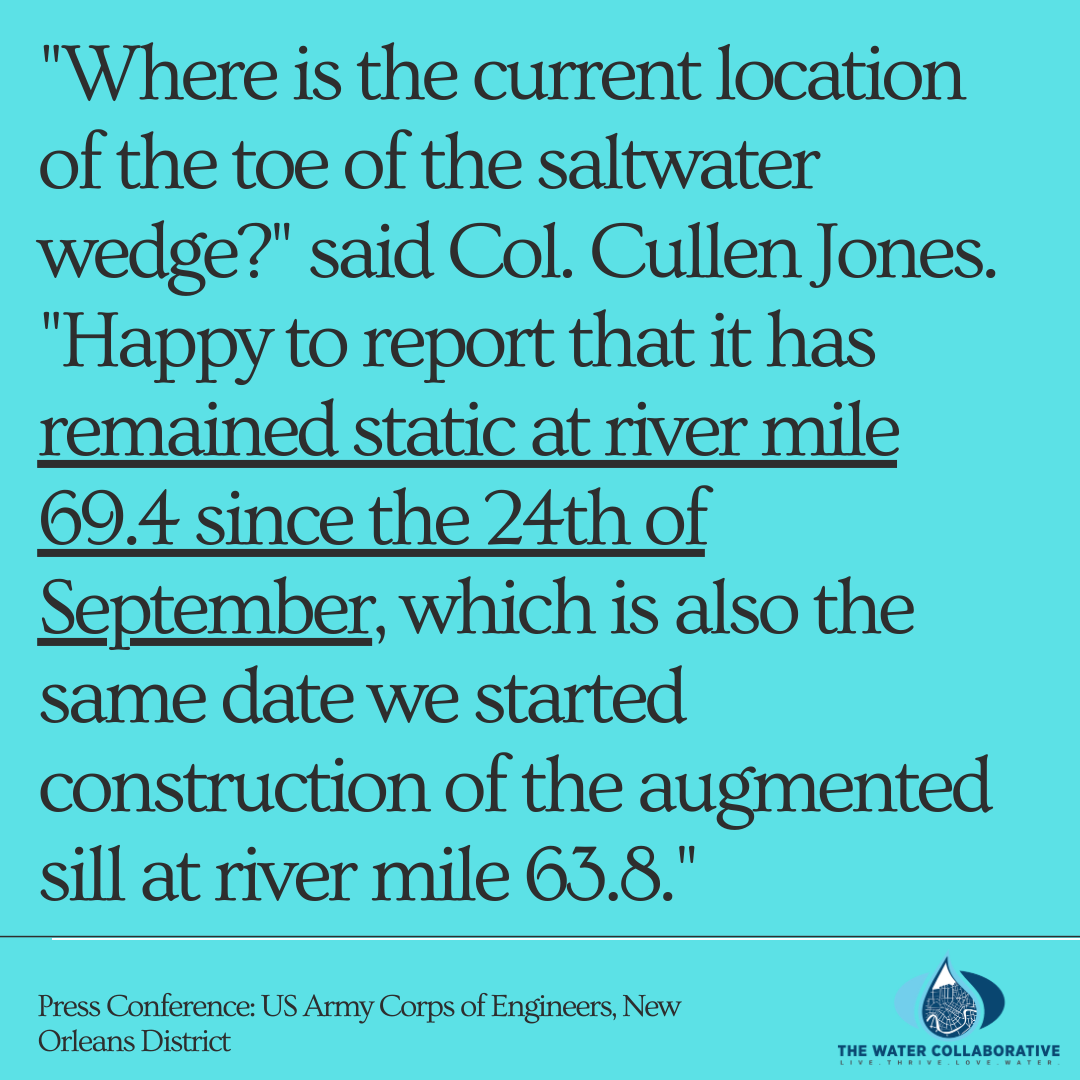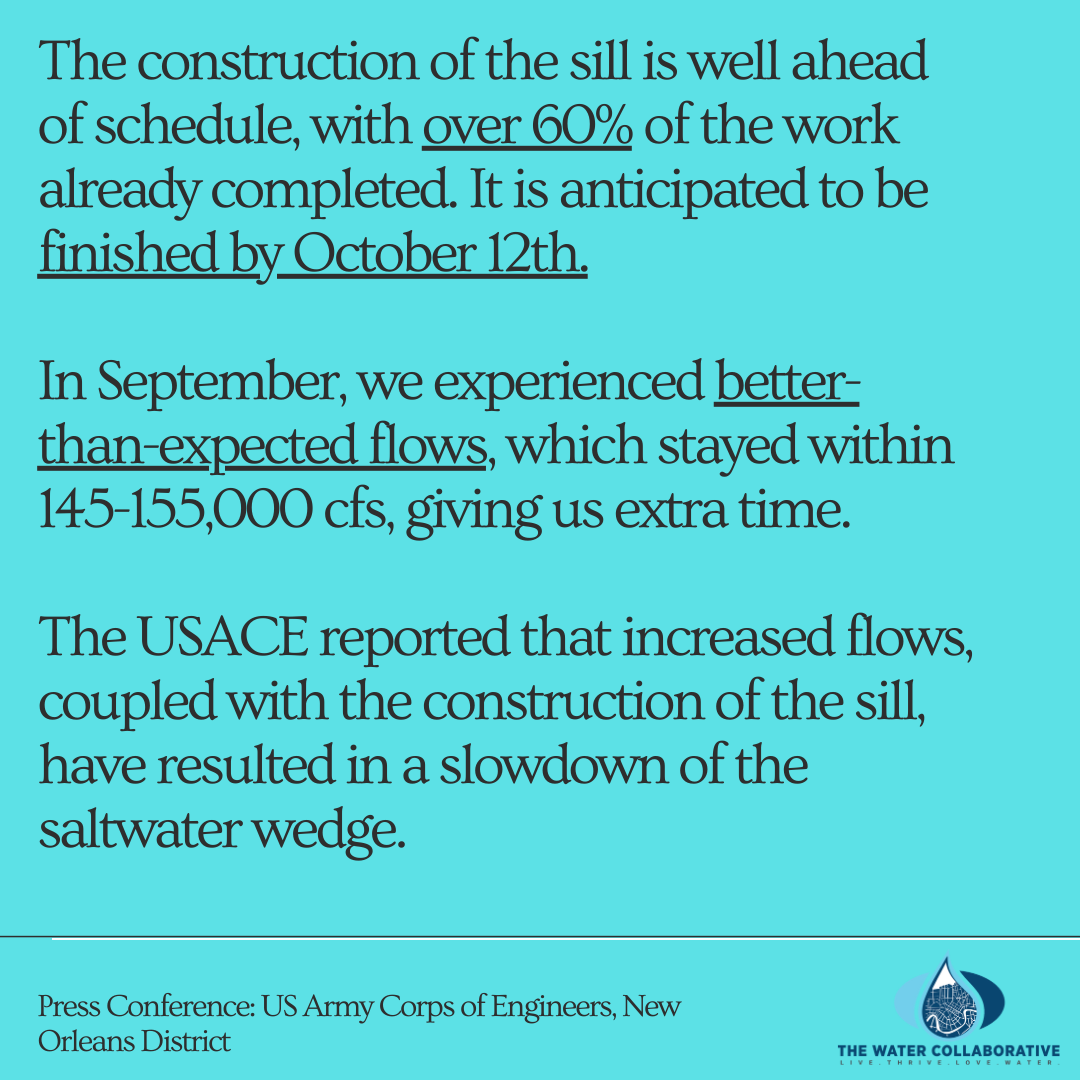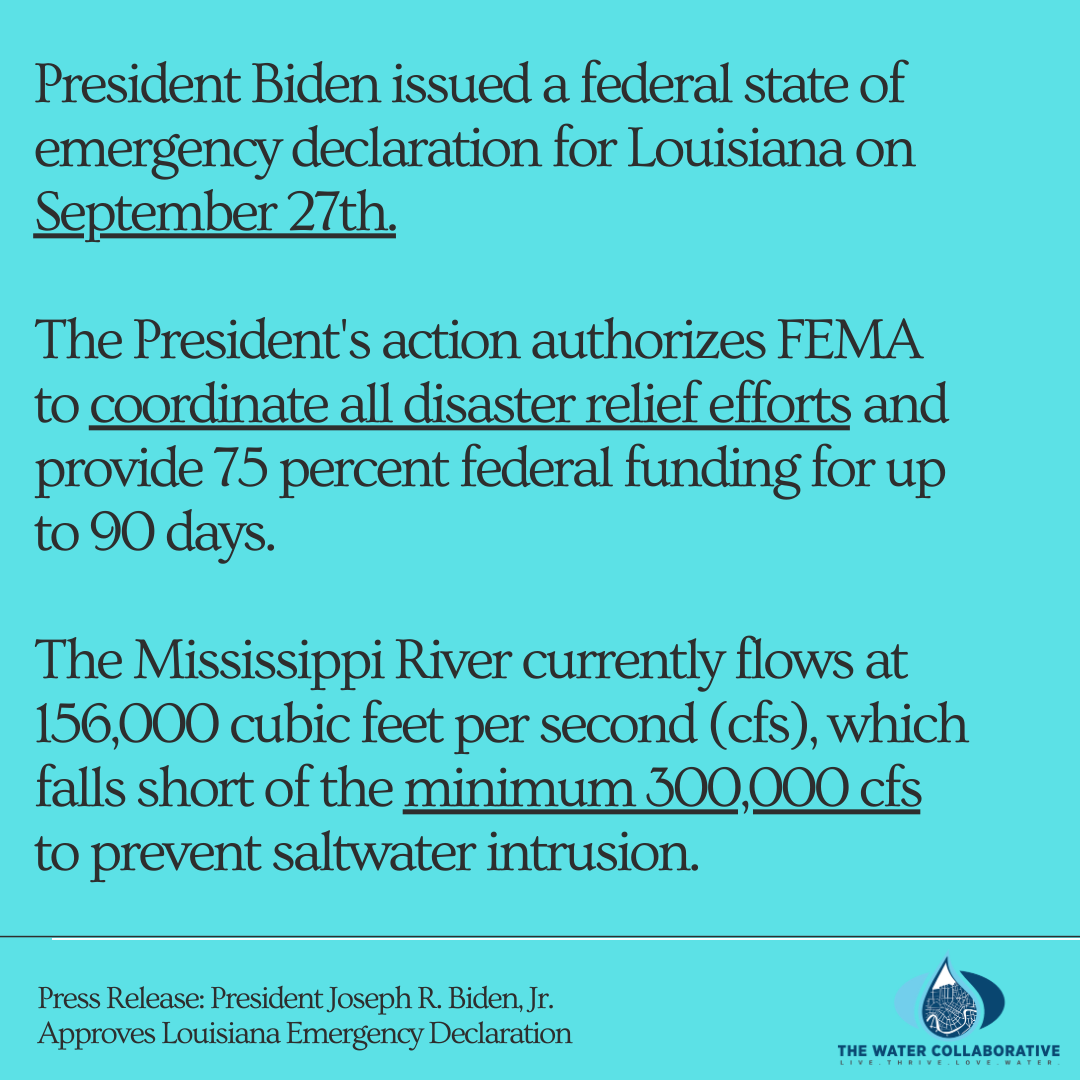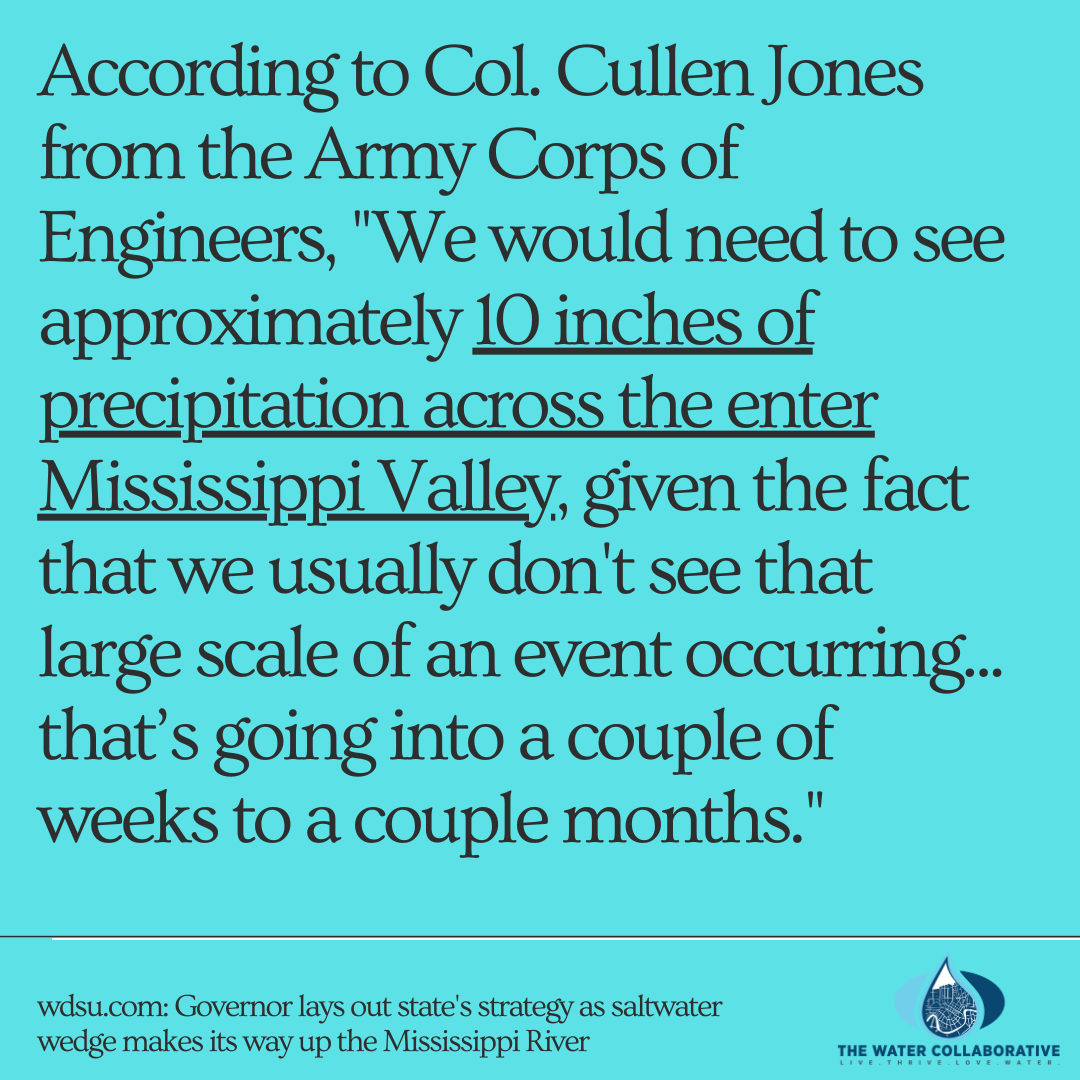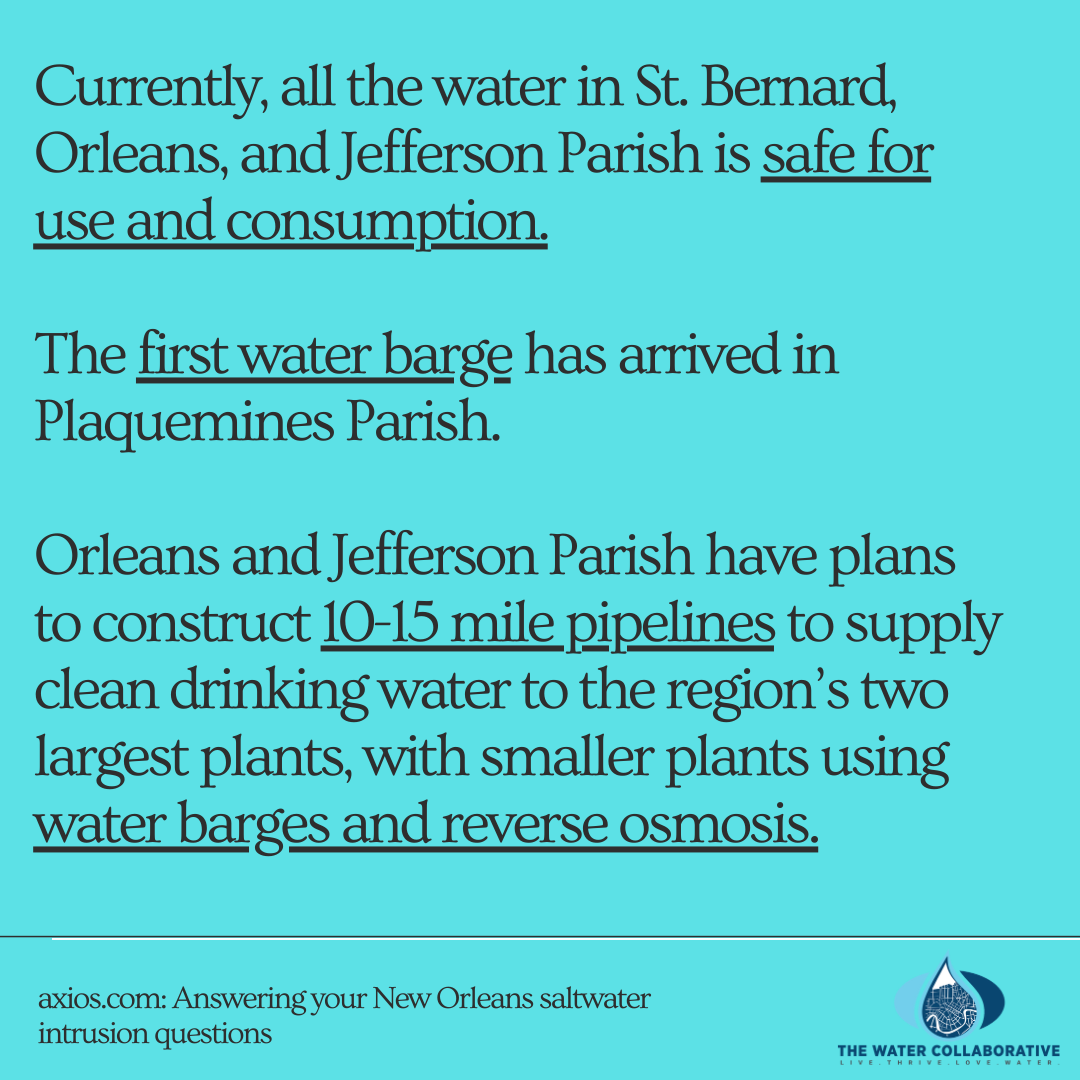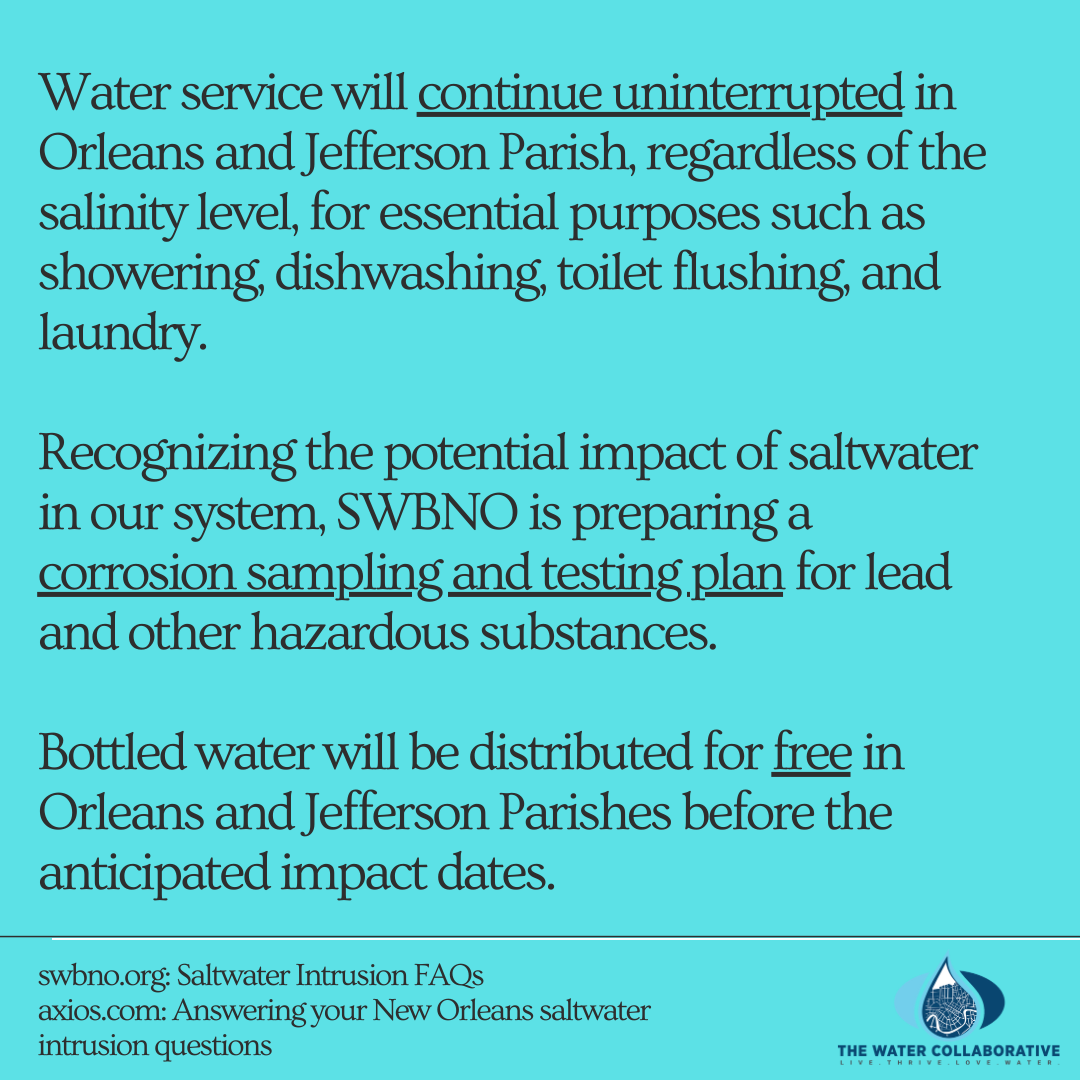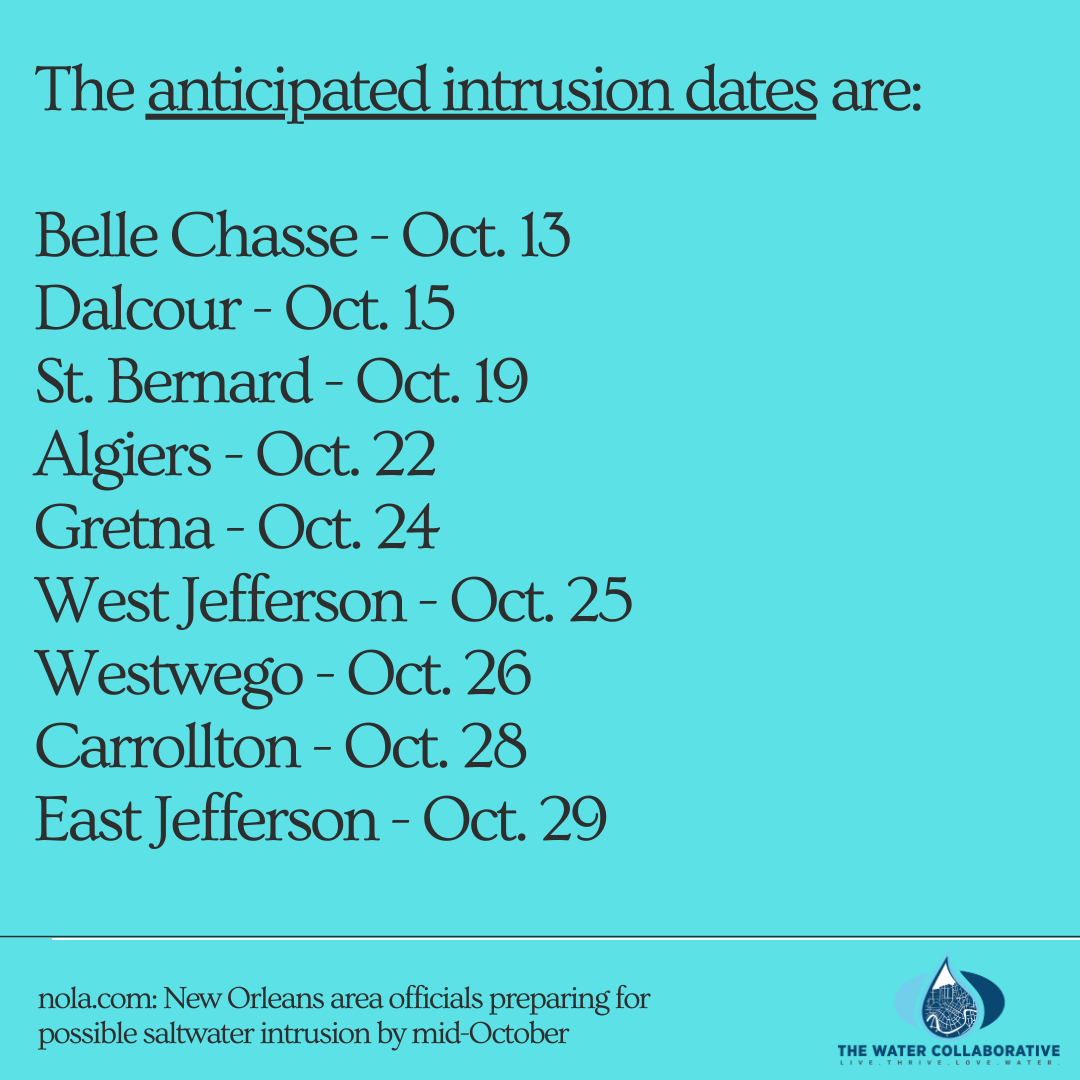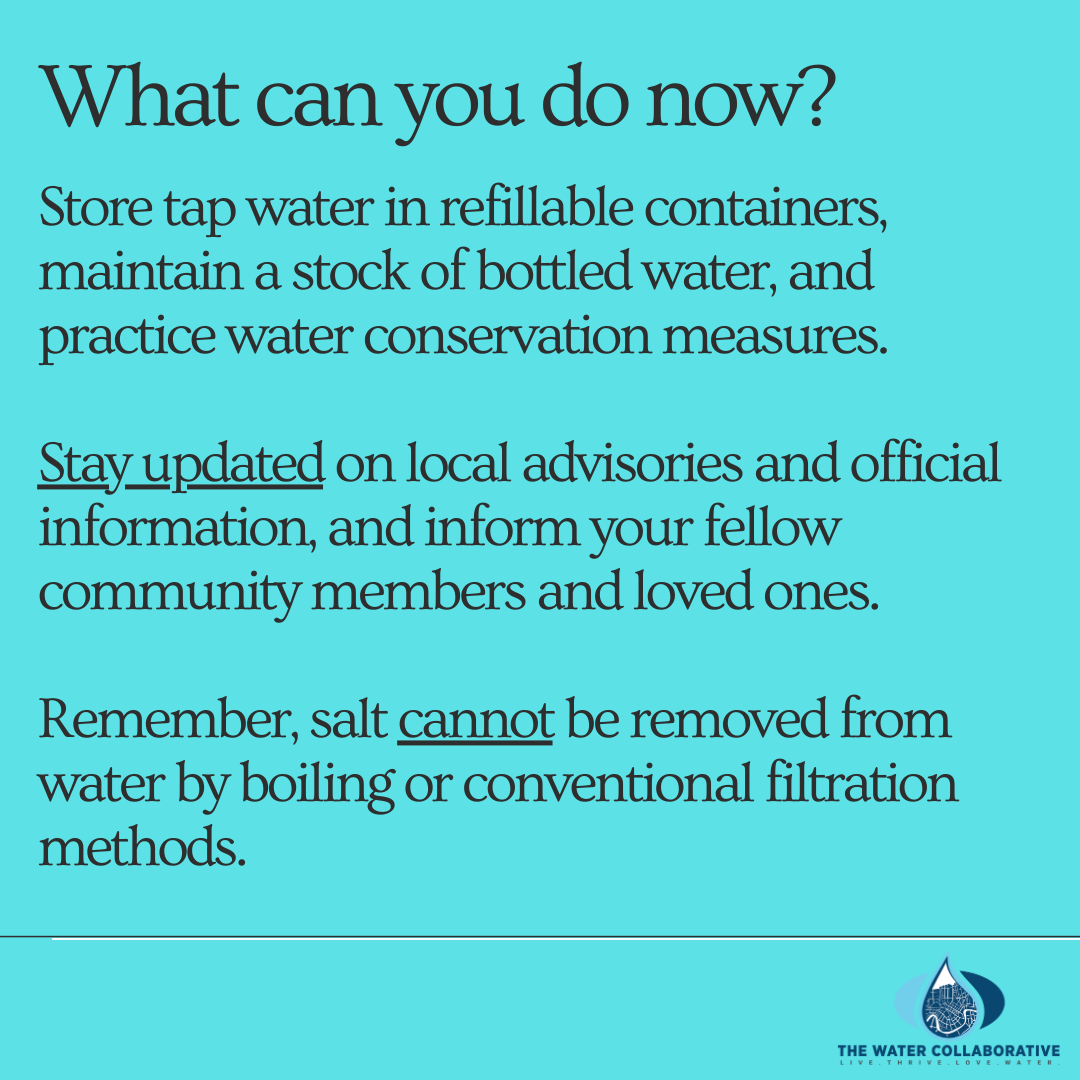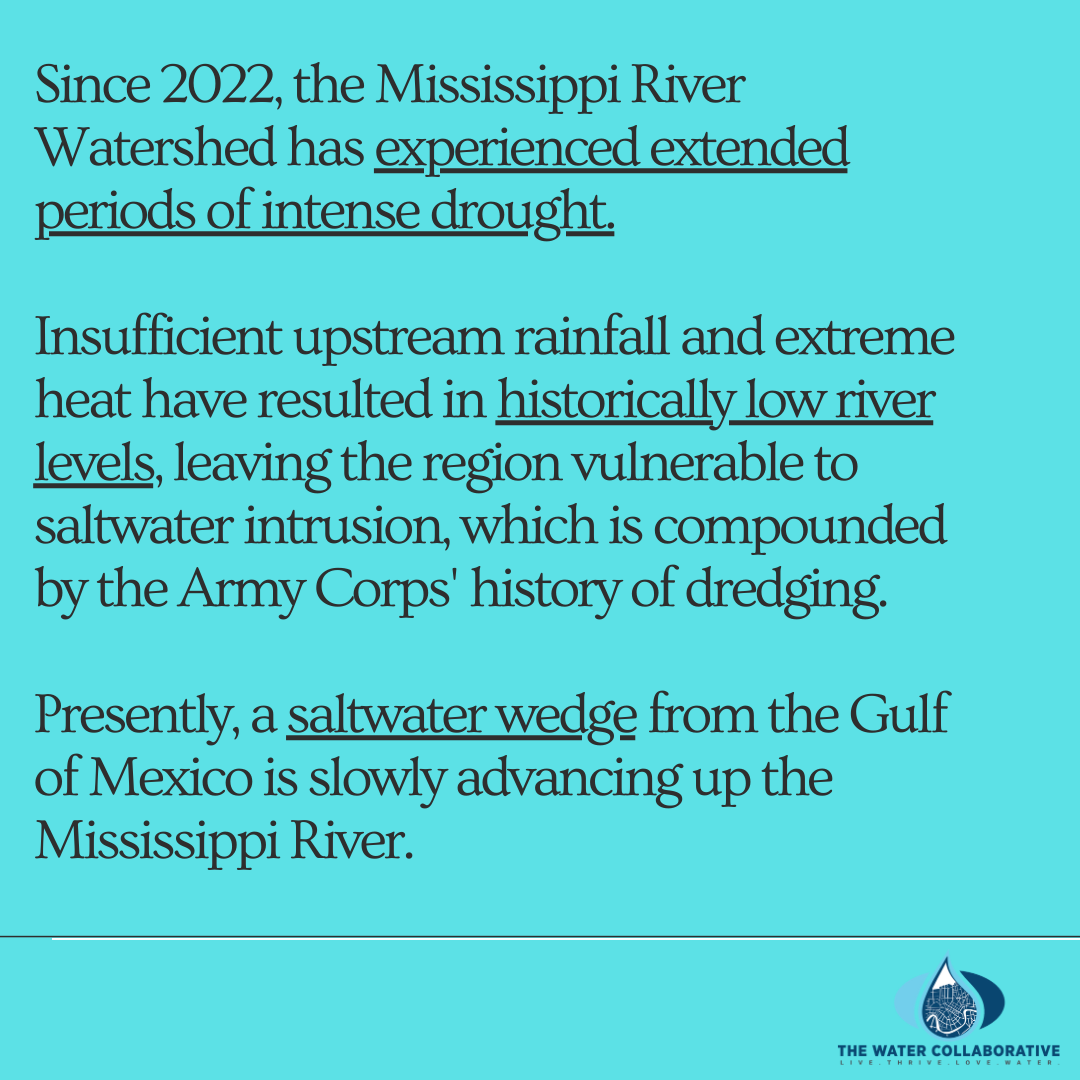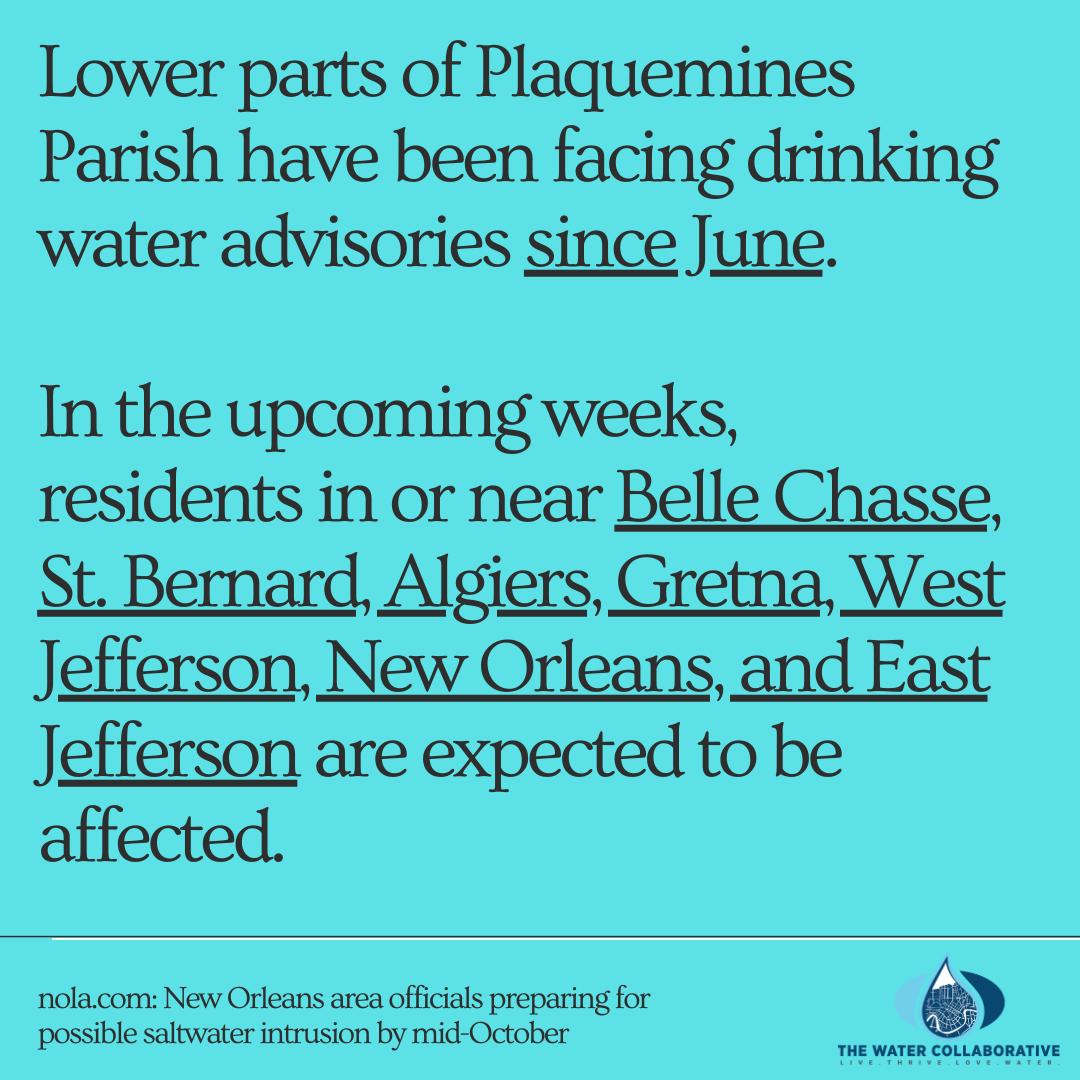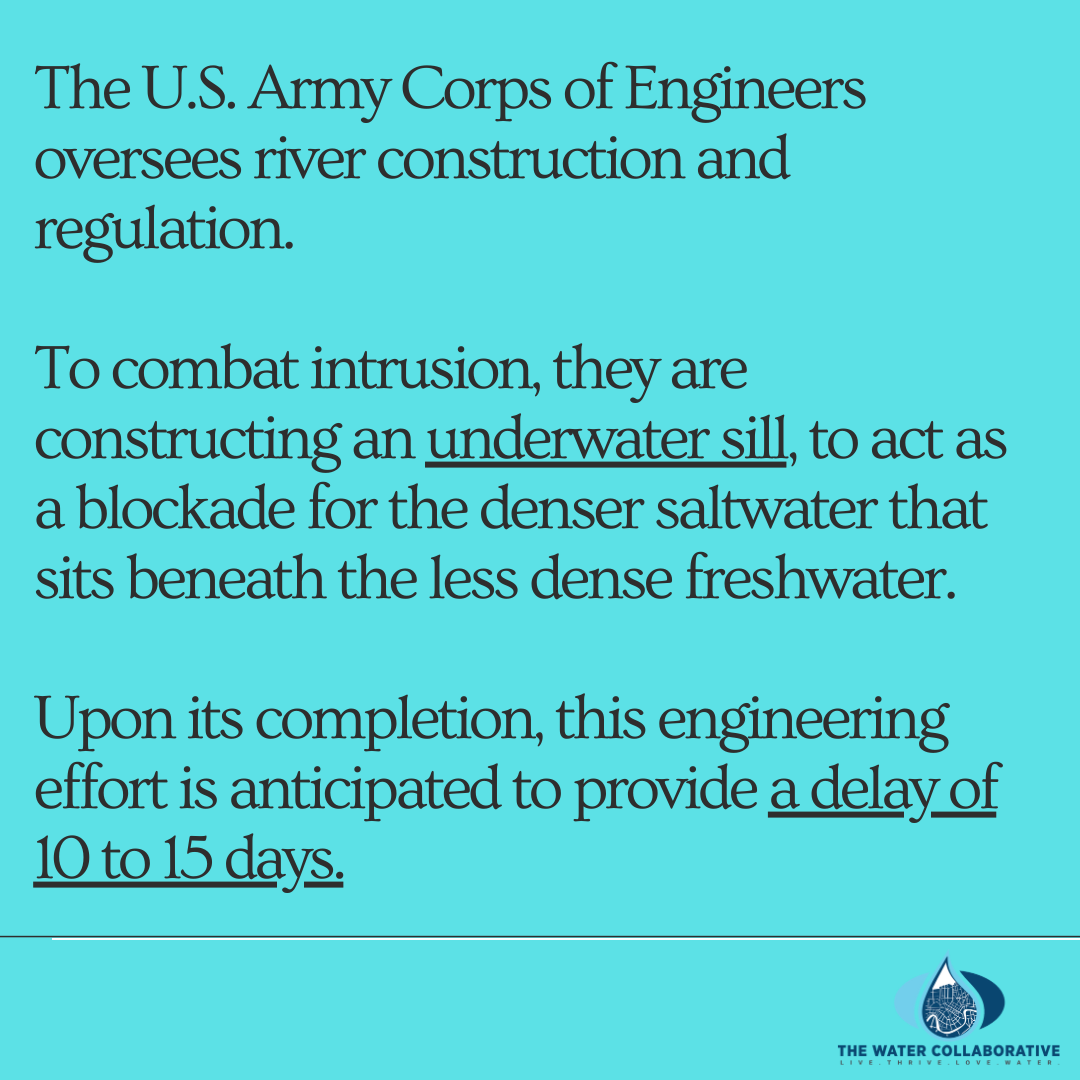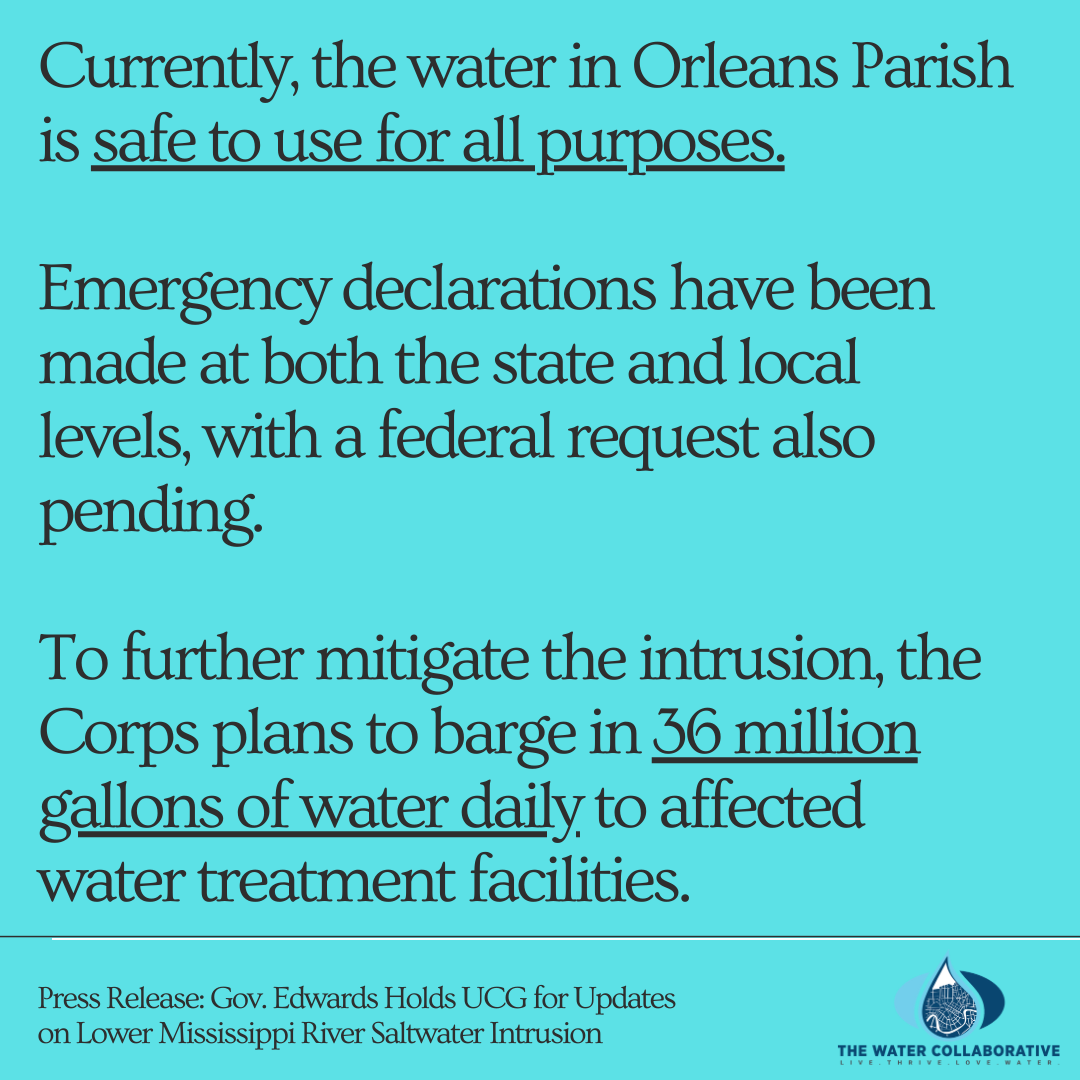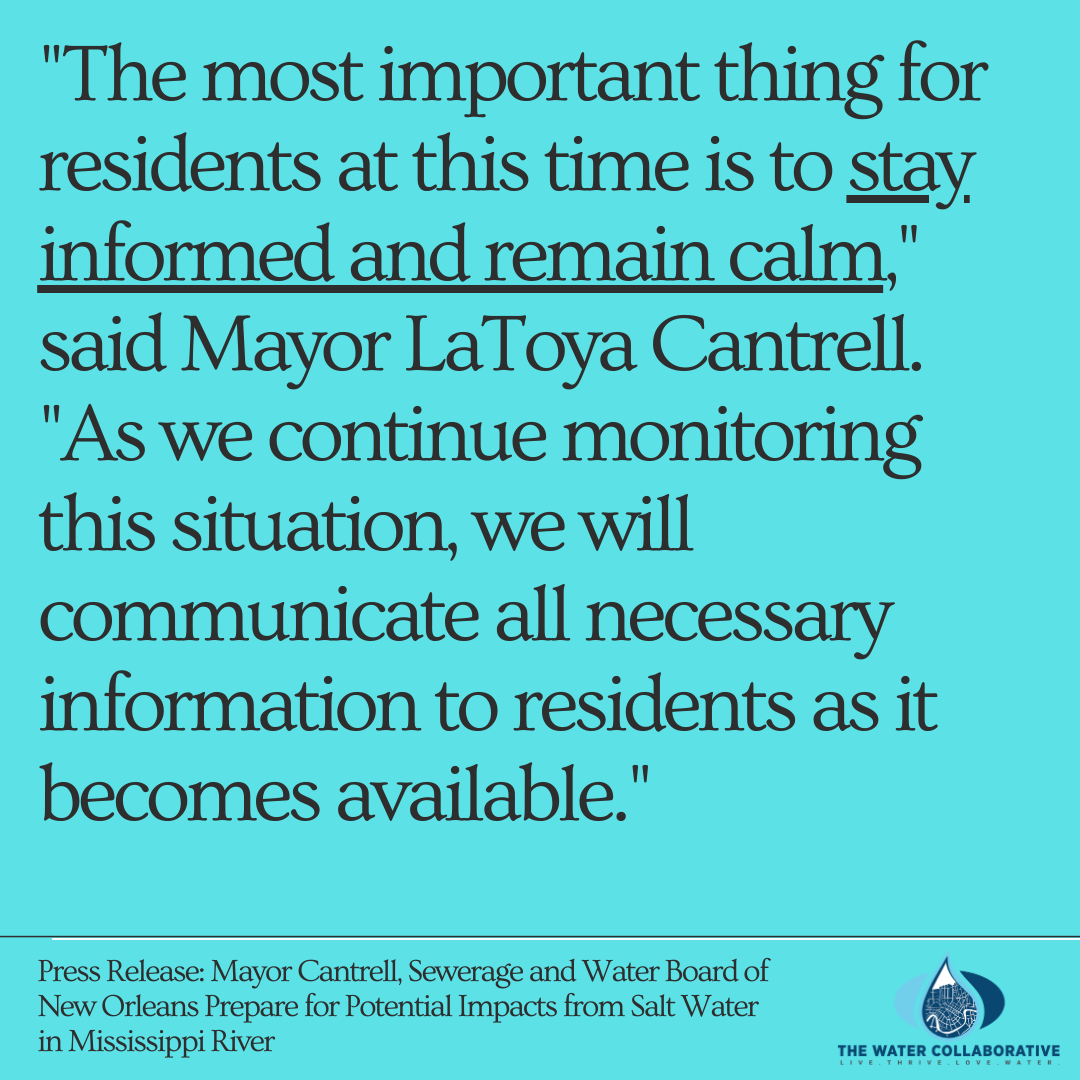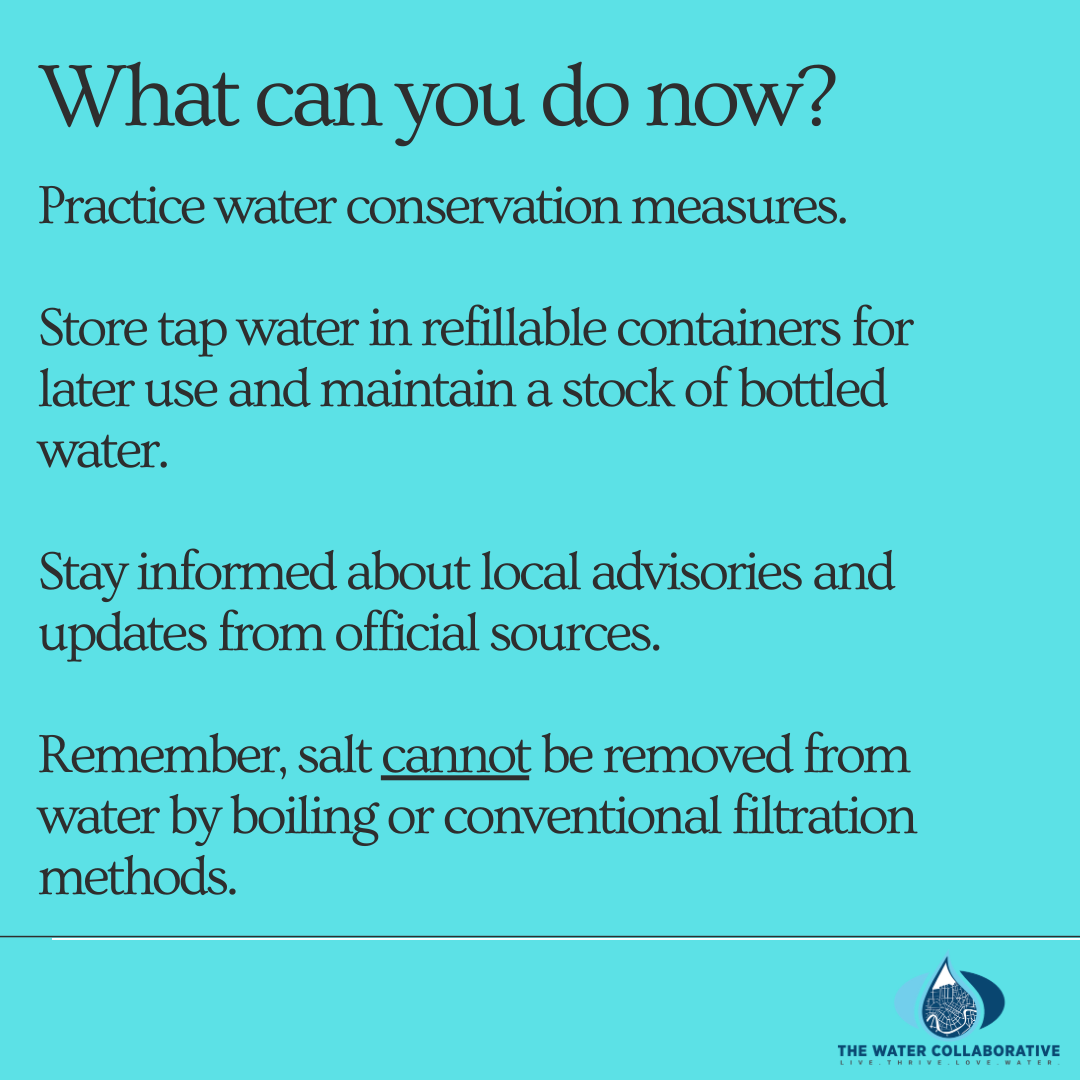2023 Saltwater Intrusion Updates
By: Taya Fontenette, Policy and Research Coordinator
In 2023, a severe drought in the Central US caused water levels along the Mississippi River to drop to near-record lows, significantly impacting Southeast Louisiana residents who rely on the river for their drinking water. The river's flow rate dropped to about 150,000 cubic feet per second, only half the rate necessary to prevent saltwater intrusion from the Gulf of Mexico. While the Mississippi River typically acts as a natural saltwater barrier, a combination of extreme heat, minimal rainfall, and exceptional drought conditions disrupted this balance, enabling the denser saltwater wedge to advance upstream.
To address this threat, the U.S. Army Corps of Engineers (USACE) implemented a range of protective measures, including constructing a 50-foot underwater sill at river mile 65 in Plaquemines Parish and barging in over 100 million gallons of water to dilute the drinking water for affected communities.
This intrusion event was not only a consequence of severe weather conditions but also decades of extensive dredging activities along the lower Mississippi River, primarily aimed at facilitating commerce and trade. These activities altered the river's natural dynamics, exacerbating the impact of the drought.
Lasting for 209 days, the event highlighted the vulnerability of freshwater resources in the region and underscored the urgent need to implement nature-based solutions to improve river management.
Below are the weekly updates provided by USACE from September 2023 to January 2024.
CNN: Original inundation predictions as of Sept ‘23
All projected saltwater timelines released by the New Orleans District of the USACE.
January 25
The U.S. Army Corps of Engineers has released their final weekly press release for the saltwater wedge.
No municipal water treatment facilities along the Mississippi River are expected to experience chloride levels above 250 parts per million.
On Jan. 22, the saltwater wedge was last measured at river mile 11, having retreated more than 50 miles from its furthest measurement.
In addition to the construction of the underwater sill, the USACE also barged 153 million gallons of water and deployed four reverse osmosis water purification units to impacted water treatment facilities.
January 11 + 18
The U.S. Army Corps of Engineers has released their weekly saltwater press releases for the 11th and 18th.
Chloride levels in Boothville are expected to remain above 250 parts per million through the current 28-day forecast.
The river flows remain above 150,000 cubic feet per second. The toe of the saltwater wedge was last measured at river mile 44.7, retreating 16 miles.
The upper river utilities will remain unaffected.
January 4
The U.S. Army Corps of Engineers has released their weekly saltwater forecast.
Chloride levels in Boothville are expected to remain above 250 parts per million through the current 28-day forecast.
Port Sulphur and Pointe A La Hache are not anticipated to experience chloride levels exceeding 250 parts per million.
The toe of the saltwater wedge was last measured at river mile 63.3 due to favorable river flows.
November 30 + December 28
The U.S. Army Corps of Engineers has released their weekly saltwater press releases.
Chloride levels in Boothville, Port Sulphur, and Pointe A La Hache are expected to remain above 250 parts per million through the current 28-day forecast.
The toe of the saltwater wedge was measured at river mile 63.7 on November 22nd and now remains at river mile 63.5 due to favorable river flows.
The upper river parishes will remain unaffected.
To date, the USACE has delivered over 132 million gallons of water to Plaquemines Parish, and the utilities are also utilizing reverse osmosis machines.
November 16
The U.S. Army Corps of Engineers has released their weekly saltwater forecast.
Chloride levels in Boothville, Port Sulphur, and Pointe A La Hache are expected to remain above 250 parts per million through the current 28-day forecast. The toe of the saltwater wedge was last measured at river mile 63.2 on November 13th, retreating an additional 2.4 miles.
To date, the USACE has delivered over 76 million gallons of water to Plaquemines Parish, and the utilities are utilizing reverse osmosis machines.
The upper river parishes will remain unaffected.
November 9
The U.S. Army Corps of Engineers has released their weekly saltwater forecast.
Chloride levels in Boothville, Port Sulphur, and Pointe A La Hache are expected to remain above 250 parts per million through the current 28-day forecast. The toe of the saltwater wedge was last measured at river mile 65.6 on November 6th, retreating 2.7 miles.
To date, the USACE has delivered over 66 million gallons of water to the affected areas, and the utilities now boast reverse osmosis machines. Despite these efforts, residents still harbor concerns about the safety of their drinking water, expressing their desire for permanent solutions.
November 2
The U.S. Army Corps of Engineers has issued a new saltwater wedge forecast and infographic.
The latest forecast indicates that Belle Chasse is no longer expected to experience chloride levels exceeding 250 ppm, while chloride levels in Boothville, Port Sulphur, and Pointe A La Hache are expected to remain elevated throughout the 28-day forecast.
The toe of the saltwater wedge was last measured at river mile 68.3 on October 30th, advancing an additional 2.5 miles.
To date, USACE has delivered more than 52 million gallons of water to Plaquemines Parish.
Jefferson Parish has successfully laid and tested 15-miles of flexible pipelines to transport freshwater from north of Kenner to their West Bank Water Treatment Plant. The Marrero plant, which treats 24 million gallons of water a day, is currently receiving a full water supply from the pipelines. The pipelines will remain online until the Army Corps provides the all-clear.
Orleans Parish is proceeding with plans to construct a cofferdam at the Algiers water treatment plant to blend water and maintain proper salinity levels. The city has received bids, and identified a contractor and has until December to accept the offer. The project is expected to cost $20 million and can be completed in 30 days or less.
October 26
The U.S. Army Corps of Engineers has issued a new saltwater wedge forecast and infographic.
The latest forecast indicates further delayed impacts in Belle Chasse. Dalcour is no longer expected to experience chloride levels exceeding 250 ppm.
The toe of the saltwater wedge is at river mile 65.8, advancing 2 miles.
To date, USACE has delivered more than 37.8 million gallons of water to Plaquemines Parish.
October 19
The U.S. Army Corps of Engineers issued a new saltwater wedge forecast in a press release.
The latest forecast indicates delayed impacts in Belle Chasse and Dalcour. St. Bernard is no longer expected to experience chloride levels exceeding 250 ppm.
The toe of the saltwater wedge has remained at river mile 63.9 at the underwater sill since October 9th.
To date, USACE has delivered more than 23 million gallons of water to Port Sulphur and Pointe A La Hache.
October 12
The U.S. Army Corps of Engineers issued a new saltwater wedge forecast in a press release.
The latest forecast indicates delayed impacts upriver in Belle Chasse, Dalcour, and St. Bernard. New Orleans Algiers is no longer expected to exceed 250 ppm chloride levels. No changes are expected for Boothville, Port Sulphur, and Pointe A La Hache.
SWBNO will proceed with their blending plans for the Algiers intakes to prepare for higher-than-typical salinity levels. Based on the forecast, the utility is confident the salinity near the Carrollton intakes will remain within the typical range (20-60 ppm).
October 10
Sewerage and Water Board provided the latest updates on saltwater intrusion at the City Council’s Joint Governmental Affairs-Public Works Meeting. The Corps will unveil their updated timeline on Thursday, October 12th.
The toe of the saltwater wedge currently stands at river mile 63.9, retreating downstream by 5.5 miles.
October 5
The Army Corps of Engineers held a press conference to provide a new projected timeline.
They announced the slowing of the saltwater wedge due to the effectiveness of the sill and preferable river flows.
In September, we experienced better-than-expected flows, which stayed within 145-155,000 cfs, giving us extra time. Over the next 28 days, the forecast indicates a range of 150-133,000 cfs.
They have launched their Saltwater Dashboard to provide real-time updates, salinity data, and valuable resources along with a press release.
WESTBANK: Coordinating with the USACE to barge in 14 million gallons of fresh water daily to blend with the salty river water.
EASTBANK: SWBNO has team on standby to deliver pipeline with 30 days should the timeline shift.
PLAQUEMINES: SWBNO is coordinating with Plaquemines Parish to supply water from Algiers Water Treatment Plant.
ST. BERNARD: Support efforts are ongoing with St. Bernard Parish as they investigate options.
Jefferson Parish received approval from the Army Corps of Engineers to start construction on the first three miles of their west bank pipeline on October 4th and will lay the first 7 miles of the pipeline.
October 3
The first water barge arrived in Plaquemines Parish on Sunday, October 1.
Orleans and Jefferson Parish have separate plans to construct pipelines to supply clean drinking water to the region’s two largest plants, with smaller plants using water barges and reverse osmosis machines.
Water service will continue uninterrupted in Orleans and Jefferson Parish, regardless of the salinity level, for essential purposes such as showering, dishwashing, toilet flushing, and laundry.
September 27
In today’s City Council Public Works Committee meeting, representatives from the Sewerage and Water Board and the U.S. Army Corps of Engineers addressed the pressing issue of saltwater intrusion into Southeast Louisiana's water supply. Here are the key takeaways from their presentations:
A federal Emergency Declaration has been declared, with a funding request ranging from $100-250 million. FEMA has been tasked with coordinating disaster relief efforts to address the crisis and provide 75% federal funding for up to 90 days.
The Mississippi River is currently flowing at only 150,000 cubic feet per second (cfs), far below the necessary 300,000 cfs to prevent saltwater intrusion. Rainfall in the upper Mississippi is the sole hope for mitigation.
Saltwater intrusion has become increasingly frequent, with notable occurrences in 1988, 2012, 2022, and most recently, just eight months later in 2023.
To prevent further intrusion, the U.S. Army Corps of Engineers is exploring multiple solutions including the installation of 10-12 miles of piping to source water from north of Kenner to the critical Carrollton and East Jefferson water treatment plants. A comprehensive 5-year study initiated in June 2023 aims to find a lasting solution to saltwater intrusion while considering all river uses.
Efforts are also focused on equitable water distribution and corrosion control, with plans to develop a corrosion sampling and notification plan.
For Orleans Parish updates, visit ready.nola.gov and swbno.org.
Sign up for the latest emergency alerts by texting NOLAREADY to 77295.
For statewide updates, visit emergency.la.gov.

